Étiquette : stanza
Raphael 1520-2020: What Humanity can learn from « The School of Athens »

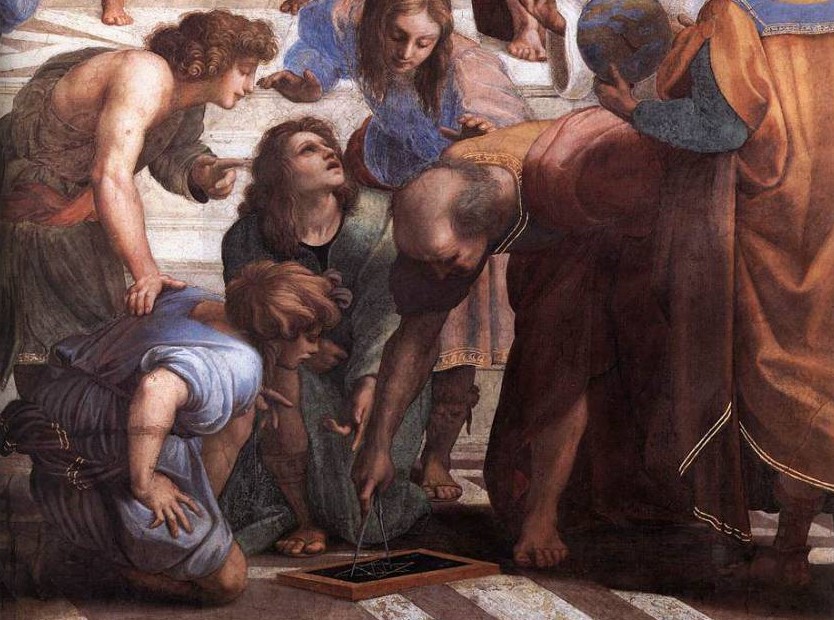
On the occasion of the five-hundredth anniversary of the death of the Italian painter Raffaello Sanzio da Urbino (1483-1520), several exhibitions are honoring this artist, notably in Rome, Milan, Urbino, Belgrade, Washington, Pasadena, London, and Chantilly in France.
The master is honored, but what do we really know about the intention and meaning of his work?
Introduction
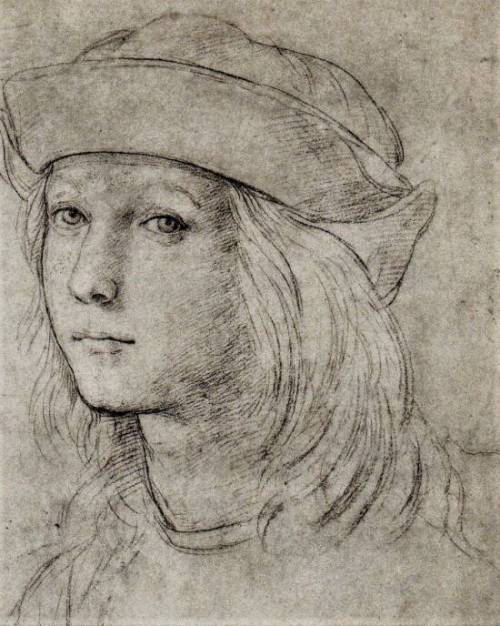
There is no doubt that in the collective mind of the West, Raphael, along with Michelangelo and Leonardo da Vinci, appears as one of the most brilliant artists and even as the best embodiment of the « Italian Renaissance”.
Although he died at the age of 37, Raphael was able to reveal his immense talent to the world, in particular by giving birth, between 1509 and 1511, to several monumental frescoes in the Vatican, the most famous of which, 7.7 meters long and 5 meters high, is known as The School of Athens.
The viewer finds himself inside a building that brings together the thoughts of all mankind: united in a timeless space, fifty philosophers, mathematicians and astronomers of all ages meet to discuss their vision of man and nature.
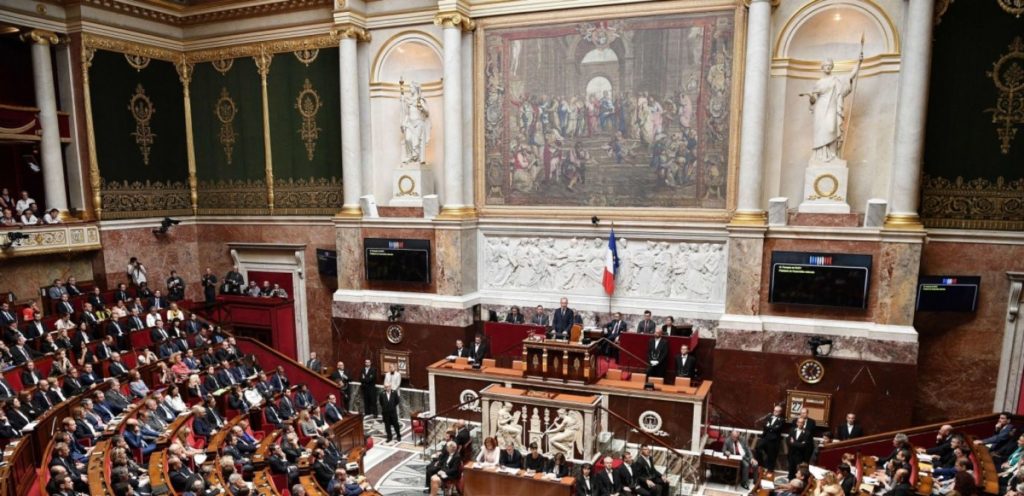
The image of this fresco embodies so powerfully the « ideal » of a democratic republic, that in France, during the February 1848 revolution, the painting representing Louis Philippe (till then hanging behind the President of the National Assembly) was taken down and replaced by a representation of Raphael’s fresco, in the form of a tapestry from the Manufacture des Gobelins, produced between 1683 and 1688 at the request of Jean-Baptiste Colbert, the founder of the French Academy of Sciences.
Then, in France, arrived the idea that Raphael, being « the Prince of painters », embodied « the ultimate artist ». Superior to Rubens or Titian, Raphael was thought to have achieved the subtle « synthesis » between the « divine grace » of a Leonardo da Vinci and the « silent strength » of a Michelangelo. What more can be said ? A true observation as long as one looks only at the purity of the « forms » and thus of the « style ». Adored or hated, Raphael was erected in France as a model to be imitated by every young talent attending our Academies of Fine Arts.
Hence, for five centuries, artists, historians and connoisseurs have not ceased to comment and often to confront each other, not on the intention or the meaning of the artist’s works, but on his style! In a way akin to some of our contemporaries who adore Star Wars and its special effects without paying attention to the ideology that, underhandedly, this TV series conveys…
For this brand of historians, « iconography », that branch of art history which is interested in the subjects represented, in the possible interpretations of the compositions or particular details, is only really useful to appreciate the « more primitive » paintings, that is to say that of the « Northern Schools »…
One knows well, especially in France, that once the « form » takes the appearance of perfection, it does not matter what the content is! This or that writer tells abject horrors, but « it is so well written! »
The good news is that in the last twenty years or so, a handful of leading historians and especially female art historians, have undertaken and published in depth new research.
I am thanking in particular of Marcia Hall (Temple University), Ingrid D. Rowland (University of Chicago), Reverend Timothy Verdon (Florence and Stanford), Jesuit historian John William O’Malley, and especially Christiane L. Joost-Gaugier.
The latter’s book Raphael’s Stanza della Signatura, Meaning and Invention (Cambridge University Press, 2002), which I was able to read (thanks to the pandemic lockdown), allowed me to adjust some of the leads and intuitions I had summarized in 2000 in, let’s be honest, a rather messy note.
If my work had consisted in trying to give some coherence to what is in the public domain, through their assiduous archival work in the Vatican and elsewhere, these historians, for whom neither Latin nor Greek have any secrets, have largely contributed to shed new light on the political, philosophical, cultural and religious context that contributed to the genesis of Raphael’s work.
Enriched by these readings, I have tried here, in a methodical way, to « make readable » what is rightly considered Raphael’s major work, The School of Athens.
Instead of identifying and commenting from the outset on the figures we see in the Stanza della Segnatura (« Room of the Segnatura” of the Vatican in Rome), I have chosen first to sketch a few backgrounds that serve as “eye-openers” to penetrate this work. For, in order to detect the painter’s intentions, actions and feelings, it is essential to penetrate the spirit of the epoch that engendered the artist’s: those days political and economic challenges, the cultural heritage of Rome and the Church, a close-up on the pope who commissioned the work, the philosophical convictions of the advisors who dictated the theme of the work, etc.
However, if all this seems too tedious for you dear reader, or if you are just eager to familiarize yourself with the work, nothing prevents you from going back and forth between the deciphering of the frescoes at the end of this article (Guided visit) and the contextualization that precedes them.
Cleaning our eyeglasses

To see the world as it is, let’s wipe our glasses and stop looking at the tint of our glasses. For as is often the case, what « prevents » the viewer from penetrating a work, from seeing its intention and meaning, is not what his eyes see as such, but the preconceived ideas that prevents him from looking at the outside world. Learning to see usually starts by challenging some of our preconceptions.
1. It’s not a easel painting! Since the 16th century, we Europeans have been thinking in terms of « easel paintings » (as opposed to mural). The artist paints on a support, a wooden panel or a canvas, which the client then hangs on the wall. However, The School of Athens, as such, is not a « painting » of this type, but simply, in the strict sense, a part or a « detail » of what we would call today, « an installation ». I explain myself. What constitutes the work here is the whole of the frescoes and decorations covering the ceiling, the floor and the four walls of the room! We will explain them to you. The viewer is, in a way, inside a cube that the artist has tried to make appear as a sphere. So, to « explain » the meaning of The School of Athens, in isolation from the rest and without demonstrating the thematic and symbolic interconnections with the iconography of the other walls, the ceiling and the floor, is not only an exercise in futility but utter incompetence.
2. Error of title! Neither at the time of its commission, nor at the time of its realization or in the words of Raphael, the fresco carried the name “School of Athens”! That name was given later. Everything indicates that the entire room covered with frescoes was to express a divine harmony uniting Philosophy (The School of Athens), Theology (on the opposite side), Poetry (on its right side) and Justice (on its left side). We will come back to that.
3. The theme is not the artist’s choice! The only person who met both Raphael and Pope Julius II during his lifetime was the physician Paolo Giovio (1483-1552) who arrived in Rome in 1512, a year before the death of Julius II. According to Giovio, it was the pontiff himself who, as early as 1506, that is, two years before Raphael’s arrival, conceived the contents of the « Signing Chamber ». This is logical, since it was the place where he installed his personal library, a collection of some 270 books, arranged on shelves below the frescoes and classified according to the themes of each wall decoration (Philosophy, Theology, Poetry and Justice). However, given the complexity of the themes, and given Julius II’s poor literary culture, historians agree that the intellectual authorship of the frescoes was attributed to the pope’s advisors and especially to the one who would have been able to synthesize them, his chief librarian, Thomaso Inghirami (1470-1516).
Raphael, who seems to have constantly modified his preparatory drawings according to the feedback and comments he received from the commissioners, was able to translate this theme and program into images with his vast talent. In short, if you like the images, congratulate Raphael; if you like or don’t like the content, talk to the « boss ».
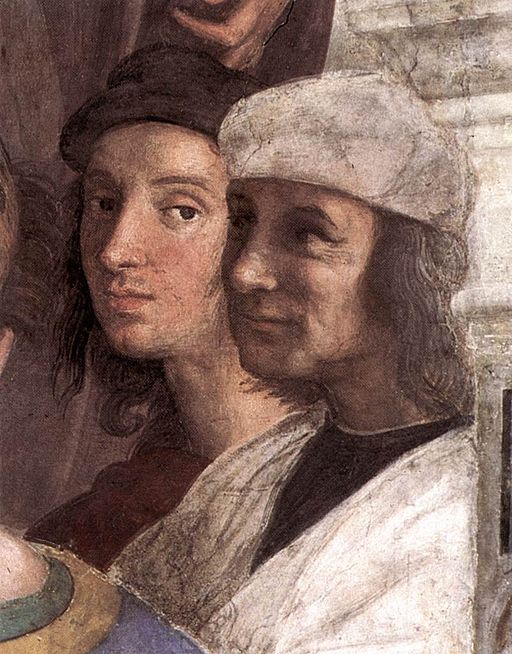
4. Painted by several people? What remains to be clarified is that, according to Vatican accounts, the entire decoration of the room was entrusted in mid-1508 to the talented fresco artist Giovanni Antonio Bazzi (1477-1549), six years older than Raphael and known as Il Sodoma. He appears to be the only person to have received any money for this work. Raphael does not appear in these accounts until 1513…
However, as the cycle of frescoes on the life of St. Benedict in the territorial abbey of Santa Maria in Monte Oliveto Maggiore testifies, Sodoma also had considerable talent, and above all, an incomparable know-how in fresco technique. Although he has never been honored, his style is so similar to Raphael’s that it is hard to mistake him.
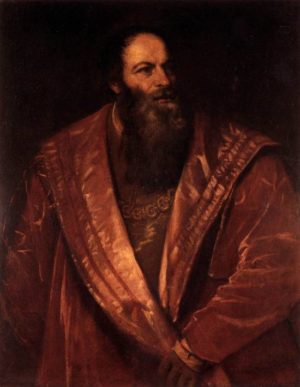
It should also be noted that Sodoma, who came to Rome at the request of the pope’s banker Agostino Chigi (1466-1520), was asked to decorate the latter’s villa in 1508, which would have given Raphael free rein in the Vatican before joining him on the same site.
According to the french historian Bernard Levergeois, the sulphurous Pietro Aretino (1495-1556), a pornographic pamphleteer, before becoming the protégé and « cultural agent » of the banker Chigi in Rome, spent many years in Perugia.
There he took interest in the young pupils of Pietro Perugino (c. 1448-1523), Raphael’s master, and, says Levergeois, it was there that he
met the most prestigious painters of the day: Raphael, Sebastiano del Piombo, Julius Romano, Giovanni da Udine, Giovan Francesco Penni and Sodoma, all of whom took turns decorating the magnificent villa (the Farnesina) that Chigi had built in Rome. Some of them also worked on the no less famous Villa Madam (for pope Julius II), a grandiose project that was never completed.
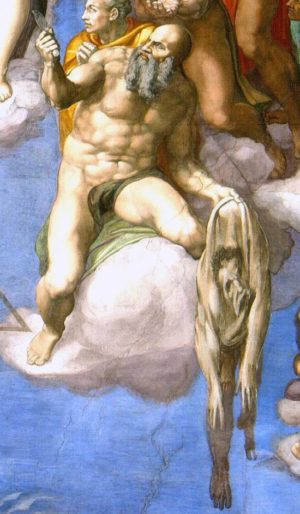
As seen in the portrait painted by Titian, Aretino, nicknamed « the scourge of Princes », was a powerful, possessive and tyrannical character. A blackmailer, a flamboyant pansexual and well-informed about what was going on in the alcoves of the elites, he worked himself up, like FBI boss Edgar Hoover in the Kennedy era, as a king-maker, a power above power. Historians report that both Raphael and Michelangelo, before showing their works to the public, felt compelled to seek the advice of this pervert Aretino.
And in the Sistine Chapel, Michelangelo depicts St. Bartolomeo in the guise of the Aretino. The artist must have thought that the traditional attribute of the martyr flayed alive was a perfect fit for the one who was bullying him: he is wearing the remains of his own skin and holding in his hand the large knife that was used for the torture…
It is therefore tempting to think that it was Aretino, the favorite of the Pope’s banker, and not necessarily Renaissance architect Donato Bramante, as is commonly accepted, who may have played the role of intermediary in bringing both Sodoma and Raphael to Rome in order to revive the glory of his patron and the oligarchy that held the Eternal City in contempt.
To my knowledge, Raphael, neither in his own letters nor in the statements reported by his entourage, would have commented on the theme and intention of his work. Strange modesty. Did he consider himself a simple « decorative painter »?
Finally, if Sodoma‘s participation in the realization of the School of Athens remains to be clarified, his portrait does appear. He is in the foreground on the far right, standing side by side to a rather sad Raphael (both on the side of the Aristotelians). A double signature?
This makes the question arise: Can one continue to speak of the frescoes as painted « by Raphael »? Are they not rather the frescoes of the four men team composed of Julius II, Inghirami, Sodoma and Raphael?
An unusual patron, « the warrior pope » Julius II
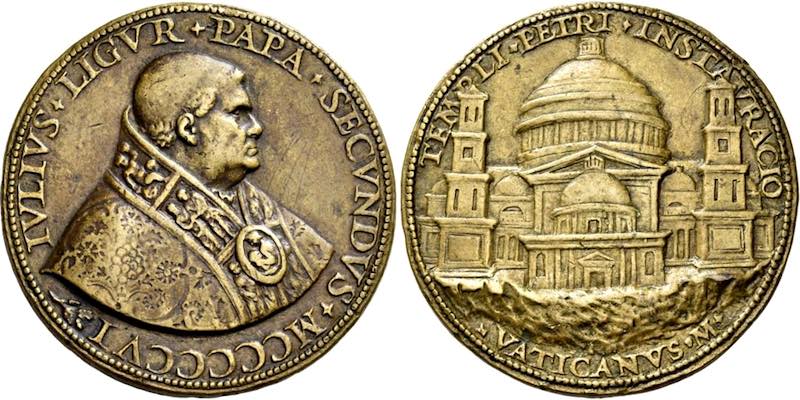
Before talking about these famous « impresarios of the Renaissance » and understanding their motivations, it is necessary to explore the character of future pope Julius II: Giuliano della Rovere (1443-1513). He was appointed bishop of Carpentras by Pope Sixtus IV, his uncle. He was also successively archbishop of Avignon and cardinal-bishop of Ostia.
On October 31, 1503, 37 of the 38 cardinals composing the Sacred College, make him the head of the Western Church, under the name of Julius II, until its death in 1513, a moment Giuliano had been waiting for 20 years.
Before him, others had made their way. In fact, in 1492, his personal enemy, the Spanish Rodrigo de Borgia (1431-1503), succeeded in getting himself elected as pope Alexander VI. True to the legendary corruption of the Borgia dynasty, he was one of the most corrupt popes in the history of the Church. Jealous and angry at his own failure, Giuliano accused the new pope of having bought a number of votes. Fearing for his life, he leaves for France to the court of King Charles VIII, whom he convinces to lead a military campaign in Italy, in order to depose Alexander VI and to recover the Kingdom of Naples… Accompanying the young French king in his Italian expedition, he enters Rome with him at the end of 1494 and prepares to launch a council to investigate the pope’s actions. But Alexander VI managed to circumvent the machinations of his enemy and preserved his pontificate until his death in 1503.
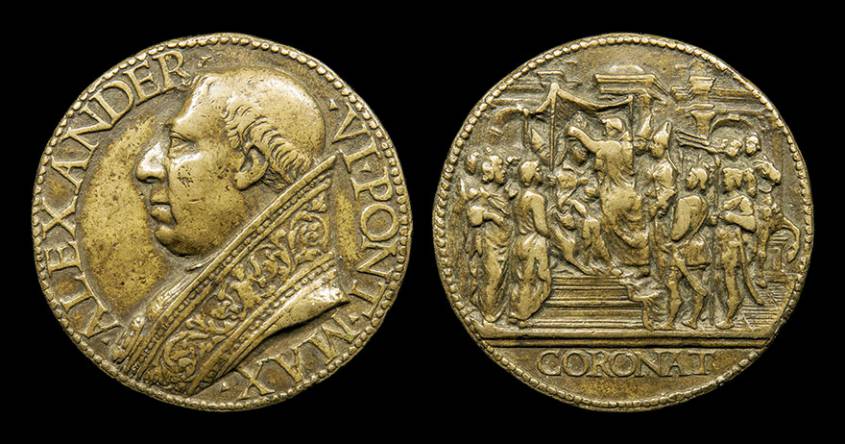
From the moment of his accession, Giuliano della Rovere confessed that he had chosen his name as pope, Julius II, not after Pope Julius I, but in reference to the bloodthirsty Roman dictator Julius Caesar. He asserts from the start his firm will to restore the political power of the popes in Italy. For him, Rome must once again become the capital of an Empire much larger than the Roman Empire of the past.
When Julius II took office, decadence and corruption had brought the Church to the brink. The territories that would later become Italy were a vast battlefield where Italian condottieri, French kings, German emperors and Spanish nobles came to fight. The ancient city of Rome was nothing more than a vast heap of ruins systematically plundered by rapacious entrepreneurs in the service of princes, bishops and popes, each one seeking to monopolize the smallest column or architrave likely to come and decorate their palace or church. Reportedly, out of the 50,000 inhabitants of the city, there were 10,000 prostitutes and courtesans…
Obviously, Julius II was the pope chosen by the oligarchy to restore a minimum of order in the house. For, particularly since 1492, the extension of Catholicism in the New World and then in the East, required a « rebirth », not of « Christian humanism », as during the Renaissance of the early 15th century, but of the authority of the Church.
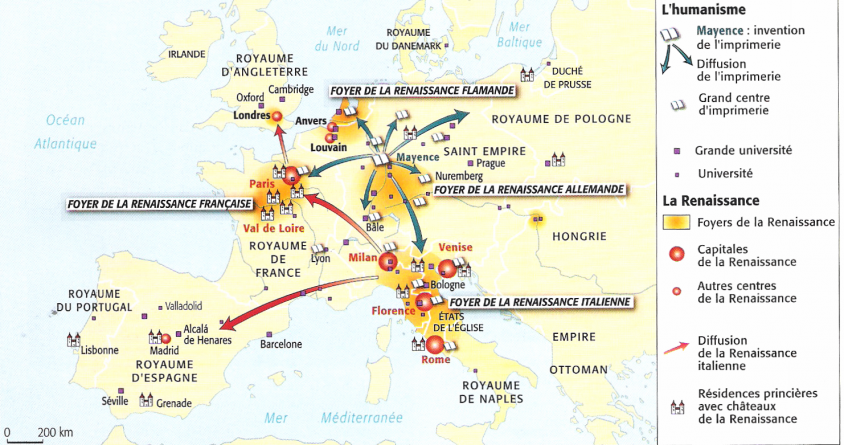
For us today, the word « Renaissance » evokes the heyday of Italian culture. However, for the powerful oligarchs of Raphael’s time, it was a matter of resurrecting the splendor of Greco-Roman antiquity, embodied in the glory of the Roman « Republic », mistakenly idealized as a great and well-administered state, thanks to efficient laws, capable civil servants possessing a great culture, based on the assiduous study of Greek and Latin texts.
And it is well to this rebirth of the Roman authority that Julius II is going to dedicate himself. In first place by the sword. In less than three years (1503-1506), the rebellious César Borgia is reduced to impotence. He was the illegitimate son of Pope Alexander VI who, at the head of an army of mercenaries, waged war in the country and terrorized the Papal States,
In 1506, Julius II, quickly nicknamed « the warrior pope » at the head of his troops, took back Perugia and Bologna.
As the humanist Erasmus of Rotterdam (1467-1537), who was present in Italy and was an eyewitness to the sacking of Bologna by the papal troops, reproached him, Julius II preferred the helmet to the tiara. Questioned by Michelangelo in charge of immortalizing him with a bronze statue, to know if he did not wish to be represented with a book in his hand to underline his high degree of culture, Julius II answers:
Why a book? Rather, show me a sword in hand.
Originally from the region of Genoa (Liguria), Julius II undertook to chase the Venetians, whom he abhorred, out of Romagna, which they occupied. « I will reduce your Venice to the state of hamlet of fishermen from which it left, » had said one day the Ligurian pope to the ambassador Pisani, to which the proud patrician did not fail to retort:
And we, Holy Father, we will make of you a small village priest,
if you are not reasonable…
This language gives the measure of the bitterness to which one had arrived on both sides. In the bull of excommunication launched shortly afterwards (April 27, 1509) against the Venetians, these were accused of « uniting the habit of the wolf with the ferocity of the lion, and of flaying the skin by pulling out the hairs… ».
The League of Cambrai

Against the rapacious practices of Venice, on December 10, 1508, in Cambrai, Julius II officially rallies to the « League of Cambrai », a group of powers (including the French King Louis XII, the regent of the Netherlands Margaret of Austria, King Ferdinand II of Aragon and the German Emperor Maximilian I).
For Julius II, the happiness is total because Louis XII comes in person to expel the Venetians of the States of the Church. Better still, on May 14, 1509, after its defeat by the League of Cambrai at the battle of Agnadel, the Republic of Venice agonizes and finds itself at the mercy of an invasion. However, at that juncture, Julius II, fearing that the French would establish their influence on the country, made a spectacular turnaround. He organized, from one day to the next, the survival of Venice!
His treasurer general, the Sienese banker Agostino Chigi (a Sienese billionaire close to the Borgias, to whom he had lent colossal sums of money and later Raphael’s patron), set the conditions:
- In order to pay for the Swiss mercenaries capable of repelling the attackers of the Ligue of Cambrai, Chigi granted the Venetians a substantial loan.
- In exchange, the Serenissima agreed to give up its monopoly on the trade of alum that it imported from Constantinople. At the time, alum, an irreplaceable mineral used to fix fabric dyes, represented a real « strategic » issue.
- Once Venice stopped importing alum, the entire Mediterranean world was forced, from one day to the next, to obtain supplies, not from Venice, but from the Vatican, that is to say, from Chigi, who was in charge of exploiting the « alum of Rome » for the Papacy, located in the mines of the Tolfa mountains, northwest of Rome in the heart of the Papal States.
- Aware that its very survival was at stake, and for lack of an alternative, Venice grudgingly accepted the golden deal.
In his biography on Jules II, french historian Ivan Cloulas specifies:
Above all stands out Agostino Chigi, the banker from Siena, farmer of the pontifical mines of alum of Tolfa since the reign of Alexander VI. The favor that this character enjoyed with Julius II is surprising, since he was a banker who had long served Caesar Borgia. The pontiff, according to the tradition, conferred at the time of his accession the load of ‘depositary’ to one of his Genoese compatriots, Paolo Sauli, charged to carry out all the financial transactions of the Holy See in connection with the cardinal camerlingue Raffaelo Sansoni-Riario. But Chigi did not suffer disgrace, because he advanced Julian della Rovere considerable sums of money to buy electors [cardinal members of the Sacred College], and he made the exploitation and export of alum extracted from the pontifical mines a success. The experience and value of the Sienese made him a partner of the various bankers of the papacy, notably the Sauli and the Fugger, who gained new wealth as the fruitful trade in indulgences developed in Germany.
Hence, now in alliance with Venice, Julius II, in what appears to the naive as a spectacular « reversal of alliance », set up the « Holy League » to « expel from Italy the Barbarians » (Fuori i Barbari!). A coalition in which he made enter the Swiss, Venice, the kings Ferdinand of Aragon and Henri VIII of England, and finally, the emperor Maximilian. This league will then drive out the French out of Italy. Julius II said with irony:
If Venice had not existed,
it would have been necessary to invent it.
In response, Louis XII, the King of France, attempted to transpose the struggle into the spiritual realm. Thus, a national council, meeting in Orleans in 1510, he declared France exempt from the obedience of Julius II. A second council was convened in Italy itself, in Pisa, then in Milan (1512) trying to depose the pope. Julius II opposed to the King of France the Vth ecumenical council of the Lateran (1512) where he will welcome warmly those who abandoned that of Milan…
Maritime Empires
Julius II was determined to re-establish his authority both on land and on the oceans. A bit like in ancient Greece, Italy experienced a rather particular phenomenon, that of the emergence of « maritime republics ». If the « Republic of Venice » is famous, the maritime republics of Pisa, Ragusa (Dubrovnik on the Dalmatian coast), Amalfi (near Naples) and Genoa are less known.
In each case, operating from a port, a local oligarchy built a maritime empire and above all poisoned its competitors. However, maritime activity, by its very nature, implies taking risks over time. Hence the need for skillful, robust and forward-looking finance, offering insurance and purchase options on future assets and profits. It is therefore no coincidence that most financial empires developed in symbiosis with maritime empires, notably the Dutch and British, and with the West and East India Companies.
At the end of the 15th century, it was essentially Genoa and Venice that were fighting for control of the seas. On the one hand, Venice, historically the bridgehead of the Byzantine Empire and its capital Constantinople (Istanbul), was by far the largest city in the Mediterranean world in 1500 with 200,000 inhabitants. Since its heyday in the 13th century, the Serenissima has defended tooth and nail its status as a key intermediary on the Silk Road to the West. On the other hand, Genoa, which, after having established itself in the Levant thanks to the crusades, by taking control of Portugal, financed all the Portuguese colonial expeditions to West Africa from where it brought back gold and slaves.
Two maritime achievements will exacerbate this rivalry a little more:
- 1488. Although the works of the Persian scholar Al Biruni (11th century) and old maps, including that of the Venetion monk Fra Mauro, made it possible to foresee the bypassing of the African continent by the Atlantic Ocean to reach India, it was not until 1488 that Portuguese sailors passed the Cape of Good Hope. Thus, Genoa, without any intermediary, could directly load its ships in Asia and bring its goods back to Europe;
- 1492. Seeking to open a direct trade route to Asia without having to deal with the Venetians or the Portuguese (Genoese), Spain sent the Genoese navigator Christopher Columbus west in 1492. More than a new route to Asia, Columbus discovered a new continent that would be the object of covetousness.

as signed on by Pope Alexander VI Borgia with the treaty of Tordesillas in 1494
Two years later, on June 7, 1494, the Portuguese and Spanish signed the Treaty of Tordesillas to divide the entire world between them. Basically, all of the New World for Spain, all of the old one (from the Azores to Macao) for Portugal. To delimit their empires, they drew an imaginary line, which Pope Alexander VI Borgia set in 1493 at 100 leagues west of the Azores and the Cape Verde Islands.
Later, the line was extended, at the request of the Portuguese, to 370 leagues. Any land discovered to the east of this line was to belong to Portugal; to the west, to Spain. At the same time, any other Western maritime power was denied access to the new continent. However, in 1500, to the horror of the Spaniards, it was a Portuguese who discovered Brazil. And given its geographical position, to the west of the famous line, this country fell under the control of the Portuguese Empire!
Julius II, a child of Liguria (region of Genoa, therefore linked to Portugal) and vomiting Alexander VI Borgia (Spanish), in 1506, takes great pleasure in confirming, by the bull Inter Cætera, the treaty of Tordesillas of 1494 allowing to fix the dioceses of the New World, obviously to the advantage of the Portuguese and therefore to his own.
The ultimate weapon, culture
On the « spiritual » and « cultural » level, if Julius II spent most of his time at war, posterity retains essentially the image of « one of the great popes of the Renaissance » as a great protector and patron of the arts.
Indeed, to re-establish the prestige (the French word for soft power) and therefore the authority of Rome and its Empire, culture was considered a weapon as formidable as the sword. To begin with, Julius II opened new arteries in Rome, including the Via Giulia. He placed in the Belvedere courtyard the antiques he had acquired, in particular, the « Apollo of Belvedere » and the « Laocoon », discovered in 1506 in the ruins of Nero’s Imperial Palace.
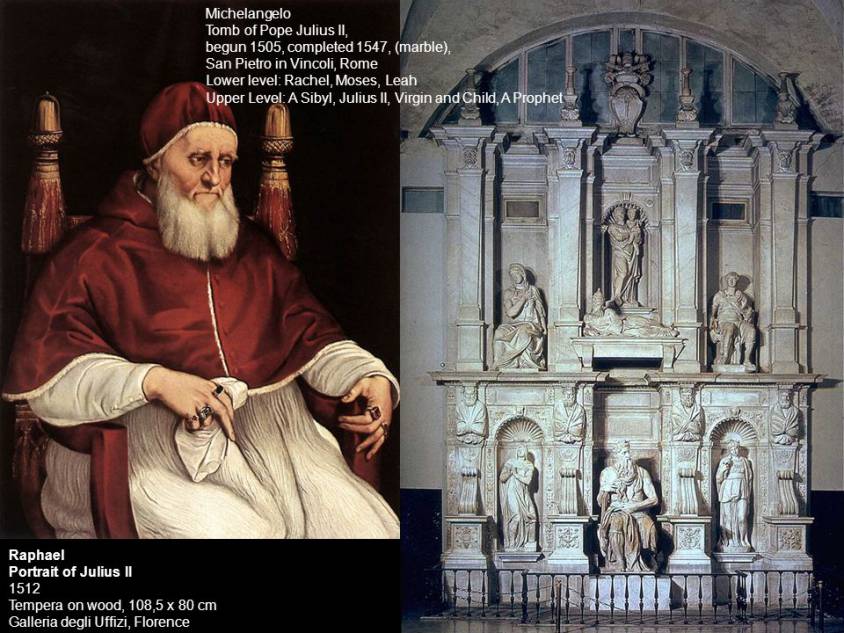
In the same year, that is to say six years before the end of the military operations, Julius II also launched great projects, some of which were only partially or entirely completed after his death:
- The reconstruction of St. Peter’s Basilica, a task entrusted to the architect and painter Donato Bramante (1444-1514) ;
- The tomb of Julius II, which the sculptor Michelangelo was entrusted with in the apse of the new basilica and of which his famous statue of Moses, one of the 48 bronze statues and bas-reliefs originally planned, should have been part;
- The decoration of the vault of the Sistine Chapel built by Pope Sixtus IV, the uncle of Julius II, was also entrusted to Michelangelo. Julius II let himself be carried away by the creative spirit of the sculptor. Together, they worked on ever more grandiose projects for the decoration of the Chapel. The artist gave free rein to his imagination, in a different artistic genre that did not please the pope. Until October 31, 1512, Michelangelo painted more than 300 figures on the vault;
- The frescoes decorating the personal library of the pope will be entrusted to the painter Raphael, called to Rome in 1508, probably at the suggestion of Chigi, Aretino or Bramante. The Stanza was the place where the pope signed his briefs and bulls. This room later became the private library of the pontiff Julius II, then the room of the Tribunal of Apostolic Signatures of Grace and Justice and later, that of the Supreme instance of appeal and cassation. Before the arrival of Julius II, this room and « the room of Heliodorus », were covered with frescoes by Piero della Francesca (1417-1492), a painter protected by the great Renaissance genius cardinal philosopher Nicolaus of Cusa (1401-1464), immortalizing the great ecumenical council of Florence (1438). Decorations by Lucas Signorelli and Sodoma were added later. Following his election, Julius II, anxious to mark his presence in history, and to re-establish the authority of the oligarchy and the Church, had the frescoes of the Council of Florence covered with new ones. Convinced by his advisors, the pope agreed to entrust the direction of the work to Raphael. Officially, it is said that Raphael spared some of the frescoes on the ceiling, notably those executed by Sodoma, so as not to antagonize him entirely. But, as we have said, the content, the very elaborate theme and part of the iconography of the frescoes were decided upon as early as 1506, even before Raphael’s arrival in 1508;
- To modernize the city of Rome. Julius II, undoubtedly advised by the architect Bramante, singularly transformed the road system of Rome. In order for all the roads to converge towards St. Peter’s Basilica, he ordered the Via Giulia to be pierced on the left bank and the Lungara, the paths that meandered along the river on the right bank, to be transformed into a real street. His death interrupted the great works he had planned, in particular the construction of a monumental avenue leading to St. Peter’s and that of a new bridge to relieve the congestion of the bridge over St. Angelo, to which he had also facilitated access by widening the street leading to it. The extent of the work undertaken poses the problem of materials; although it was, in principle, forbidden to attack the ancient monuments, the reality was quite different. Ruinante, became the nickname of Bramante.
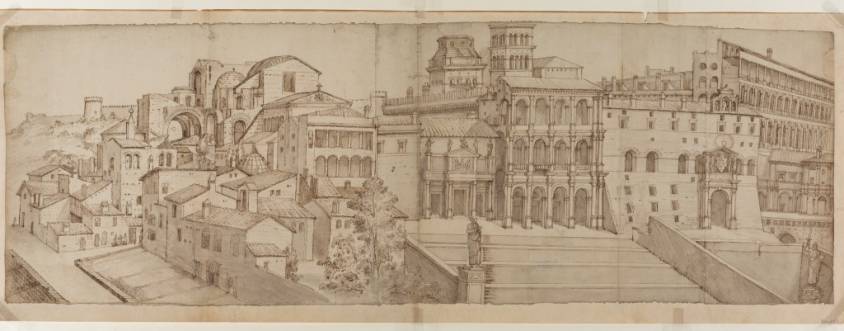
These major construction projects, patronage and military expenses drained the Holy See’s revenues. To remedy this, Julius II multiplied the sale of ecclesiastical benefits, dispensations and indulgences.
In the twelfth century, the Roman Catholic Church established the rules for the trade of « indulgences » (from the Latin indulgere, to grant) through papal decrees. They provided a framework for the total or partial remission before God of a sin, notably by promising, in exchange for a given amount of money, a reduction in the time spent in purgatory to the generous faithful after their death. In the course of time, this practice, essentially exploiting a form of religious superstition, turned into a business so lucrative that the Church could no longer do without it.
In northern Europe, particularly in Germany, the Fugger bankers of Augsburg were directly involved in organizing this trade. This practice was strongly denounced and fought against by the humanists, in particular by Erasmus, before Luther made it an essential part of the famous 95 theses that he posted, in 1517, on the doors of the church in Wittenberg.
In his book Erasmus and Italy, french historain Augustin Renaudet writes that Erasmus, after having met the highest authorities of the Vatican, was not fooled:
He was not long in understanding that apart from the Holy See, the services of the Curia and the Chancellery, apart from the cardinals, the innumerable prelates on mission and in charge, apart from a motley crowd of civil servants and scribes, who populated the administrative or financial offices and the courts, there was nothing in Rome. In all the cities he had known, in Brussels, in Paris, in London, in Milan, in Florence, and recently in Venice, an active economy, fed by industry, commerce, and finance, supported a strong urban bourgeoisie, or as in Venice, an aristocracy of shipowners. In Rome, all the economy, all the trade, all the finance, were in the hands of foreigners: Florentine or Genoese merchants, Florentine or Genoese bankers. These foreigners held in their dependence a people of small merchants, of small craftsmen who sold in the back room, of money changers and Jewish traffickers. Very little industry, the Roman population lived at the service of the Curia, the prelates and the convents. Erasmus marveled at the pride with which the descendants of the people-king pretended to maintain their ancient majesty.
The word of the Roman people was no longer an empty word; Erasmus was to write one day that, in the modern world, a Roman citizen counted less than a burgher of Basel.
Historians André Chastel and Robert Klein, in L’Humanisme, l’Europe de la Renaissance, share this observation:
Another trend, favorable to Caesar and Augustus, had emerged: Rome becoming again more and more the ‘imperial’ capital of all the powerful borrowed or sought to borrow a style from it.
This new style associates besides more and more arma and litterae, the sword and the book.
(…) Rich or poor, any sovereign of the Renaissance will occupy the artists and the scholars insofar as he needs prestige: the greatest patrons of the Renaissance were the ambitious and the warriors, Maximilian, Julius II, Henry VIII, François I, Charles V.
Raphael’s « impresarios »
If, from a contemporary point of view, it seems close to unthinkable for an artist to be « dictated » the theme of his work, this was not the case at the time of the Renaissance and even less so in the Middle Ages. For example, although he was a high-level diplomat of the Duke of Burgundy Philip the Good, the Flemish painter Jan Van Eyck (, one of the first painters to sign his works with his name, was advised on theology by the Duke’s confessor, the erudite Dionysus the Cartusian (1401-1471), a close friend of Cardinal Nicolaus of Cusa. And no one will dare say that Van Eyck « did not paint » his masterpiece The Mystic Lamb.
Raphael’s position was more delicate. In his time, painters still had the status of craftsmen. Including Leonardo da Vinci, who was known for his superior intelligence, declared himself to be a « man without letters », that is to say, unable to read Latin or Greek. Raphael could read and write Italian, but was in the same condition. And when, towards the end of his short life, he was asked to work on architecture (St. Peter’s Basilica) and urban planning (Roman antiquities), he asked a friend to translate the Ten Books of the Roman architect Vitruvius into Italian. Now, any visitor to the « Chambers of the Signature » is immediately struck by the great harmony uniting several dozen philosophers, jurists, poets and theologians whose existence was virtually unknown to Raphael before his arrival in Rome in 1508.
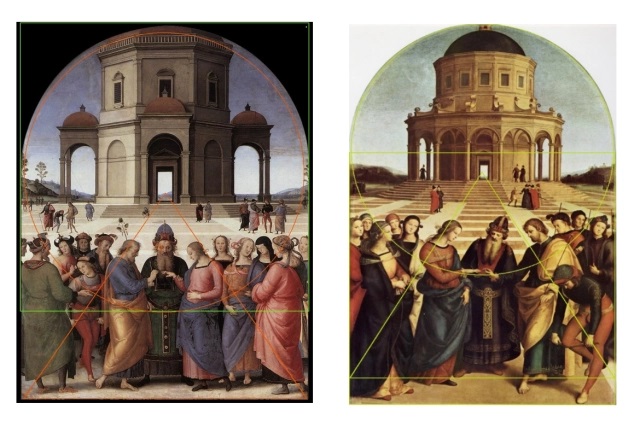
Moreover, with the exception of The Marriage of the Virgin, painted in 1504 at the age of 21, based on the way his master Pietro di Cristoforo Vannucci, known as Pietro Perugino (c. 1448-1523) had treated the same subject, Raphael had not yet had to meet the kind of challenge that the Stanza would pose to him.
As we have already said, the cartoons and other preparatory drawings, sometimes quite different from the final result, also suggest that, following the « commission, » discussions with one or more impresarios led the artist to modify, improve or change the iconography to arrive at the final result.
As for the theme, as we have already mentioned, the ideas and concepts seem to have emerged during a long period of maturation and were undoubtedly the result of multiple exchanges between Pope Julius II and several of his advisors, librarians, and « orators » of the papal court.
According to historian Ingrid D. Rowlands, the archival documents unquestionably indicate the decisive contribution of three very different personalities of the time:
- Battista Casali ;
- Giles of Viterbo;
- Tommaso « Fedra » Inghirami.
The thorough investigation of the historian Christiane L. Joost-Gaugier has established the predominant role of Inghirami. He was the only one in a position, and in a position, as the pope’s chief librarian, to set the program of the rooms. Raphael, will be his enthusiastic collaborator and will undoubtedly end up being « recruited » to the orientations and vision of his commissionners. This is evidenced by the fact that he demanded to be buried in the Roman Pantheon, considered the most Pythagorean, and believed to be the most neo-Platonic, temple of the Roman era.
Battista Casali
As documented by the Jesuit historian John William O’Malley, it was on January 1, 1508, the year of his appointment to St. John Lateran, a few months before Raphael’s arrival in Rome, that Battista Casali (1473-1525), a professor at the University of Rome, evoked the image of The School of Athens in an oration delivered in the Sistine Chapel in the presence of Julius II:
One day (… ) the beauty of Athens inspired a contest between the gods, where humanity, learning, religion, primacies, jurisprudence and law came into being before being distributed in every country, where the Athenaeum and so many other gymnasiums were founded, where so many princes of knowledge trained their youth and taught them virtue, fortitude, temperance and justice – all of this destroyed in the whirlwind of the Mohaematan war machine… ) However, just as [your illustrious uncle Pope] Sixtus IV [who ordered the construction of the Sistine Chapel], in a way, laid the foundations of education, you laid the cornice. Here is the Vatican library which he erected as if it had come from Athens itself, gathering the books he was able to save from the wreckage, and created in the image of the Academy. You, now, Julius II, supreme pontiff, have founded a new Athens when you invoke the downtrodden world of letters as if it were rising from the dead, and order it, surrounded by threats of suspended work, that Athens, its stadiums, its theaters and its Athenaeums, be restored.
Giles of Viterbo
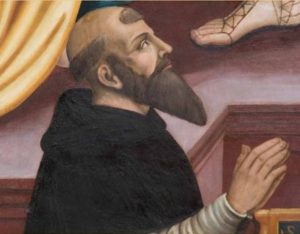
Another major influence on the theme, Giles of Viterbo (1469-1532) of which we will say more below.
- An outstanding orator, he was called to Rome in 1497 by Pope Alexander VI Borgia ;
- In 1503, he became the Superior General of the Order of Hermits of Saint Augustine; with 8000 members, it was the most powerful order of its time;
- He is known for the boldness and seriousness of the speech he gave at the opening of the Fifth Lateran Council in 1512;
- He severely criticized the bellicose policy of Julius II and urged him to triumph by culture rather than by the sword;
- After the death of the latter, he became the preacher and theologian of Pope Leo X who appointed him cardinal in 1517.
Tommaso Inghirami
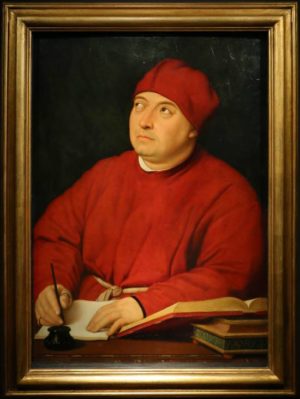
Finally, the prelate Tommaso Inghirami (1470-1516), who spoke both Latin and Greek, was also a formidable orator. The man owed his fortune to Lorenzo the Magnificent (1449-1492).
Educated by the Neoplatonic philosopher Marsilio Ficino, Lorenzo the Magnificent was the patron of both Botticelli and Michelangelo who lived with him for three years.
Born in Volterra, Inghirami was also taken in by the Magnificent after the sacking of that city. He carefully supervised his studies and later sent him to Rome where Alexander VI Borgia welcomed him. Inghirami was a handsome and well-dressed man.
At 16, Inghirami earned the nickname « Phaedra » after brilliantly playing the role of the queen who commits suicide in a Seneca tragedy performed in a small circle at the residence of the influential Cardinal Raphael Riario, cousin of Julius II or nephew of Pope Sixtus IV and therefore cousin of Julius II. Thereafter, Phaedra, bon vivant and for whom the celestial and terrestrial pleasures were happily completed, gained in political and especially… physical weight.
- In 1475, he accompanied the nuncio of Pope Alexander VI to the court of Emperor Maximilian I of the Holy Roman Empire, who named him Count Palatine and poet laureate;
- On January 16, 1498, Inghirami delivered an oration in the Spanish Church of Rome in honor of the Infant Don Juan, the murdered son of the King of Spain. Inghirami, in the name of Alexander VI Borgia, fully endorsed the Spanish policy of the time: to extend Christianity as well as imperial looting into the New World, to drive the Moors out of Europe and to strengthen the colonial plunder of Africa. If Julius II hated Alexander VI, he will continue this policy;
- In 1508, Julius II nominates Inghirami to head the Library of the Vatican to be installed in the Stanza;
- In 1509, while he was heavily involved in the realization of the frescoes of the Stanza, Raphael made his portrait. Raphael shows us a man suffering from divergent strabismus who seems to turn his gaze towards the sky in order to signify where this « humanist » drew his inspiration from;
- In 1510, the Pope appointed him Bishop of Ragusa;
- Finally, in 1513, he became papal secretary and at the urgent request of the dying pope, Inghirami delivered his funeral oration: « Good God! What a mind this man had, what sense, what ability to manage and administer the Empire! What a supreme and unshakable strength! »
Inghirami soon served as secretary to the conclave electing Pope Leo X (John of Medici, second son of Lorenzo de Medici, also a great protector of neo-Platonists and « culture »), another pope whose portrait Raphael will paint.
In 1509, eager to reform the Catholic church on the basis of the study of the three languages (Latin-Greek-Hebrew) to settle the religious conflicts which were looming and announced the religious wars to come, Erasmus of Rotterdam meets Inghirami in Rome. The latter exposes to him the imposing cultural building sites which he directed. Erasmus does not say a word about it.
However, a long time after the death of Inghirami, Erasmus complained that the Vatican and the oligarchy recruited among the humanists. He notably fingerpointed the sect of “the Ciceronians”, omnipresent in the Roman Curia and of which Inghirami was one of the leaders.
Thus, in 1528, in a pamphlet titled The Ciceronians, Erasmus quoted Inghirami’s oration on Good Friday of 1509. He denounced the fact that the members of this sect, on the grounds of the elegance of the Latin language, only used Latin words that appeared as they were in the works of Cicero! As a result, all the new language of evangelical Christianity, enshrined in the Council of Florence, which Erasmus wished to promote, was either banned or « re-translated » into pagan terms and words of the Roman era! For example, in his sermon, Inghirami had presented Christ on the cross as a pagan god sacrificing himself heroically rather than as a redeemer.
Finally, shortly after Raphael’s death, Cardinal Jacopo Sadoleto (1477-1547) wrote a treatise on philosophy in which Inghirami (meanwhile tragically deceased) defended rhetoric and denied the value of philosophy, his main argument being that everything written was already contained in the mystical and mythological texts of Orpheus and his followers…
Plato and Aristotle, the impossible synthesis
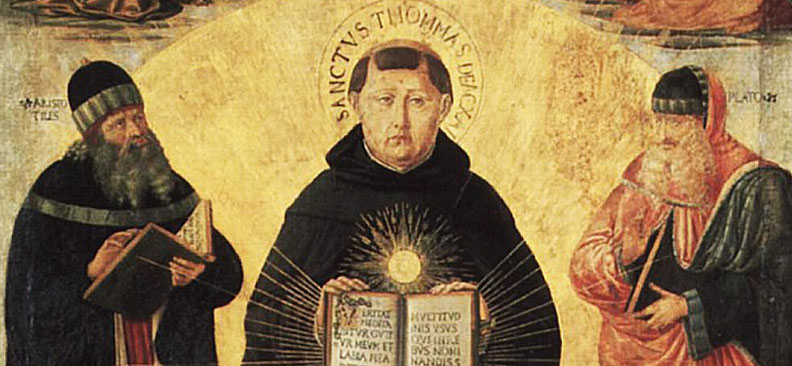
Now, in order to be able to « read » the theme deployed by Raphael in the « Chamber of the Signature, » let us examine this Florentine « neo-Platonism » that animated both Giles of Viterbo and Tommaso Inghirami.
The approach of these two orators consisted above all in putting their « neo-Platonism » and their imagination at the service of a cause: that of asserting with force that Julius II, the pontifex maximus at the head of a triumphant Church, embodied the ultimate outcome of a vast line of philosophers, theologians, poets and humanists. At the origin of a civilizational and theological « big bang » presumed to lead to the immeasurable lustre of the Catholic Church under Julius II, not only Plato and Aristotle themselves, but those who had preceded them including Apollo, Moses and especially Pythagoras.
From 1506 onwards, Giles de Viterbo, in an exercise that can be described as « beyond” impossible, wrote a text entitled Sententia ad mentem Platonis (« Sentences with the mind of Plato »). In it, he tried to combine into one ideology the Sentences of Peter Lombard (1096-1160), the scholastic text par excellence of the 13th century and the starting point for the commentaries of the Dominican Saint Thomas Aquinas (1225-1274) for his Summa Theologica, and the esoteric Florentine neo-Platonism of Marsilio Ficino (1433-1499) * of whom Giles de Viterbe was a follower.
All this could only please a pope who, in order to establish his authority on earthly and spiritual matters, warmly welcomed this agreement between Faith and Reason defended by Thomas Aquinas who says that “the Truth being one”, reason’s only role is to confirm faith’s superiority.
The very idea to present the wedding of Aristotelian scholasticism (logic presented as « reason ») with Florentine neo-Platonism (Plotinus’ emanationism dressed as « faith ») as a source of poetry and justice as « The Signing Room » does, comes from this.
Let us recall that in the middle of the 13th century, two mendicant Orders, the Franciscans and the Dominicans, were contesting the drift of a Church that had become, above all, the simple manager of its earthly possessions. The one who would later be called St. Thomas Aquinas, opposed on this point (his competitor) St. Bonaventure (1221-1274), founding figure of the Franciscan Order.
For his part, Aquinas relies on Aristotle, whom Albert the Great (1200-1280), whose disciple he was in Cologne, had made known to him, to establish the primacy of « reason ». For the man who was nicknamed « the dumb ox », faith and human reason, each managing their own domain, had to move forward together, hand in hand while of course, the Church had the last word.

Several paintings (the great fresco of 1366 in the Spanish chapel of Santa Maria Novella in Florence; the painting by Filippino Lippi of 1488 in the Carafa chapel in Rome; or the painting by Benozzo Gozzoli (1421-1497), painted around 1470, in the Louvre in Paris), have immortalized the “Triumph of Thomas Aquinas”.
Gozzoli’s painting in the Louvre is of particular importance because several elements prefigure the iconography of the Signing Chamber, notably the three levels found in Theology (Trinity, Evangelists and religious leaders) as well as the couple Plato and Aristotle found in Philosophy.
In Gozzoli’s painting, we see Aquinas, standing between Plato and Aristotle, throwing down before him the Arab philosopher Averroes (1126-1198) (Ibn-Rushd of Cordoba) expelled for having denied the immortality and the thought of the individual soul, in favor of a « Single Intellect » for all men that activates in us the intelligible ideas.
In the West, before the arrival of Greek delegations in Italy to attend the Council of Ferrara-Florence in 1438, if several works of Plato, including the Timaeus, were known to a handful of scholars, such as those of the School of Chartres or Italians as Leonardo Bruni in Florence, most of the West’s knowledge of Greek thought came down to the works of Aristotle.
For the Aristotelians, who became dominant in the Catholic Church with Aquinas, Plato had to be considered as incompatible with Christianity.
On the other hand, for the Platonists, including Augustine, Jerome and especially Nicholas of Cusa and Erasmus, who honored and adorned him that Erasmus called « Saint Socrates », Plato was to be venerated by Christians: he was monotheistic, believed in the immortality of the soul and venerated, in the form of the Pythagorean triad, the mystery of the Trinity.
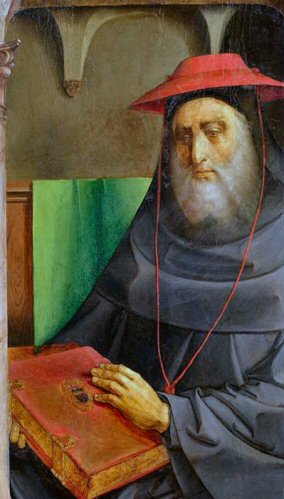
In the 15th century, for lack of epistemological clarity and some confusion on the authorship of certain manuscripts, some humanists, in particular Nicolaus of Cusa‘s friend and close collaborator Cardinal John Bessarion (1403-1472), one of the key organizers of the reunification of the Eastern and Western Churches, presented Plato as the « equal » of Aristotle, the latter’s disciple, with the sole purpose of making Plato « as acceptable as possible » to the Catholic Church.
Hence Bessarion‘s now famous phrase « Colo et veneror Aristotelem, amo Platonem » (I cultivate and venerate Aristotle, I love Plato) which appears in his In Calumniatorem Platonis (republished in 1503), a rejoinder to the virulent charge against Plato elaborated by the Greek Georges Trébizond.
Thus, in the School of Athens painted by Raphael, Plato and Aristotle appear side by side, not confronting each other but complementing the other with their respective wisdom : the first holding his book the Timaeus (on the creation of the universe) in one hand, and with the other, pointing to the sky (To the One, to God), the second holding his Ethics (the science of the good in personal life) in one hand, and raising the other arm horizontally to indicate the earthly realm (Physics).
If the commissioners had wanted to underscore the opposition of both philosophers, Plato would have rather been portrayed with his Parmenides (On Ideas) and Aristotle with his Physics (On natural sciences). That is clearly not the case.
Giles de Viterbo in his Sententia ad mentem Platonis will mobilize extreme sophism to erase the irreconcilable and very real oppositions (see box below) between the Platonic thought and that of Aristotle.
Why Plato and Aristotle are not complementary
By Christine Bierre
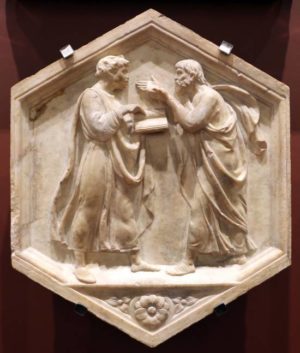
The fundamental concepts that gave birth to our European civilization can be traced back to classical Greece, and through it, to Egypt and other even more ancient civilizations.
Among the Greek thinkers, Plato (-428/-347 B.C.) and Aristotle (-385/-323 B.C.) asked all the great questions that interest our humanity: who are we, what are our characteristics, how do we live, where are we situated in the universe, how can we know it?
The accounts that have come down to us from this distant period speak of the disagreements that led Aristotle to leave Plato’s Academy, of which he had been a disciple. History then bears witness to the violence of the oppositions between the disciples of the one and the other. During the Renaissance, the most reactionary Catholic currents, the Council of Trent in particular, were inspired by Aristotle, whereas Plato reigned supreme in the camp of humanism, in the hands of some of the greatest, such as Erasmus and Rabelais.
There were various attempts, however, to make them complementary, as discussed in this article by Karel Vereycken. If Plato represents the world of Ideas, Aristotle represents the world of matter. Impossible to build a world without both, we are told. It seems so obvious!
The Greek philosopher, Plato.

All this starts, however, from a false idea opposing these two characters. For Plato, we are told, reality is found in the existence of ideas, universal concepts which represent, in an abstract way, all the things which participate of this concept. For example, the general concept of man contains the concept of particular men such as Peter, Paul and Mary; similarly for good, which includes all good things whatever they are. For Aristotle, on the contrary, reality is located in matter, as such.
What is false in this reasoning is the concept that the Platonic Ideas are abstractions. The Platonic Ideas are, on the contrary, dynamic entities that generate and transform reality. In the myth of the cave in The Republic, Socrates says that at the origin of things is the sovereign Good. In The Phaedo, he explains that it is through « Ideas » that this sovereign Good has generated the world.
In the myth of the cave, Socrates uses an offspring of the idea of the good, the Sun, to help us understand what the sovereign Good is. The Good, he says, has generated the Sun, which is, in the visible world, in relation to sight and objects of sight, what the Good is in the intelligible world in relation to intelligence and intelligible objects. The prisoners in the cave saw only the shadows of reality, and then, on coming out, they saw, thanks to the Sun, the real objects, the firmament and the Sun. After this, they will come to the conclusion about the Sun, that it is he who produces the seasons and the years, that he governs everything in the visible world and that he is in some way the cause of all those things that he and his companions saw in the cave.
The Sun not only gives objects the ability to be seen, but is also the cause of their genesis and development. In the same way for the knowable objects, they hold from the Good the faculty to be known but, in addition, they owe him their existence and their essence. The idea of the Good is thus for Plato the dynamic cause of the things: material and immaterial and not dead universals.
Aristotle’s splintered « One »
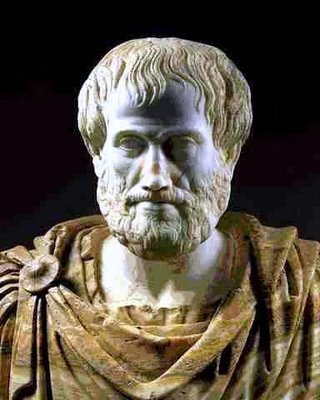
For Aristotle, as for all the empiricist current which followed him, reality is situated at the level of the objects knowable by the senses. Nature sends us its signals that we decode with our mental faculties. Ideas are only abstractions of the sensible universe which constitutes reality. For him the universals have no real existence: man « in general », does not generate anything. It is only an abstraction of all the men in particular. The particular man is generated by the particular man; Peter is generated by Paul.
It is also said of Aristotle that he « exploded » Plato’s One. There are two ways of conceiving the One. One can think of it either as an absolute One (God or first cause), depending on whether one is a religious person or a philosopher, a purely intelligible principle but a dynamic cause that has generated all things; or one can think of it as the number « one » that determines each particular thing: the number one when we say: a man, a chair, an apple.
Aristotle‘s One simply becomes a particular unity, characteristic of all things that participate in unity. It is not the cause of what « is » but only the predicate of all the elements that are found in all the categories. The Being and the One, he will say, are the most universal of predicates. The One, he will say again, represents a definite nature in each kind but never the nature of the One will be the One in itself. And the Ideas are not the cause of change.
What is the point of all this?
Does this discussion make more sense than all the never-ending debates about the sexes of angels that gave scholasticism such a bad name in the Middle Ages? The One or the many, what does it matter in our daily lives?
This point is however essential. The fact of being able to go back to the intelligible causes of all that exists, puts the human species in a privileged situation in the universe. Unlike other species, it can not only understand the laws of the universe, but also be inspired by them, in order to improve human society. This is why, in history, it is the « Platonic » current that was at the origin of the great scientific, technological and cultural breakthroughs in astronomy, geometry, mechanics, architecture, but also the discovery of proportions that allow the expression of beauty in music, painting, poetry and dance.
As for Aristotle, it must be said that his conceptions of man and knowledge only led him to establish categories defining a dozen possible states of being. Aristotle was also the founder of formal logic, a system of thought that does not claim to know the truth, but only to define the rules of a correct reasoning. Logic is so little interested in the search for truth that one can consider that a judgment that is totally false in relation to reality can be said to be right if all the rules of « good reasoning » of logic have been used.
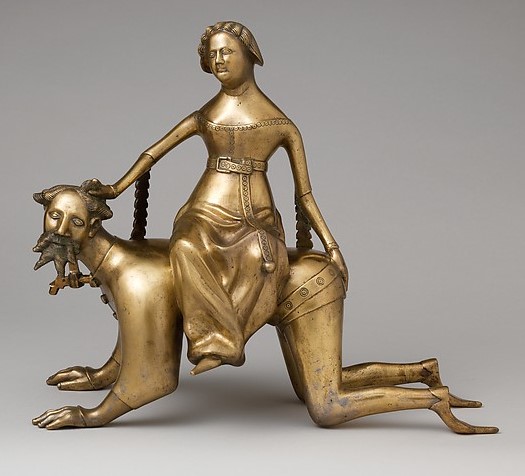
Suite
To begin with, Giles de Viterbo underlines that Aristotle is a « pupil » of Plato and that the « two princes of philosophy » could be reconciled. Very much imbued with the neo-Pythagorean spirit, and for whom Plato was only one of the greatest disciples of Pythagoras, the author argues that both philosophers agree that, contrary to the pagan pantheon, the « One » is the ultimate expression of the divine. Clearly, they were both monotheists and thus their convictions anticipated those of Christianity.
Giles of Viterbo:
Philosophy, which traces and examines all things, judges that all number and multiplicity are absent from God, as Plato and his pupil Aristotle say. Humanity has as its goal the understanding of divine things, as even Aristotle admits in his Ethics.
Thus, if it is necessary to pursue this goal, it is necessary to arrive at the understanding of God.
And he continues:
Now these princes of Philosophy [Plato and Aristotle] can be reconciled, and no matter how much they disagree about creation, the Ideas, or the goal of the Good, these points [of agreement] can be identified and demonstrated (…) [Then], they appear not to disagree with each other at all (…) These great princes can be reconciled if we postulate the double nature of things, one which is free from matter and the other which is within matter (…) Plato follows the first, Aristotle the second, and because of this, these two great leaders of philosophy hardly differ from each other. If you think that we are making this up, listen to them yourselves. For if we speak of humanity, after all the subject of our conversation, then Plato says the same thing, he says humanity is the soul, in the (First) Alcibiades; and in the Timaeus, he says that humanity has two natures, and we know one of these natures by means of the senses, and the other by means of reason. Also, in the same book, he teaches us that each part in us does not exist in isolation from the other, that each nature is concerned with the other nature. Aristotle, in the tenth book of his Ethics, calls humanity Understanding. So you can know that each philosopher (Plato and Aristotle) feels the same way, no matter how much it seems to you that they are not saying the same thing.
Pico della Mirandola the Neo-Platonist

Giles of Viterbo, like Tommaso Ingharimi, seems to have taken up the gauntlet thrown to them by John Pico della Mirandola (1463-1494), the young disciple of Ficino.
A precocious scholar, a protégé of Lorenzo de’ Medici (like Inghirami), this man of omniscience was fearless. Thus, in 1485, at the age of 23, he announced his project to gather, at his own expense, in the eternal city and capital of Christianity, the greatest scholars of the world to debate the mysteries of theology, philosophy and foreign doctrines. The objective was to go back from scholasticism to Zoroaster, passing by the Arabs, the Kabbalah, Aristotle and Plato, to expose to the eyes of all, the concordance of wisdom. The affair failed. His initiative, which reserved an important place for magic, could only arouse distrust. For the Vatican, all this could only smell of sulfur, and the initiative was discarded at the time.
However, it will mark the minds of a generation. For his Oratio de hominis dignitate, his inaugural speech written in an elegant and almost Ciceronian style, intended for the presentation of his nine hundred theses, published together after his death, was a great success, especially among young scholars like… Inghirami.
Pico’s achievement, which was not well received by the authorities, was to give humanistic studies (studia humanitatis) a new purpose: to seek the concordance of doctrines and define the dignity of the human being. The aim was, by bringing out what unites them despite their differences, to discover their common ground and, by a coincidence of opposites, to have them meet in a unity that transcends them.
Pico della Mirandola:
That is why, not content with having added to the common doctrines a quantity of remarks on the primitive theology of Mercury Trismegistus, on the teachings of the Chaldeans and Pythagoras, on the most secret mysteries of the Jews, we have also proposed for discussion a certain number of discoveries and conceptions of our own in the physical and theological fields. First of all, we have argued that Plato and Aristotle agree: many have thought so before us, no one has proved it sufficiently. Among the Latins, Boethius had promised himself to do so, but there is no indication that he ever realized what was always his project. Among the Greeks, Simplicius had given himself the same program: heaven forbid that he should have lived up to his intentions! Augustine himself, in his work Against the Academicians, writes that many authors have conceived, with great finesse in argumentation, the project of establishing this same point, namely that the philosophies of Plato and Aristotle are one. Thus John the Grammarian [The Hellenist John Lascarus] affirms well that only those who do not hear the words of Plato believe him to be in disagreement with Aristotle, but it is to his successors that he left the care of the demonstration. We have also added various developments where the concordance between the opinions – reputedly discordant – of Scotus and Thomas on the one hand, of Averroes and Avicenna on the other hand, is affirmed. Secondly, our considerations on Aristotelian and Platonic philosophy have been enriched by seventy-two new physical and metaphysical propositions: by making them one’s own, if I am not mistaken (and I will soon be sure of this), one will be able to solve any problem of a natural or theological nature, according to a philosophical method which is quite different from the one taught orally in schools and which is in honor among the doctors of our time.
In a manuscript found unfinished at the time of his death in 1494 and entitled Concordia Platonis et Aristotelis, Pico della Mirandola explicitly mentions Plato’s Timaeus and Aristotle‘s Ethics, precisely the two books that appear as attributes of their authors in Raphael’s fresco.
Then, in his Heptaplus, a work he completed in 1489, Pico della Mirandola asserted that the writings of Moses and the Mosaic Law, according to him the foundation of all wisdom, were the basis of Greek civilization before becoming that of the Church of Rome. The Timaeus, the major work of Plato, says Pico, demonstrates that its author was an “attic Moses” (from Athens).
Cicero the Neo-platonist
For Inghirami, fascinated by the eloquence and the style of Cicero (-106/-43 BC) of whom he believed himself the reincarnation, the challenge launched by Pico della Mirandola to reconcile Apollo, Pythagoras, Plato and Aristotle, appeared almost as a divine test and the frescoes of Raphael decorating the Stanza will be above all his answer.
In addition, Cicero himself claimed to be a neo-Platonist. In the first volume of his work, the Academica, after condemning Socrates for continually asking questions without ever « laying the foundations of a system of thought », Cicero asserts, several centuries before Pico della Mirandola, that the ideas of Plato and Aristotle, in essence, « had the same principles »:
In the shadow of Plato’s genius, a fertile, varied, universal genius, a unique philosophy was established under the double banner of the academicians and the peripatetics, who, agreeing on things, differed only on the terms. For Plato, who had made Speusippus, son of his sister, the heir of his philosophy, also left two disciples of great talent and rare science, Xenocrates of Chalcedony and Aristotle of Stagire: those who followed Aristotle, were named peripatetics, because they discussed while walking in the Lyceum; whereas those who, according to the institution of Plato, held their assemblies and disserted in the Academy, the other gymnasium of Athens, received from this place the name of Academicians. But both of them, all penetrated by Plato’s fertile genius, formulated philosophy into a certain complete and finished system, and abandoned the universal doubt of Socrates, and his habit of discussing everything without affirming anything. There was then what Socrates entirely disapproved of, a philosophical science, with regular divisions and a whole methodical apparatus. This philosophy, as I have said, under a double name, was one; for between the doctrine of the peripatetic [Aristotle] and the ancient Academy [Plato] there was no difference. Aristotle prevailed, in my opinion, by the richness of his genius; but the one and the other had the same principles, and judged the goods and the evils in the same way.

Inghirami was also strengthened by the reading of countless Christian authors in this sense, such as the Frenchman, Bernard of Chartres (12th century), a Neoplatonist philosopher who played a fundamental role in the Chartres school, which he founded. He was appointed master (1112) and then became chancellor (1119) responsible for the teaching of the cathedral school.
You wonder the sculptures of Pythagoras and Aristotle appear side by side on the western portal of the cathedral?
Historian Etienne Gilson writes:
Bernard of Chartres was first of all influenced by Boethius, whose Platonism he adapts. He then set out to reconcile Plato’s thought with that of Aristotle, which made him the greatest Aristotelian and Platonic thinker of the 12th century. John of Salisbury affirmed, in the most formal terms, that Bernard of Chartres and his disciples did not believe that they were simply expounding Plato’s thought by explaining in this way the relation of ideas to things, but that they had the pretension of putting Aristotle in agreement with Plato. That the trouble they took was wasted, is what John of Salisbury clearly states. With a very British humor he notes that these philosophers arrived too late and that they worked uselessly to reconcile dead men who had been arguing all their lives.
Inghirami will have read St. Bonaventure (1217-1274), one of the founders of the Franciscan order, who pointed out that Plato and Aristotle each excelled in their own field:
And so it appears that among philosophers, Plato’s gift is to speak of wisdom, Aristotle‘s of science.
Or the Florentine Marsilio Ficino, this neo-Platonic philosopher of the XVth century whose « Platonic Academy » had put in saddle Pico della Mirandola. Ficino, had he not written in his Platonic Theology that
Plato treats natural things divinely while Aristotle treats even divine things naturally.
In the preface he wrote for The Fable of Orpheus, a play written by his disciple Poliziano (1454-1494), Ficino, referring to Saint Augustine, makes the mythical Hermes Trismegistus (Mercury) the first of the theologians: his teaching would have been transmitted successively to Orpheus, Aglaophemus, Pythagoras, Philolaos and finally Plato.
Thereafter, Ficino will place Zoroaster at the head of these prisci theologi, to finally attribute to Zoroaster and Mercury an identical role in the genesis of the ancient wisdom: Zoroaster teaches this one among the Persians at the same time as Trismegistus taught it among the Egyptians.
Preceding Plato, Pythagoras

In Raphael’s School of Athens, the figure of Pythagoras of Samos (580-495 B.C.), surrounded by a group of admirers, takes a major place. He is clearly identifiable by a tablet on which the musical chords and the famous Tetraktys appear, which we will discuss here.
While historians have so far mainly explored the influence of the Platonic and Neo-Platonic currents on the Italian Renaissance, historian Christiane L. Joost-Gaugier, in her book Pythagoras and Renaissance Europe, has highlighted the extent to which the ideas of the great pre-Socratic thinker Pythagoras influenced the thought and art of the Renaissance.
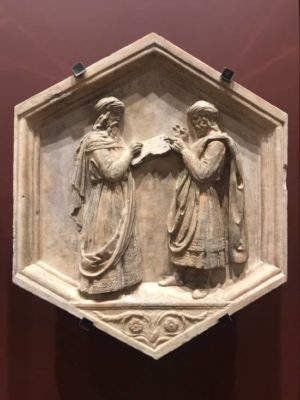
In art, Pythagoras inspired the Roman architect Vitruvius (90-15 BC), and later such theorists of the golden mean such as the Franciscan monk Luca Pacioli (1445-1517), whose treatise, De Divina Proportiona, illustrated by Leonardo da Vinci, appeared in Venice in 1509.
However, if a theorem, probably from India, bears his name (attributed to Pythagoras by Vitruvius), little is known of his life. Just like Confucius, Socrates and Christ, if we are sure that he really existed, no writing from his hand has come down to us.
By necessity, Pythagoras
became a living legend, and even very active during the Renaissance, so much so that most people saw Plato as a mere « disciple » of the « divine Pythagoras ».
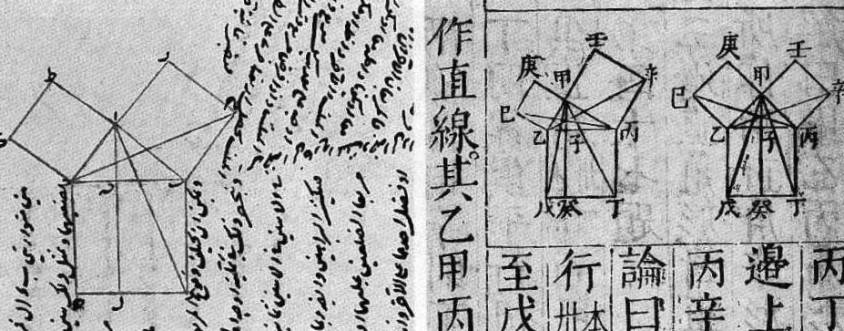
Born in the first half of the 6th century B.C. on the island of Samos in Asia Minor, Pythagoras was probably in contact with the school of geometer’s founded by Thales of Miletus (-625/-548 B.C.).
Around the age of 40, he left for Crotone in southern Italy to found a society of friends, both philosophical, political and religious, whose chapters were to multiply.
For Pythagoras, the issue is to build a bridge between man and the divine and on this basis to transform society and the city. When asked about his knowledge, Pythagoras, before Socrates and Cusa, asserted that he knew nothing, but that he sherished « the love of wisdom ». The word philo-sophy would have thus been born.
No Christian humanist, reading Saint Jerome (347-420), one of the Fathers of the Catholic Church, could escape the praise that the latter gives to Pythagoras.
In his polemic Apology against the Books of Rufinus, Jerome, in order to evoke an exemplary behavior, quotes what two disciples of Pythagoras would have said:
We must by all possible means avoid softness of the body, ignorance of the spirit, intemperance, civil dissensions, domestic dissensions and in general excess in all things.
And Jerome invokes the « Precepts of Pythagoras » :
Everything must be common among friends; a friend is another ourselves. We must consider two periods in life, the morning and the evening, that is, what we have done and what we must do. After God, we must seek the truth, which alone can bring men closer to the Creator.”
Secondly, Jerome believes that Pythagoras, in affirming the concept of the immortality of the soul, preceded Christianity:
Listen to what Pythagoras was the first to find in Greece, Jerome says: That souls are immortal, that they pass from one body into another, and, it is Virgil himself who tells us in the sixth book of the Aeneid: When they have made a revolution of a thousand years, God calls them in great numbers to the banks of the river Lethe, so that they may undoubtedly see again the heaven they no longer remember; it is then that they begin again to revive a new body, which first was Euphorbus, then Calide, then Hermoticus, then Perhius and finally Pythagoras ; and that after a certain time what has existed begins to be born again, that there is nothing new in the world, that philosophy is a collection of meditations on death, that every day it strives to free the soul from the chains that bind it to the body and to give it back its freedom. Plato communicates many other ideas in his writings, especially in the Phaedo and in the Timaeus.
The hidden geometry of numbers
For Pythagoras « the beginning is half of everything ». According to Theon of Smyrna (v. 70/v. 135), for the philosopher, « numbers are, so to speak, the principle, the source and the root of all things ».
Aristotle, in his Metaphysics reports:
The Pythagoreans first applied themselves to mathematics… Finding that things [including musical sounds] model their nature mainly on the set of numbers and that numbers are the first principles of the whole of nature, the Pythagoreans concluded that the elements of numbers are also the elements of everything that exists, and they made the world a harmony and a number.
And as Cleinias of Tarantum (4th century BC), a Pythagorean friend of Plato, said:
When these things, therefore, are at rest, they give birth to mathematics and geometry, when they are in motion to the harmonica and astronomy.
The idea of the « monad », a dynamic unity participating in the One, perfected several centuries later by the philosopher and scientist Gottfried Wilhelm Leibniz (1646-1716) in his « Monadology« , comes to us from this period. Etymologically meaning « unity » (monas), it is the supreme unity (the One, God, the principle of numbers) which, while being at the same time the minimal unity, reflects in the microcosm the same dynamic activity that the One represents in the macrocosm.
Already, just the name of Apollo (a god considered as « the father » of Pythagoras) means, as Plato, Plutarch and other ancient authors point out: free of all multiplicity (Pollo = multiplicity; a-pollo = non-multiple).
Xenophanes of Colophones (born around 580 BC), asserts the existence of a unique God governing all things by the power of his intelligence. It is about a god not similar to the men, because eternal, incorporeal and spherical.

As much as this conception of a dynamic One has sometimes provoked an explosion of esoteric interpretations, it has stimulated the most creative minds and terrorized the formalists of thought.
When speaking about simple things, arithmetic numbers, Pythagoras uses the terms of one, two, three, four, five, ten…, while to evoke ideal numbers and their power, he speaks about: monad, dyad, triad, tetrad, decad, etc. Thus, by conceiving numbers in a non-linear but figurative way, he offers an arithmetic applicable to astronomy, music and architecture. By arranging these numbers, like marbles, in a particular way, Pythagoras discovered the famous « geometry of numbers ». For example, in the case of triangular numbers, three points form a triangular surface. If we add three points below, we find the number 6, but it is still a triangle. And if we add four more points, we get the number 10, still a triangular number.
The Patriarch of Constantinople Photius (810-893) confirms that :
The Pythagoreans proclaimed that the complete number is ten.
The number ten, is a compound of the first four numbers that we count in their order. That is why they called Tetraktys the whole constituted by this number.
Besides the plane and triangular numbers (1, 3, 6, 10, etc.), Pythagoras explored the square numbers (1, 4, 9, 16, …), rectangular, cubic, pyramidal, star-shaped, etc. In doing so, Aristoxenus said, Pythagoras had « raised arithmetic above the needs of merchants ». This approach, that of seeing harmony above and within the multiple, has inspired many scientists throughout history. One thinks of Mendeleev for the elaboration of his table of elements or of Einstein.
The power of numbers was also well understood by the cardinal-philosopher Nicolaus of Cusa, who evokes Pythagoras in the first chapter of his treatise De Docta Ignorantia (1440), when he states that :
All those who search, judge the uncertain by comparing it to a certain presupposition by a system of proportions. All research is therefore comparative, and uses the means of proportion: if the object of research can be compared to the presupposition by a small proportional reduction, the judgment of apprehension is easy; but if we need many intermediaries, then difficulty and pain arise. This is well known in mathematics: the first propositions are easily brought back to the first principles which are very well known, whereas the following ones, because they need the intermediary of the first ones, have more difficulty. Therefore, all research consists of a comparative proportion, easy or difficult, and this is why the infinite, which escapes, as infinite, from all proportion, is unknown. Now, the proportion which expresses agreement in a thing on the one hand and otherness on the other hand, cannot be understood without the number. This is why the number encloses all that is susceptible of proportions. Therefore, it does not create a proportion in quantity only, but in everything that, in some way, by substance or by accident, can agree and differ. Therefore, Pythagoras strongly believed that everything was constituted and understood by the power of numbers. Now, the precision of combinations in material things and the exact adaptation of the known to the unknown are so far above human reason that Socrates considered that he knew nothing but his ignorance; at the same time as the very wise Solomon affirms that all things are difficult and that language cannot explain them.
The Geometry of numbers,
the secret of mental calculations
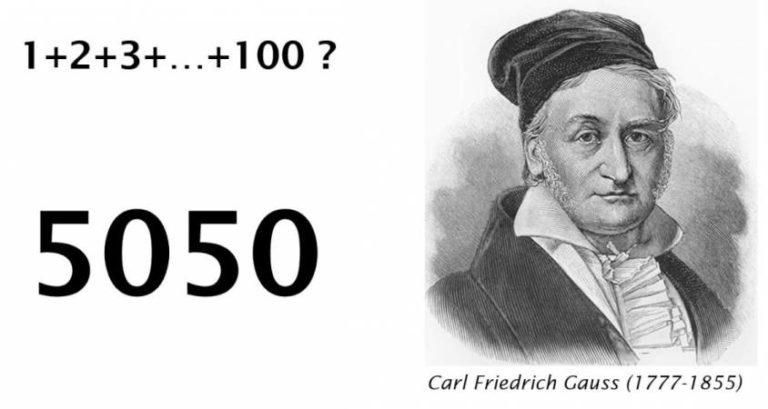
Here is a simple example.
One day, in Göttingen, the teacher of the young German mathematician Carl Gauss (1777-1855) asked his students to calculate the sum of all the numbers from one to one hundred. The students did so and began to add the numbers 1 + 2 + 3 + 4 + 5, etc.
The young Gauss raises his hand and, following a mental calculation, announces the result of the operation: « 5050, Sir! »
The teacher, surprised, asks him how he arrived at the result so quickly. The young Gauss explains: to see if there is a geometry in the number 100, I added the first digit (1) with the last (100). This gives 101. Now, if I add the second digit (2) with the second to last one (99), it also makes 101. I concluded that within the number 100 there are fifty pairs of even and odd numbers whose sum is 101 each time. Thus, by multiplying 101 by the number of couples (50), I immediately arrive at 5050.
From Pythagoras to Plato
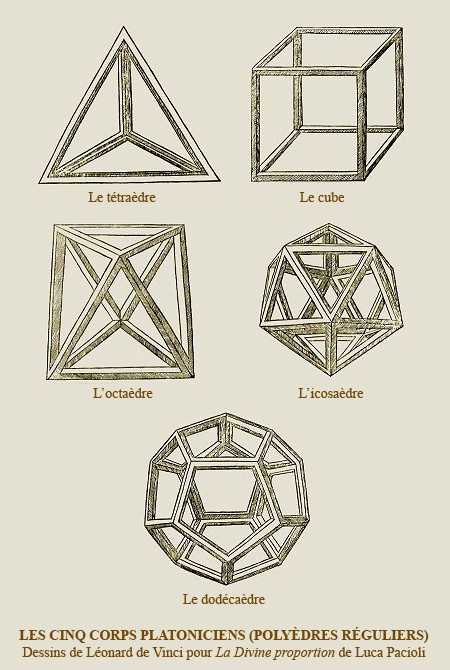
For Pythagoras, the most perfect surface is the circle and the ideal volume is the sphere since regular polyhedra can be inscribed. According to one of his disciples, the Italian Philolaus of Croton (-470/-390 BC), Pythagoras would have been the first to define the five regular polyhedrons:
- the cube,
- the tetrahedron (a pyramid with 4 triangular faces),
- the octahedron (composed of 8 triangles),
- the icosahedron (64 triangles) and
- the dodecahedron (composed of 12 pentagons).
Since Plato describes them in his work, the Timaeus, these regular polyhedra took the name of « Platonic solids ». Let’s recall that Plato went to Italy several times, notably to meet his close friend, the great Pythagorean scientist, astronomer, musical theorist and political leader, Archytas of Tarantum (-428/-387), considered today as « the father of robotics ».
A direct disciple of Philolaos, Archytas became the mathematics teacher of the brilliant Greek astronomer and physician Eudoxus of Cnidus (-408/-355).

Starting with Archytas, the Pythagoreans associate the 1 to the point, the 2 to the line, the 3 to the surface (the two-dimensional geometrical figure: circle, triangle, square…), the 4 to the solid (the three-dimensional geometrical figure: tetrahedron, cube, sphere, etc.).
Let’s add that in the Timaeus, one of Plato’s last dialogues, after a brief exchange with Socrates, Critias and Hermocrates, the Pythagorean philosopher Timaeus of Locri (5th century BC) exposes a reflection on the origin and the nature of the physical world and of the human soul seen as the works of a demiurge while addressing the questions of scientific knowledge and the place of mathematics in the explanation of the world.
Cicero (Republic, I, X, 16) specifies that Timaeus of Locri was an intimate of Plato:
No doubt you have learned, Tuberon, that after the death of Socrates, Plato went first to Egypt to learn, then to Italy and Sicily, in order to learn all about the discoveries of Pythagoras.
There he lived for a long time in the intimacy of Archytas of Taranto and Timaeus of Locri, and had the chance to obtain the Commentaries of Philolaos.
The music of the spheres
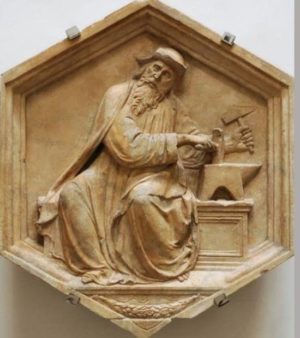
A magnificent bas-relief on the campanile of the Florence cathedral reflects what the early Italian humanists knew about Pythagoras.
Luca della Robbia (1399-1482), the sculptor working on the instructions of the humanist chancellor of Florence Leonardo Bruni (1370-1444), shows Pythagoras, a large hammer in one hand, a small hammer in the other, striking an anvil and concentrating his mind on the difference in the sounds he produces.
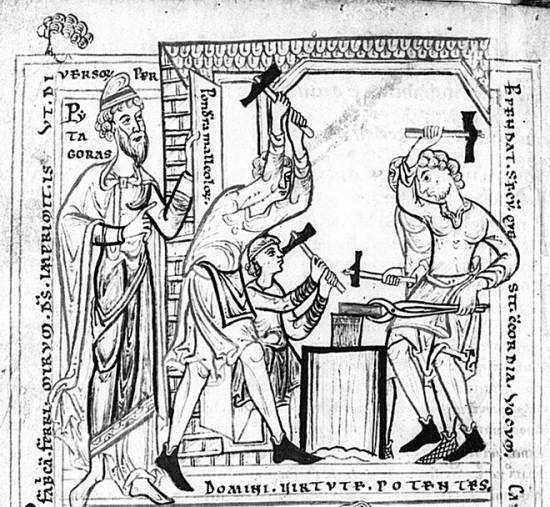
According to the legend, Pythagoras was walking near a forge when his attention was caught by the sound of hammers striking the anvil. He discerned in his ear the same consonances as those he could produce with his lyre. His intuition led to a fundamental discovery: musical sounds are governed by numbers.
This is how Guido d’Arezzo (992-1050), the Benedictine monk who created the system of musical notation still in use, relates the event in the last chapter (XX) of his book Micrologus around 1026:
A certain Pythagoras, a great philosopher, was traveling adventurously; he came to a workshop where an anvil was being struck with five hammers. Amazed by the pleasant harmony [concordiam] they produced, our philosopher approached them and, believing at first that the quality of sound and harmony [modulationis] lay in the different hands, he interchanged the hammers. When this was done, each hammer retained its own sound. After having removed one that was dissonant, he weighed the others, and, admirably, by the grace of God, the first weighed twelve, the second nine, the third eight, the fourth six of I don’t know what unit of weight. He thus knew that the science [scientiam] of music resided in the proportion and ratio of numbers [in numerorum proportione et collatione] […] What can we say about the science of music? […] What more can be said? By arranging the notes according to the intervals mentioned above, the illustrious Pythagoras was the first to perfect the monochord. As it is not lasciviousness that one finds there, but a fast revelation of the knowledge of our art, it met a general assent among the scholars. And this art has gradually been affirmed and developed to this day, for the Master himself always illuminates the human darkness and his supreme Wisdom endures for all centuries. Amen.
Here, the diagram (found on a slate placed at the feet of Pythagoras in Raphael’s fresco), which visualizes the musical harmonies obtained by dividing a string. Dividing it in two gives the octave, in three the fifth and in four the fourth. Finally, epogdoon (from the prefix epi- meaning above and ogdoon meaning the eighth) translates the interval of 9/8, which here corresponds to the tone.
IMAGE
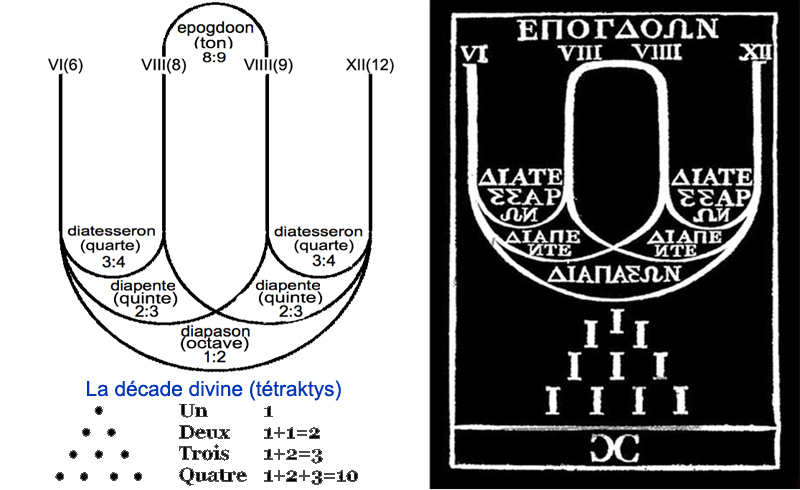
Let’s go back to the harmonic ratios that Pythagoras discovered from the weights of the hammers: 12, 9, 8 and 6.
- The ratio between 12 and 6 is the half and corresponds to the octave (diapason). It is found on a musical instrument by vibrating half a string;
- The ratio between 12 and 8 is a ratio of two thirds, which corresponds to the fifth (diapente);
- The ratio between 8 and 6, is a ratio of three quarters, which corresponds to the fourth (diatessaron);
- Finally, the ratio between 8 and 9 gives the interval of a tone (epogdoon, the prefix epi- meaning above and ogdoon meaning the eighth).

Later, the Pythagoreans transposed the same proportions to other objects, including volumes of water in glasses, the size of bells as well as bronze disks or the length of strings of musical instruments or flutes. For Pythagoras, this experience is fundamental because it corroborates the basic intuition of his philosophy: everything that exists is number, including phenomena as immaterial as musical intervals. In a famous passage of the Timaeus (35-36), Plato describes the fabrication of the proportions of the World Soul by the Demiurge. This passage is based on the numerical series 1, 2, 3, 4, 9, 8, 27, which corresponds to the fusion of the series of the first powers of 2 (2, 4, 8) and the series of the first powers of 3 (3, 9, 27). Now, from this series, we can derive the numerical relationships on which the musical intervals are based.
In his Metaphysics, Aristotle also notes :
The Pythagoreans noticed that the whole of the modes of musical harmony and the relations which compose it are resolved in proportional numbers.
With the French philosopher Pierre Magnard, we would rather say:
If to know is to measure, music is the art of pursuing measurement beyond the threshold of incommensurability. When numerical, metric and weight standards are no longer capable of establishing proportions between natural realities, harmony comes to the rescue of its own scales – diatonic, chromatic, enharmonic – and of its intervals – fifth, fourth, third, octave – to make up for the lack of calculation.
Finally, as the Roman musicologist Theon of Smyrna (70-135) stated:
The Pythagoreans assert that music is a harmonic combination of opposites, a unification of multiples and an agreement of opposites.
In addition, for the Pythagoreans, music also had an ethical and medical value:
He started education with music, using certain melodies and rhythms, thanks to which he healed the character traits and passions of men, and brought harmony between the faculties of the soul.
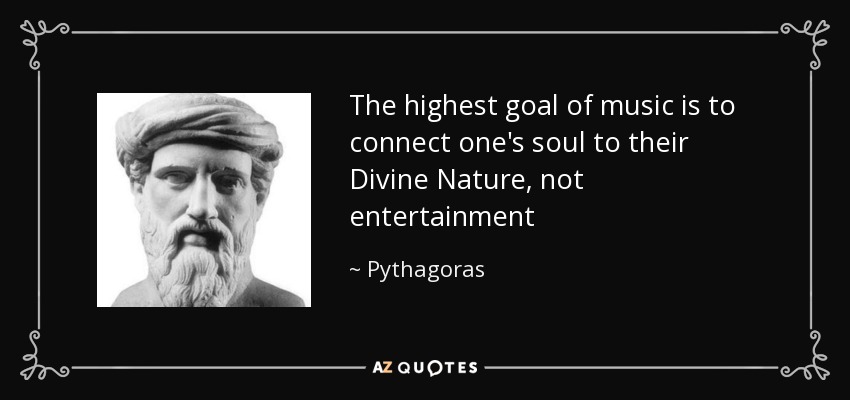
All this made Pythagoras the incarnation of a cosmic and universal harmony**. Moreover, he would have been the first to have used the word « cosmos » (perfection, order).
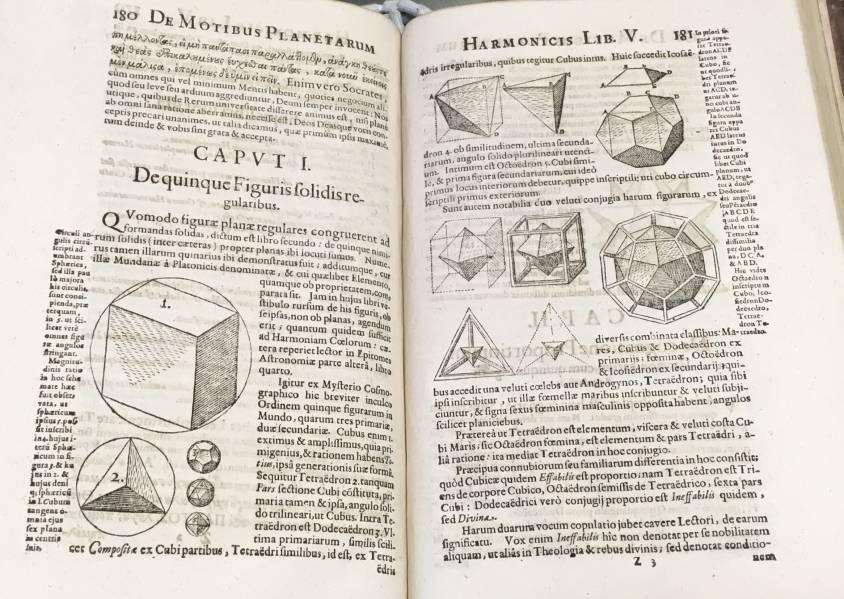
Pythagoras, praised by the first true astrophysicist Johannes Kepler (1571-1630), is said to have been the first to coin the concept of « the music of the spheres » or « the harmony of the spheres ».
For, as Sextus Empiricus (towards the end of the second century) states in his Pyrrhonian sketches, Pythagoras would have noted that the distances between the orbits of the Sun, the Moon and the fixed stars correspond to the proportions regulating the intervals of the octave, the fifth and the fourth. In the Republic, Plato states that astronomy and music are « sister sciences ».

Copernicus admits that the work of the Pythagoreans inspired his own research:
Others think that the Earth moves. Thus, Philolaos the Pythagorean says that the Earth moves around the Fire in an oblique circle, as do the Sun and the Moon. Heraclitus of Pontus and Ecphantos the Pythagorean do not, it is true, give the Earth a translational motion [motion around the Sun, heliocentrism]… Starting from this, I too began to think of the mobility of the Earth
(Copernicus, letter to Pope Paul III, preface to De revolutionibus orbium caestium [On the Revolutions of the Celestial Orbs], 1543).
The name Pythagoras (etymologically, Pyth-agoras: « he who was announced by the Pythia », the goddess), derives from the announcement of his birth made by the oracle to his father during a trip to Delphi. However, legend has it that Pythagoras was the son of Apollo, the god of light, poetry and music.
According to the oldest pre-Socratic traditions, Apollo had conceived a plan to control the universe. This plan was revealed in « the music of the spheres » under the wise supervision of Apollo, the sun god and god of music; a Greek god who passed to the Romans without changing his name. Apollo is represented with a crown of laurels and a lyre, surrounded by the nine muses.
GUIDED TOUR
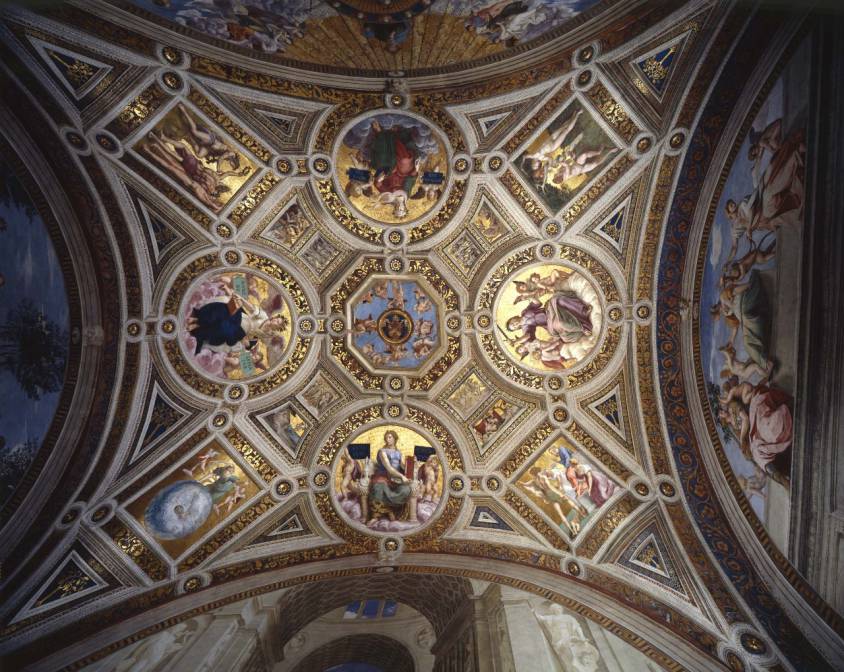
After reviewing the political situation of the time, the motivations of Pope Julius II and his advisors seeking to re-establish the authority of a « Triumphant Church, » the ultimate culmination for centuries to come of a culture that goes back to Apollo, Moses, Pythagoras, Plato, Cicero and their disciples, the viewer now has some solid « keys » (the « codes ») in hand that will allow him or her to « read » Raphael’s frescoes adorning the Stanza.
Without Raphael’s account of his work, this reading remains an obstacle course. For example, the identification of the figures remains uncertain, since, with a few rare exceptions, no tablet tells us this. The idea, in any case, is that the spectator, by analyzing the appearance and gestures of each one, discovers for himself who is represented.
As we said, when entering the room, the viewer is immediately asked to appreciate each fresco not in isolation, but as an expression of a coherent whole.
When entering the Stanza, as if inside a painted cube, one immediately realizes that one is facing a theatrical setting. For the great vaults that the spectator discovers are only painted images and do not respond to any structural reality of the building. Inghirami was a speaker, an actor and a director who knew who should appear where, with what attitude and dressed in what way. Thanks to this imagination, a room that was at first sight rectangular and boring, was transformed into a spherical cube because the corners of the room were « rounded » with stucco.
A. THE CEILING
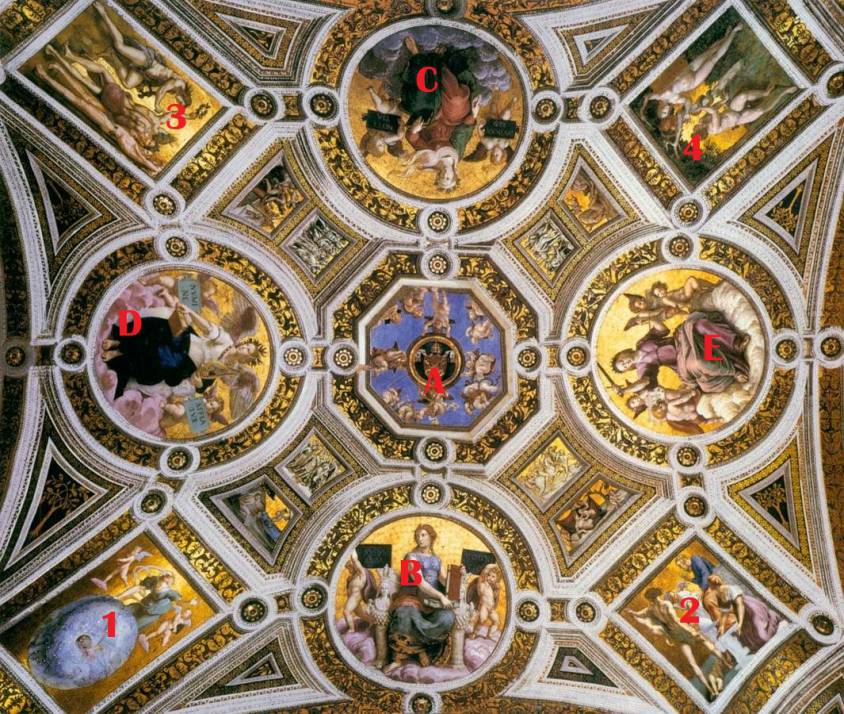
From the thematic point of view, the visual path, as one might expect, begins on the ceiling and ends on the floor. In the center of the ceiling, a small circle with the coat of arms of Julius II. Around it, an octagon surrounded by four circles connected by four rectangles. Each of the four circles touches the top of one of the four vaults painted on the four walls and shows an allegorical figure and a text announcing the theme of the large frescoes below.
Each time, it is a question of emphasizing the harmony uniting all the opposing (circle, square) parts. While the real incompatibilities are left to the checkroom, the oppositions and the formal differences will even be strongly emphasized, but exclusively to show that one can accommodate them by submitting them to a higher design.
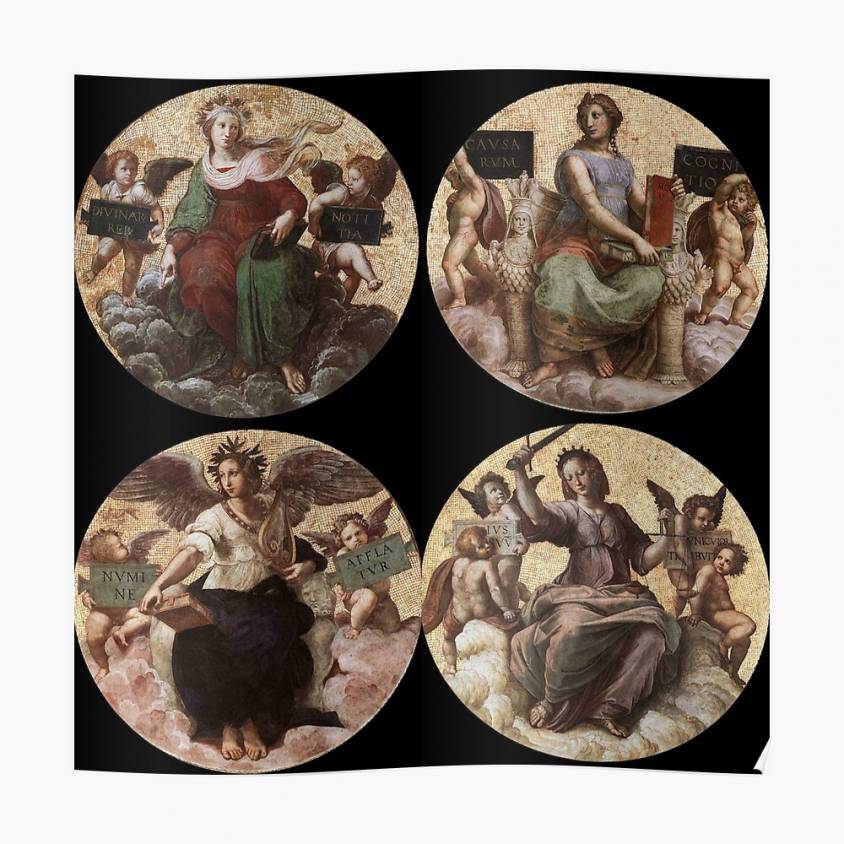
Thus two double themes (2 x 2) are articulated:
- Philosophy (the true accessible by reason), nicknamed The School of Athens, and Theology (the Truth accessible by divine revelation), nicknamed since the Council of Trent, the « Dispute of the Holy Sacrament »; a theme common to Aquinas and the neo-Platonists.
- Poetry and music (the Beautiful), and Justice (the Just), a theme of Ciceronian origin.
- Above the theme Philosophy, in one of the four circles, is represented by a woman wearing a dress with each of the four colors symbolizing the four elements evoked by a motif: blue illustrates the stars, red the tongues of fire, green the fish and golden brown the plants. Philosophy holds two books entitled « Morality » and « Nature », while two small genius (geniuses) carry tablets on which one can read « CAUSARUM » and « COGNITO », read together meaning « To know the causes ». Clearly, the aim of moral and natural philosophy is to know the causes, that is to say to go back to God.
- Above Theology, a woman dressed in red and green, colors of the theological virtues. In her left hand, she holds a book, her right hand points to the fresco below. Two geniuses carry tablets saying « DIVINAR.RER » and « NOTITIA », « The revelation of sacred things ».
- Above Poetry, the winged figure of the Poetry carrying lyre and crown of laurels. Two putti (cherubs) present us with tablets on which are inscribed the words of Virgil: « Inspired by the spirit » (NVMINE AFFLATVR). Since we are dealing with puttis and not geniuses, there is a clear reference to the Christian spirit that inspires the arts.
- Finally, above the last fresco, Justice, a woman holds the attributes of justice: the scales and the sword. Two putti carry tablets with the words of the Emperor Justinian: « IVS SVVM VNICUMQUE », that is, « to each his just punishment ».
Then, still on the ceiling, as we have indicated, there are four rectangular frescoes connecting the four circles whose theme we have just specified. Again, these are two pairs that complement each other.
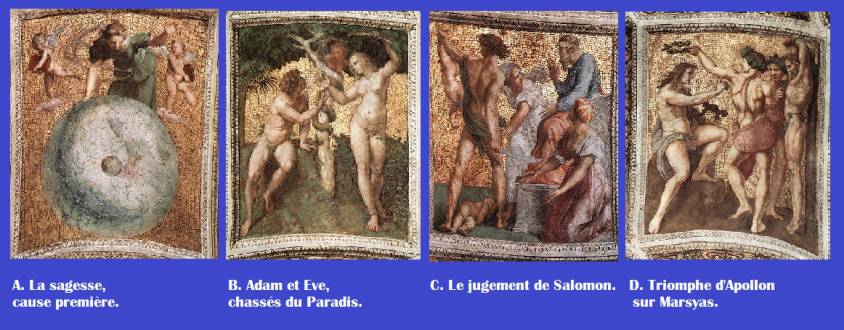
A. A first rectangular fresco, linking Philosophy with Poetry, shows us a woman (wisdom, the first mover) here as the first cause and setting a celestial globe in motion and thus the universe in action. It may be the mythical Sibyl mentioned by Heraclitus, a superhuman incarnation of the prophetic voice. Philosophically, it is an allegory of the creation of the universe (or Astronomy). The constellation that appears on the globe has been identified. It corresponds to the sky map of the night of October 31, 1503, the date of the election of Julius II… which of course the date he became the “prime mover” of the universe.
B. The second rectangle, diametrically opposed to the first one and linking Justice to Theology, represents « Adam and Eve driven out of Paradise ». Considered as the beginning of theology, « The Fall of Man », will be repaired by the « redemption » that the Church and Pope Julius II will bring, embodied by the creative wisdom putting the universe back into motion.
C. The third rectangle, linking Philosophy and Justice, represents « The Judgment of Solomon, » a scene showing King Solomon’s wise judgment when two mothers claimed the same child.
D. And finally, the fourth, at the other end of the diagonal, connecting Poetry and Theology, represents, not « The Flogging of Marsyas » as has been claimed, but another rather rare scene, « The Triumph of Apollo over Marsyas » in the struggle for the lyre. The latter receives a crown of laurels. The two judgments are based on different bases for their mutual appreciation. While King Solomon, representing the Old Testament, judges on the basis of the divine law, Apollo, who represents antiquity here, prevails thanks to the rules of the pagan pantheon, his will power.
B. THEOLOGY
(THE DISPUTE OF THE HOLY SACRAMENT)

*In the upper (celestial) register :
A. God the Father, B. Jesus Christ, C. Mary, D. St. John the Baptist, E. Apostle Peter, F. Adam, G. St. John the Evangelist, H. King David, I. St. Lawrence, J. Judas Maccabaeus, K. St. Stephen, L. St. Stephen, M. Moses, N. James the Greater, O. Abraham, P. St. Paul, SE. Holy Spirit.
*In the lower (earthly) register:
1. Fra Angelico, 2. ?, 3. Donato Bramente, 4. ?, 5. ?, 6. Pico della Mirandola, 7. ?, 8. ?, 9. ?, 10. Saint Gregory, 11. Saint Jerome, 12. ?, 13. ?, 14. ?, 15. ?, 16. Saint Ambrose, 17. Saint Augustine, 18. Saint Thomas of Aquinas, 19. pope Innocent III, 20. Saint Bonaventure, 21. pope Sixtus IV, 22. Dante Alighieri, 23. ?, 24. ?; 25. a mason, 26. ?, 27. ?
Historians tell us that it was the first fresco to be made. The core subject here is the Trinity and « transubstantiation », a supernatural phenomenon signifying the conversion of one substance into another, in the case of Christians, the conversion of bread and wine into the body and blood of Christ in the Eucharist under the action of the Holy Spirit. This meant a « real presence » of God at mass and thus a major attraction to attract the faithful and a precondition to obtain « indulgences » from him. For some humanists, such as the Swiss Protestant Ulrich Zwingli (1484-1531), any doctrine of the real presence is idolatry because it would be tantamount to worshiping bread and wine as if it were God.
Erasmus, for whom the performance of rituals should never be a substitute for true faith, explains that when Christ said to his disciples, in offering them bread, « this is my body » and « this is my blood, » in offering them wine, he was in reality talking metaphorically, not of bread and wine, but of his disciples (his body) and his teaching (his blood).
The idea of the composition is to show the triumph of the unity of the Church in Christ in all its complexities and diversities. The scene takes place on two levels, one celestial and the other terrestrial, lining up, as in a theater, a vast variety of actors presenting themselves to the public.
Above, in the celestial register, the heart of the subject, « the Trinity » with God the Father (A) blessing enthroned above a Christ (C) surrounded by Mary (B) (the New Testament) on his right and St. John the Baptist (D) (the Old Testament) on his left, themselves appearing above a dove symbolizing the Holy Spirit (SE).
Around them, to match the architecture of the School of Athens opposite, sit peacefully on a semi-circular cloud bench, the remarkable figures of the Church Triumphant, accompanied by their traditional attributes and dressed in colorful garments specific to each.
At the ends of the semicircle, two apostles: the Apostle Peter (E), representing the Jews, and the Apostle Paul (P), representing the Gentiles, face each other, as if they were the outer guards of the triumphant Church, the custodians of both the key and the letter of it. The Old Testament is represented by Adam (F) facing Abraham (O), and Moses (M) facing King David (H) with his harp in hand. The New Testament is also represented by St. John (G) facing St. Matthew (N) (two authors of the Gospel), by St. Lawrence (I) and St. Stephen (L) (both martyred saints).
At the bottom, in the terrestrial register, there is an enormous altar (Y) on which is written (in the middle) « IV LI VS » (Julius). A golden monstrance (X) with a host in its center proclaims the presence of Christ in the mystery of transubstantiation. Next to it, the Doctors of the Church of the early days of Christianity: on the left (under the features of Julius II) St. Gregory (No. 10), the great reformer of the ritual and the chant of the Mass, next to St. Jerome (No. 11), the most profound scholar of Christianity), accompanied by his lion. On his right Saint Augustine (N° 17) and Saint Ambrose (N° 16). These four doctors are, unlike the other figures, seated, which already brings them closer to the figures in the heavens; we can also distinguish two later doctors who are St. Thomas Aquinas (No. 18), a Dominican; and St. Bonaventure (No. 20), a Franciscan.
The historian Konrad Oberhuber, adds that these last two,
embody two tendencies of the Church: one that sees its essence of Christianity in ritual and devout adoration (the dimension of feeling), the other that defends the importance of theology (the dimension of thought).
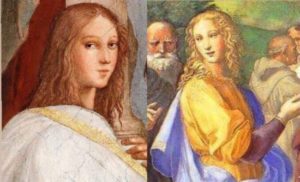
Then, Popes Innocent III (1160-1216) (N° 19), the most powerful pope of the Middle Ages who established the political independence of Rome) and Sixtus IV (1414-1471) (N° 21, Francesco della Rovere by name) rub shoulders with religious figures such as the Dominican Savonarola (instigator in 1494 in Florence of a political revolution (return to the Republic) and moral revolution (rechristianization) or, the painter Fra Angelico (N° 1), contemporary of Savonarola, admired for his frescoes and his sublime paintings, accompanied by Dante Alighieri (N° 20), whose Divine Comedy (with hell, purgatory and paradise) had an influence on theology in the Middle Ages, Donato Bramante (N° 3), the famous architect of St. Peter’s Basilica, not forgetting Pico della Mirandola (N° 6), (mistaken for Francesco Maria della Rovere) who, with his hair blowing in the wind, is pointing towards the Trinity in a light and graceful wiggle. On the right, masons (N° 22), who build churches, bend forward. If on the right, behind the figures, the white marble foundations (Z), allude to the new St. Peter’s Basilica whose reconstruction Julius II has just launched, on the left, a village church (Q) reminds us that Christianity must penetrate the daily life of the humble.
C. PHILOSOPHY
(“SCHOOL OF ATHENS”)

A. Apollo, B. Pallas Athena
Philosophy (« School of Athens »).
1. Porphyry, 2. Plotinus, 3. Alcibiades, 4. Crito, 5. Phaedo of Elis, 6. Socrates, 7. Isocrates, 8. Parmenides,
9. Plato, 10. Aristotle, 11. ?; 12. ?, 13. Apelles of Cos (Raphael), 14. Protogenes (Sodoma), 15. Strabo,
16. Ptolemy, 17. Hippocrates of Chios, 18. Diogenes of Sinope, 19. Heraclitus of Ephesus, 20. Anaximander of Milèt, 21. Pico della Mirandola, 22. Pythagoras, 23. Boethius, 24. Avicenna, 25. Epicurus, 26. Metrodorus.
A beautiful central view perspective shows a get together of 58 Greek and other thinkers in an ideal temple. No chiaroscuro effect disturbs the balance of the colors and the clarity of the composition.
The American thinker Lyndon LaRouche (1922-2019), during his visit to the Vatican, marveled at the graceful harmony that radiates from this work. It could not help but resonate with a concept LaRouche developed throughout his life: that of the « simultaneity of eternity »; the poetic idea that « immortal » ideas continue their dialogue in a place beyond material time and space.
According to historians, Raphael, faced with the Herculean task of creating this series of portraits, and lacking reliable visual data about the figures to be portrayed, sent one of his assistants to Greece to collect indications and provide him with documentation to meet the challenge.
Small detail: the event doesn’t take place in Athens or Greece, but in Rome. The architecture is clearly inspired by the church of Sant’Andrea of Mantua, renovated shortly before his death by Leon Battista Alberti (1404-1472) and by Bramante‘s plans for the reconstruction of St. Peter’s Basilica in Rome. It is Rome set to become the new Athens.

Although the steps can be found in the preparatory drawings, the large arches with their coffered vaults, typical of the dome of the Roman Pantheon, do not appear. Another probable source of inspiration is the arches, also with coffered vaults, the Basilica of Maxentius and Constantine, built in Rome at the beginning of the 4th century to reaffirm the power of the beauty of the Eternal City.
It is not excluded that Bramante himself, who had made a tromp-l’oeil using this type of pattern in the apse of the church of Santa Maria presso San Satiro in Milan, designed them in person. With three arches (tetrad) and seven rows of caissons, Pythagorean numerology is never far away.
Visually, the ensemble is divided in two. The audience is on the same level as the foreground, a paved parterre behind which a very wide staircase leads to a raised forecourt. For the viewer, a slightly cavalier perspective reinforces the monumental dimension of the figures on the upper level. This setting is inevitably reminiscent of a theater stage.
The actors, arriving from the old world, can enter the stage on one side, under the statue of the Greek god Apollo (A), god of light, and leave on the other, towards the new world, under the statue of Pallas Athena (B), which became Minerva in Roman times, protector of the Arts, to exchange ideas with each other, address the audience or climb the stairs and leave through the back.
In the center of the square and in the center of a perspective with a central point of view, Plato (N° 9) and Aristotle (N° 10) don’t confront each other but move forward, side by side, towards the viewers (and the Triumphant Church on the opposing wall).
The first one, with the Timaeus in his hand, points a finger towards the sky, meaning that beyond the visible, a higher principle exists. The second one extends his arm and his hand horizontally underlining that all truth comes to us from the testimony of the senses, while carrying the Ethics with the other arm.
Strangely, these are the only two books in the stanza whose names appear in Italian (Timeo, Etica) and not in Latin. As the art critic Eugenio Battisti (1924-1989) observed:
If we (…) examine the titles of the works respectively held by Plato and Aristotle, we see the philosopher of the Academy holding the Timaeus, that is to say the most Aristotelian and the most systematic of his works and the Stagirite, the Nicomachean Ethics, that is to say the most Platonic of his works.
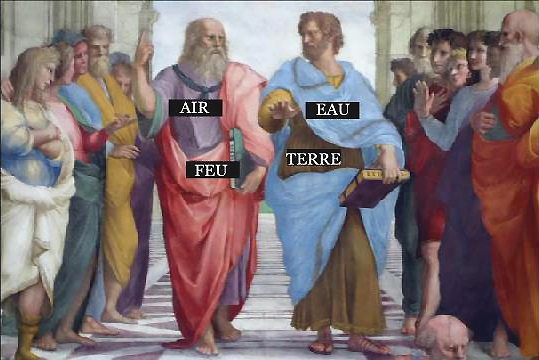
The colors of the clothes of the two philosophers symbolize the four elements: Plato is dressed in red (fire) and purple (ether); Aristotle in blue (water) and yellow (earth).
If the whole fresco cuts the world in two between Platonists and Aristotelians, both walk together towards what is in front of them and behind the spectator who looks: towards the fresco of Theology with the Trinity in the center without forgetting the monstrance and the imposing altar on which is marked « JV-LI-VS PON TI CUS ». How generous of the Church to welcome so many pagans into its midst!

Raphael however communicates a great sense of movement. In the same way that the Dutch painter Rembrandt, in his 17th century masterpiece The Company of Captain Frans Banning Cocq, known as The Night Watch, broke with the formal representations of the dignitaries of the city guilds, Raphael here drew a line under the frozen and static representations of the series of « great men » often decorating the palaces and libraries of the great princes and lords in the style of his master Perugino.
His fresco, like Leonardo’s Last Supper in Milan, is organized as a sequence of small groups of three or four people conversing with a great thinker or each other, never out of sync with what is happening around them. In this sense, Raphael translated into images, and thus made accessible to the eyes of the spectators, that harmonic unity transcending the multiple so sought after by the commissioners.
Raphael and Inghirami did not hesitate to use portraits of people living in their time to represent historical figures. In addition to themselves, there are their patrons, colleagues and other personalities whom they hoped to please or charm.
In the foreground, four groups are shown.

On the left, Epicurus (N° 25), here with the features of Inghirami writing the setting of the play. Born in Samos like Pythagoras, he wears here, not a crown of laurels, reward given to great orators, but a crown of oak leaves, symbols that we find in the coat of arms of pope Julius II.
Some historians believe that Inghirami was a Dionysian follower of Orphism, another pre-Socratic current. Dionysus is indeed the brother of Apollo and according to some, their teachings are one and the same.
As mentioned above, shortly after Raphael’s death (1520), Cardinal Jacopo Sadoleto published a treatise in which Inghirami defends rhetoric and denies any value of philosophy, his main argument being that everything written is already in the mystical and mythological texts of Orpheus and his followers.
In Rome, the scholars of the time knew Epicurus mainly through their readings of Cicero for whom Epicurus was not a debauchee but someone who sought the noblest pleasure. Cicero had a friendship with an Epicurean philosopher, a certain Phaedrus, as it happens the nickname of Inghirami…
Finally, on the extreme left, there is an old bearded man, the Greek thinker Metrodorus (N° 26), disciple of Anaxagoras and for whom it is « the acting spirit » that organized the World. In front of him, a newborn baby. Together they could symbolize the birth of truth (the child) and wisdom (the old man) and experience.
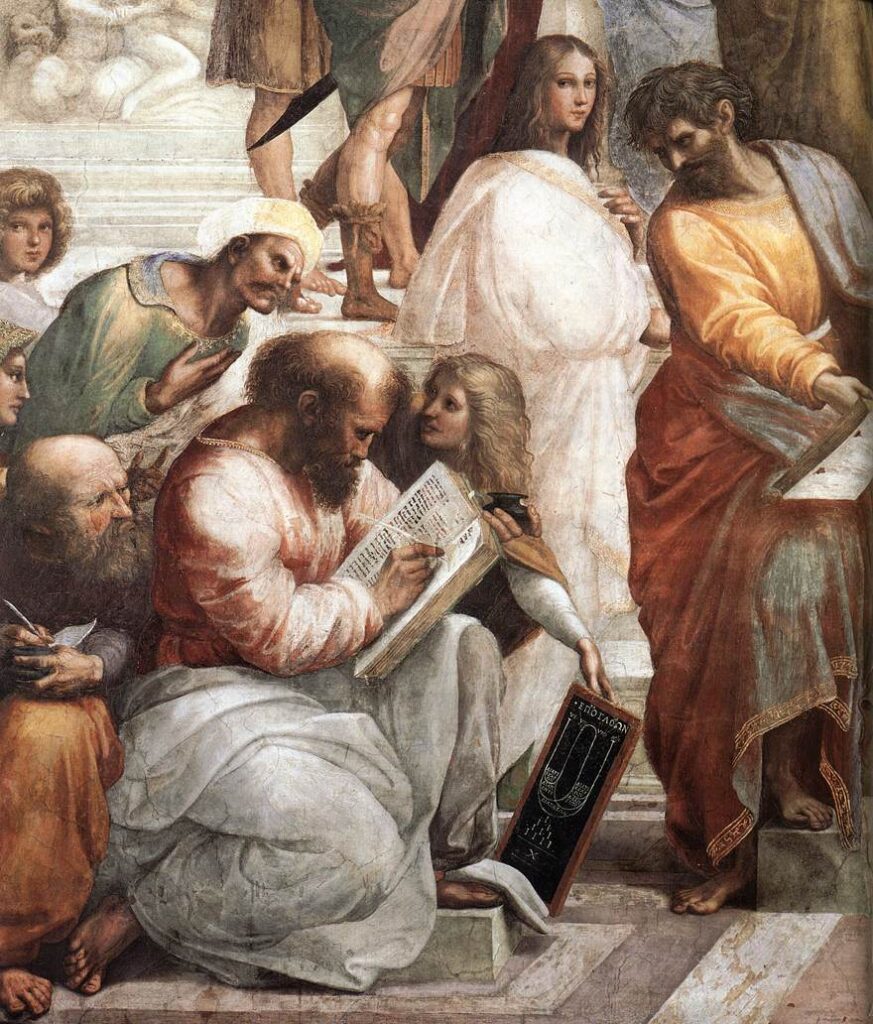
Next to him, a little more in the center, the imposing figure of Pythagoras (N° 22) (whom the Italian historian Georgio Vasari mistook for the evangelist Saint Matthew), seated with a book, an inkwell and a pencil, writing surrounded by visibly intrigued people. Behind him, seated on the left, an old man, representing Boethius (N° 23), Roman author, in the sixth century, of a treatise on music, the first part of which evokes « the harmony of the spheres », tries to look at what he is writing in his book. Without capturing a moment of potential transformation, as Leonardo knew how to do, the scene is obviously inspired by his unfinished painting, the Adoration of the Magi.
At his feet, a black slate with the famous Tetraktys and a diagram of musical intervals (see our section in this article on Pythagoras).
Since it is totally unthinkable that it is Averroes (banned from the Church, as said, by Aquinas), the turbaned man who seems to admire him could be Avicenna (Ibn Sina) (N° 24). This Persian physician, influenced by the thought of both Hippocrates and Galen, in his Qanûn (of Medecine), operates a vast medico-philosophical synthesis of Aristotle‘s logic (which he corrects) and neo-Platonism, compatible with monotheism.
It could also be Al Fârâbi (872-950), another Arab scientist and musician who sought to reconcile faith, reason and science with the philosophy of Plato and Aristotle, whose translations from Greek into Arabic he had made. Avicenna admired him and the title of one of Al Fârâbî’s works leaves no ambiguity: The Harmony of the Opinions of the Two Sages: Plato the Divine and Aristotle.
Moreover, given his position on the side of the Platonists, although he wears a white turban, it is totally excluded that he is Averroes (Ibn Rushd), an author struck down by Aquinas (see the paintings showing The Triumph of Saint Thomas) and then by the Neoplatonists of Florence for having denied the immortality of the individual soul.
More in the center of the fresco, two isolated figures immersed in their thoughts. The first, on the left, appears to have been added later by Raphael and is not in his drawing. The man is dozing on a cube, a Pythagorean volume par excellence. It is thought to be Heraclitus of Ephesus (No. 19) (an Ionian pre-Socratic for whom « there is nothing permanent but change ») with the features of Michelangelo. This sculptor fascinated Raphael, not only for his gifts in drawing, anatomy and architecture, but also for his spirit of independence from a pope he considered tyrannical.
It should be noted that the Moses that Michelangelo sculpted for the tomb of Julius II is said to be looking at him with anger because the artist captured the moment when Moses, coming down from Mount Sinai with the Tables of the Law, noticed that the Hebrew people had returned to worshiping idols, such as « the Golden Calf ». Irritated by this return to idolatry, Moses broke the Tables of the Law.
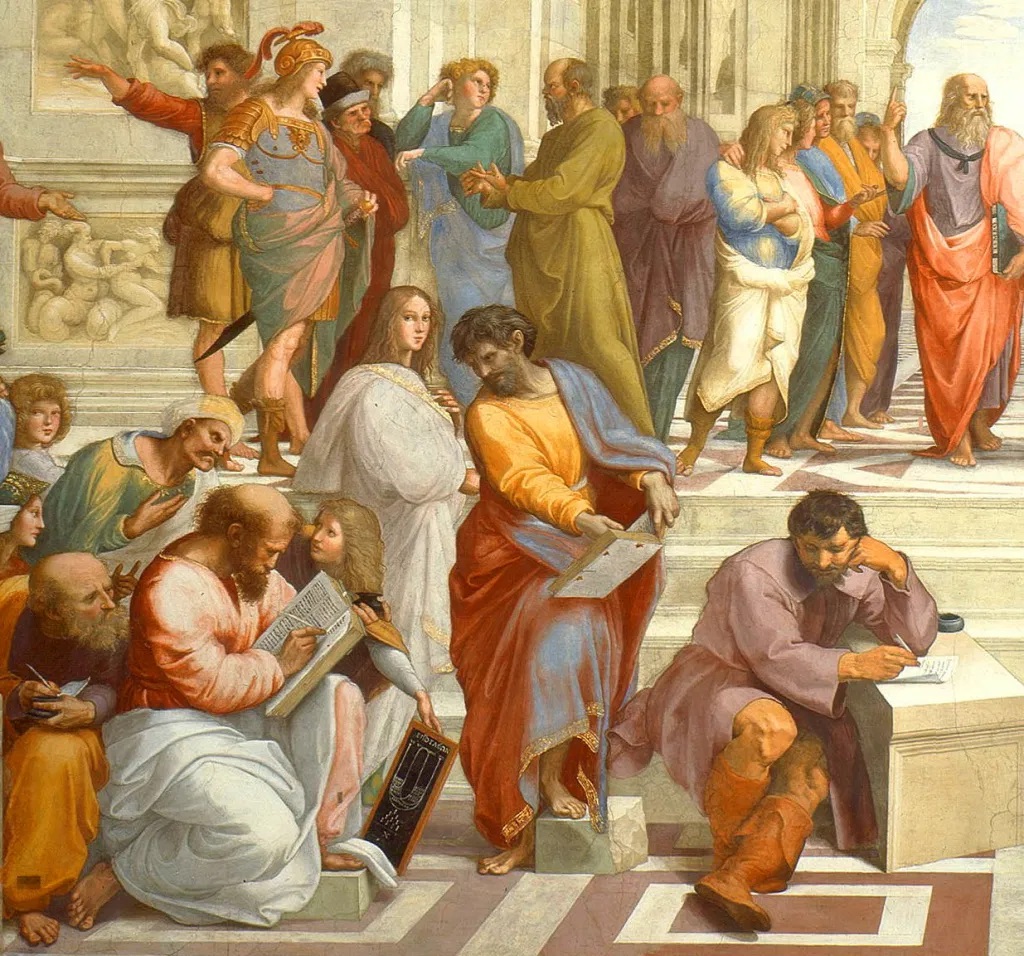
One detail raises questions: Anaximander of Miletus places his right foot on a cubic block of marble whose volume seems to be eight times smaller than the one on which Heraclitus of Ephesus rests. However, to solve the problem of Delos (the duplication of the volume of the cube) it is necessary to wait for the Pythagorean and friend of Plato, Archytas of Taranto.
Anaximander of Miletus (N° 20) (and not Parmenides), also a representative of the Ionian school, stands behind Heraclitus and seems to contest the demonstration of Pythagoras (representative of the so-called « Italian » school). Behind him, a young man with long hair, looks at the spectator. Dressed in a white toga, an attribute of the Pythagoreans, he is once again Pico della Mirandola (N° 21), triumphant and surrounded by Pythagoras and two of his disciples. Legend has it that Raphael portrayed Hypatia of Alexandria (c. 370-415), a mathematician who headed the Neoplatonist school in Alexandria. When one of the cardinals examined the painting and knew that the woman depicted was Hypatia, he is said to have ordered that she be removed from it. Raphael is said to have obeyed, but replaced her with the effeminate figure of a nephew of Pope Julius II, Francesco Maria Della Rovere, future Duke of Urbino…
If this is really Pico della Mirandola, it would be a superb piece of praise, for appearing in both Philosophy and Theology, the two images of Pico, reminiscent of the kneeling angel looking at the viewer while pointing at St. John the Baptist in Leonardo’s Madonna of the Rocks, can contemplate each other!
The second isolated figure, nonchalantly spread out on the stairs, is the cynical and hedonistic philosopher Diogenes of Sinope (N° 18), here presented as an ascetic, but in the Aristotelian tradition.

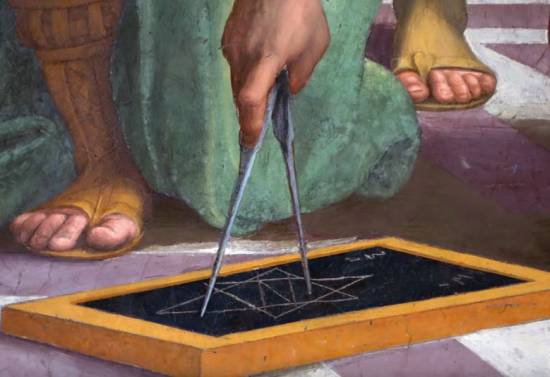
Then, in the center right, an inspiring group of young people, amazed by their discoveries and exchanging their complicit glances with their comrades, around a surveyor who is examining or drawing with a compass parallel lines inside a hexagonal star on a slate laid on the ground.
This is an illustration of a theorem that neither Euclid (an Aristotelian) nor Archimedes mentioned, although the identity of one or the other is attributed to this figure in the guise of the architect Donato Bramante.
It could be, it is my conviction, the geometer Hippocrates of Chios (N° 17) of which Aristotle speaks in great good. He wrote the first mathematics textbook, entitled The Elements of Geometry. This work precedes Euclid’s Elements by a century. Unless we are talking about the architect Leon Battista Alberti, whose church in Mantua may have inspired Bramante and after all, author, in 1435, of De Pictura, a treatise (of Aristotelian spirit) on perspective.
However, in 1485, in his treatise on architecture De re Aedificatoria, Alberti, in a passage (IX, 5) that may have been of interest to the author of the fresco, stressed that:
“Beauty consists in a harmony and in an agreement of the parts with the whole, in accordance with determinations of number, proportionality and order such as the harmony requires it, that is to say the absolute and sovereign law of the nature.”

Finally, to add to the mystery, on the collar of the tunic of this figure can be read: « R.V.S.M. » (Raphael Vrbinas Sua Manu), meaning « By the Hand of Raphael of Urbino »).
For what the surveyor is addressing on the slate is the role played by the diagonals of the hexagon. The answer is provided by the geometrical composition, in the form of a hexagon, which underlies the entire construction of the perspective of the fresco.
The diagonals show a beautiful complementarity between the arithmetic mean and the harmonic mean (see authors diagram below).
It is a masterly demonstration in the field of the visible, of the concept structuring the whole theme of the work: complementarity, the foundation of universal harmony.
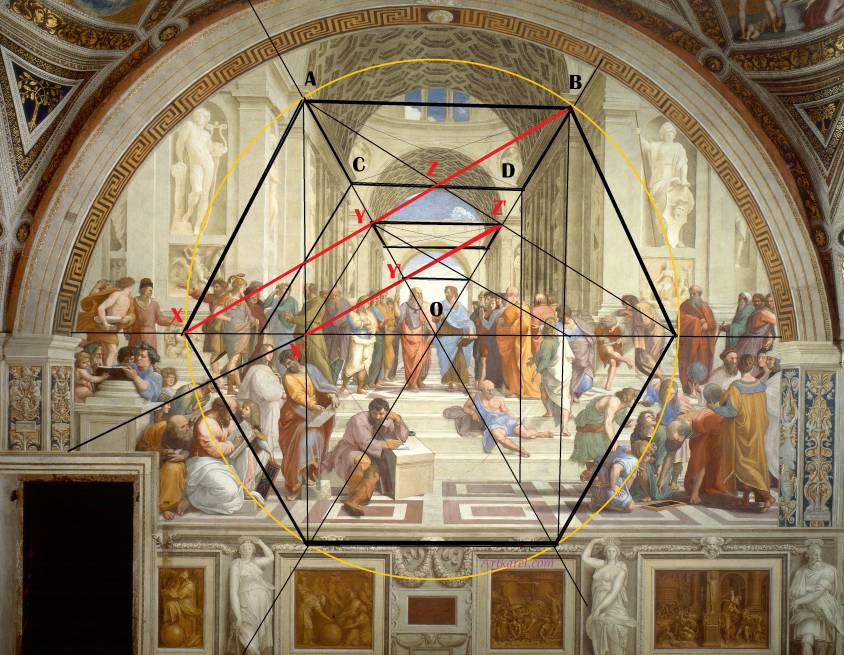
Credit: Karel Vereycken
On the right, the geographers Ptolemy (No. 16) and Strabo (No. 15) (in the guise of Baldassare Castiglione, the head of the Pope’s army and a friend of Raphael’s?), who is identified without real evidence with Zoroaster but to whom Pico della Mirandola indeed refers, stand face to face. The first shows the Earth as a sphere, the second a globe of the Heavens.
Finally, on the far right of the first register, with the features of Raphael, the legendary painter of the court of Alexander the Great, Apelles of Cos (N° 13). It should be remembered that, during his lifetime, Raphael was nicknamed « the Apelles of his time ». Next to him, his rival, the Greek painter Protogenes (N° 14) in the guise of Raphael’s colleague, the sulfurous but virtuoso fresco artist Sodoma. Coming from the world of the craftsmen, it is a question here of marking the entry of two painters-decorators into « the court of the big guys » and making their first steps in the world of philosophy.

On the steps, the central subject, as we have said, Plato and Aristotle. Plato‘s features in the fresco have nothing to do with any supposed portrait by Leonardo da Vinci. Leonardo was born in 1452 and was only 56 years old when the fresco was painted. Raphael is said to have used the image of a bust of Plato discovered in Athens in the ruins of the ancient academy. In reality, the famous drawing of an old man (Turin), supposed to be a self-portrait of Leonardo and resembling the image of Plato in the School of Athens, has been proven to date from the 19th Century.
In the crowd to the left of Plato is Socrates (no. 6), his teacher, whose face was known to everyone from Roman statues. The identification of the other figures remains largely hypothetical. One thinks of the speakers of Plato‘s dialogues. Close to Socrates, his old friend Crito (N° 4). Behind Socrates, the Athenian intellectual Isocrates (N° 7) who had withdrawn from political life and although close to Socrates, set himself up as Plato‘s rival. Close to the latter, the five interlocutors of Plato‘s dialogue, Parmenides. Among them, Parmenides (N° 8), considered at the origin of the concept of the One and the multiple, and the pre-Socratic thinker Zeno of Elaea, known for his philosophical paradoxes.
The Athenian general (here dressed as a Roman soldier) Alcibiades (N° 3) and the young man in blue could be Phaedo of Elis (N° 5) or Xenophon, both listening to Socrates counting on his fingers, a gesture suggesting his famous dialectic.
All around the Greek thinkers, other figures are stirring. Behind general Alcibiades, a figure (perhaps a librarian) holds back another running figure, begging him not to disturb the ongoing exchanges between philosophers and scientists.
At the far left, a man with a hat enters the stage. It could be Plotinus (N° 2), a founding figure of Neoplatonism admired by cardinal Bessarion, accompanied by Porphyry (N° 1), another Neoplatonist who brought his biography of Pythagoras as a messenger from the ancient world.

Here the giornata of the School of Athens.
D. JUSTICE
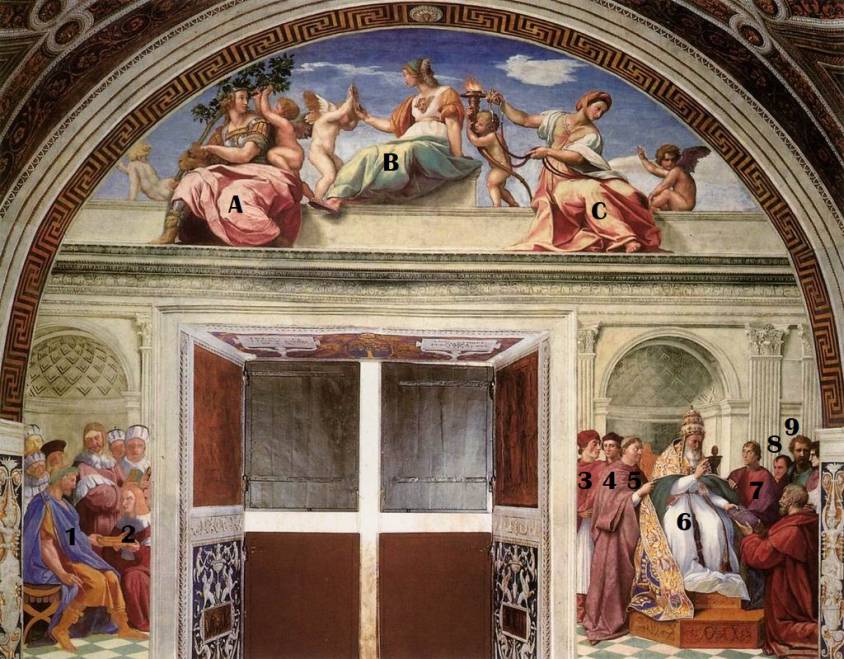
A. Fortitude, B. Prudence and C. Temperance.
1. Justinian, 2. Tribonian, 3. pope Paul III, 4. Antonio Del Monte,
5. pope Leo X, 6. pope Gregory IX (Julius II), 7. pope Clement VII.
On top, in the lunette (half moon), the three virtues represented would be Fortitude (A), Prudence (B) and Temperance (C). Together with Justice, they constitute the four cardinal (profane) virtues. The central female figure, holding a mirror, refers to Prudence. On the left, Fortitude holds an oak branch, an allusion to the della Rovere family from which Julius II, the pope who commissioned the frescoes, descended.
Below, once again, complementarity is at work. On the left, painted by Lorenzo Lotto, the Roman emperor Justinian I (N° 1) receives the Pandects (the civil law) from the Byzantine jurist Tribonian (N° 2).
On the right, in the guise of Julius II, Pope Gregory IX (N° 6) promulgates the Decretals; a masterly sum of canon law which he had ordered to be compiled and published in 1234.
On his right (thus on the left of the spectator), one sees a cardinal, in purple dress, having the features of the cardinal Jean de Médicis, future pope Leo X (N° 5). The two other cardinals behind him would be Alessandro Farnese, the future pope Paul III (N° 3), and Antonio Del Monte (N° 4). And to his left (right for the viewer) a cardinal representing Cardinal Julius de Medici, the future Pope Clement VII (N° 7). With your image immortalized on a fresco in the right place, your career to become pope would seem to be better engaged!
The fact that Julius II is represented wearing a beard allows to date the fresco beyond June 1511. Indeed, the pontiff, who left Rome beardless to wage war, then let his beard grow and vowed not to shave it off until he had liberated Italy. He returned to Rome in June. Historians point out that the prominence of the pope’s portrait indicates how the theme of the decoration of the Chambers was transformed, around 1511, into that of the glorification of the papacy. Hence, in this way “Justice” becomes the right of Julius II to impose « his » justice.
E. POETRY
(« PARNASSUS”)
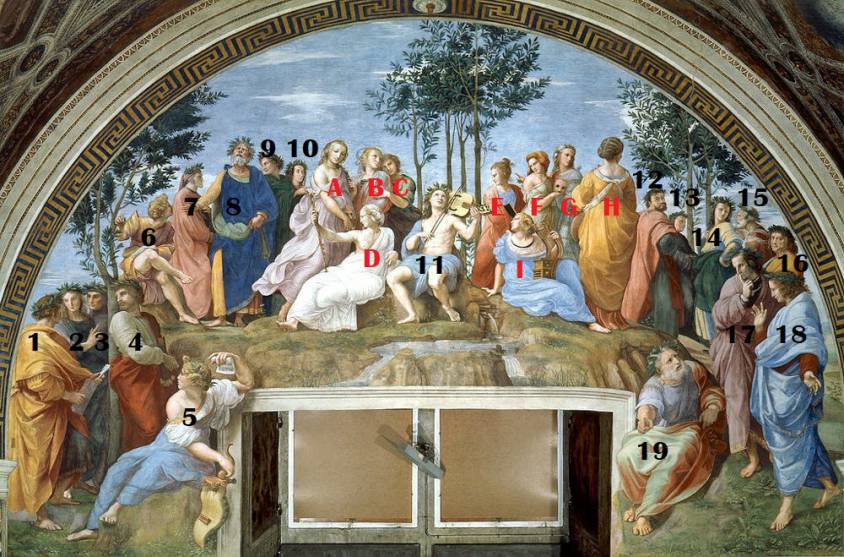
The poets:
1. Alcaeus of Mytilene, 2. Corinna, 3. Petrarch, 4. Anacreon, 5. Sappho, 6. Ennius, 7. Dante, 8. Homer, 9. Virgil, 10. Statius (Poliziano), 11. Apollo, 12. Tebaldeo, 13. Boccaccio, 14. Tibullus, 15. Ariosto,
16. Propertius, 17. Ovid, 18. Sannazaro, 19. Pindar.
The nine muses:
A. Thalia, B. Clio, C. Euterpe, D. Calliope, E. Polyhymnia, F. Melpomene, G. Terpsichore, H. Urania. I. Erato.
A window reduces the space available for the fresco to a large lunette where the characters are divided into small groups on a semi-circular line.
The underlying idea here, taken from St. Thomas, is that truth is made accessible to man, either by Revelation (Theology) or by Reason (Philosophy). For the Neoplatonic school, this truth manifests itself to our senses through Beauty (poetry and music).
The scene painted here takes place near Delphi, at the top of Parnassus, the sacred mountain of Apollo and home of the Muses of Greek mythology.
The large window around which the fresco is organized offers a view, beyond the cortile (small circular temple) of Bramante, on the hill of Belvedere (Mons Vaticanus), where shows were given and where, in ancient times, Apollo was honored, which earned him the name of Apolinis.
Apollo is the patron of musicians: « It is through the Muses and the archer Apollo that there are singers and citharists », says Hesiod. He even inspires nature: when he passes by, « the nightingales, swallows and cicadas sing ». His music soothes the wild animals and moves the stones. For the Greeks, music and dance are not only entertainments: they allow to heal men by tuning the discords that eat away at their souls and thus to bear the misery of their condition.
At the top of the hill, seven laurels. Near the Castalia spring, Apollo (N° 11), crowned with laurel leaves and in the center of the composition, is tuning around him the nine muses (A to I) playing on his lyre.
On the left side Calliope (D), the one « who has a beautiful voice » and represents the epic poetry, and on the right, Erato (I), « the lovable one » who represents the lyric and erotic poetry as well as the nuptial song. Each presides over the tuning of the other’s chorus: on the left, behind Calliope, Thalia (A) (« the flourishing, the abundant »), Clio (B) (« who is famous » and represents history) and Euterpe (C) (« the joyful » who represents music). Finally, just behind Erato, Polyhymnia (E) (« the one who says many hymns » and represents rhetoric, eloquence and pantomime), Melpomene (F) (« the singer » who represents tragedy and song); Terpsichore (G) (« the charming dancer ») and Urania (H) (« the celestial one » who represents astronomy).
And you don’t have to be Pythagoras to count 7 laurels on the mountain and remember that nine muses plus Apollo make… ten.
As one of the square frescoes on the ceiling reminds us, Apollo had triumphed over Marsyas in a fight to seize the lyre, considered as the divine instrument capable of leading souls to heaven, better than the flute which only excites the lower passions. By detaching the man from his immediate material concerns, the victorious lyre allowed to arouse the divine love in men. In addition, the Romans knew of a seven-stringed lyre, a Pythagorean legacy, the number seven referring to the seven heavenly bodies orbiting the central fire.

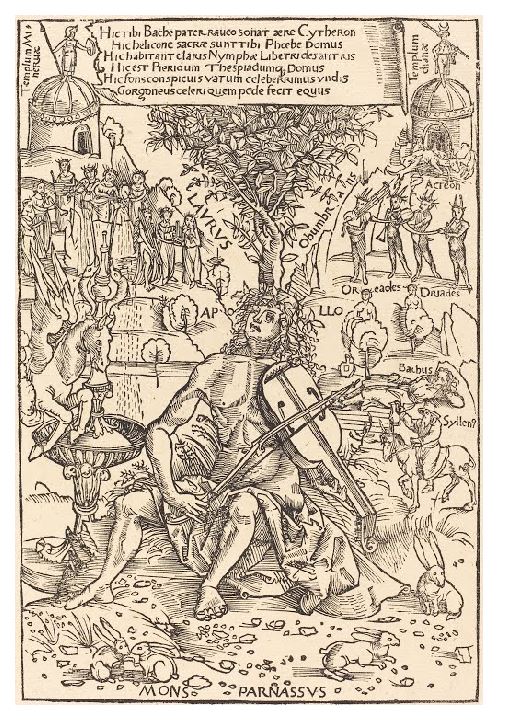
However, strangely enough, Apollo is not holding a traditional four-stringed lyre, but a lira da braccio. If Apollo plays here the lyre with arms, the muses Calliope, Erato and the sibyl Sappho hold lyres identical to those of the sarcophagus known as « of the Muses » of the Museo delle Terme in Rome.
In many representations of the 16th century, the lyre is played by a group of angels or mythological characters, such as Orpheus and Apollo, but also King David, Homer or the Muses. Among its interpreters, we can count Leonardo da Vinci. The instrument is essentially designed like a violin, but with a wider fingerboard and a flat bridge that allows for chordal playing. The lyre generally has seven strings: four like a violin, augmented by an additional low string (making five), and two strings beyond the fingerboard, which are not played but serve as a drone and resonate in the octave. Now, Raphael, in order to create a perfect harmony with the number of muses around Apollo, will increase the number of strings from seven to nine, that is to say seven adjustable plus two drones. This detail concerning the lyre seems to have been modified in time. Indeed, an engraved reproduction, from 1517, probably from drawings prior to the fresco, or from its preliminary project, by Marcantonio Raimondi, reveals a state quite different from what we see today.

The composition is less dense and highlights, like the School of Athens, several groups of three figures each. What is striking at first is that the ancient lyre played by Apollo with his fingers rests on his thigh, while in the present version, Apollo vibrates the strings of his lira da braccio with a bow, while looking up to the sky, in accordance with the fresco on the ceiling where are inscribed the words of Virgil: « Inspired by the spirit » (NVMINE AFFLATVR).
All around, eighteen poets are divided into several groups. The identification of some is unequivocal, that of others more doubtful. They are all chained to each other by gestures and looks, forming a kind of continuous crescent.
At the top left, the father of Latin poetry Ennius (N° 6), seated, listens raptly to the song of Homer (N° 8), while Dante (N° 7), further back, looks at Virgil (N° 9) who turns towards him, the Roman poet Statius (N° 10), in the guise of Poliziano, at his side. The latter was a disciple of the florentine Neoplatonist Marsilio Ficino. To represent the historical figures, Raphael drew inspiration from Roman statuary. For the face of Homer, for example, he adopted the dramatic expression of the Laocoon, which he had found in Rome in 1506.
At the bottom left are the Greek poet Alcaeus of Mytilene (N°1), the Greek poetess Corinna (N° 2), Petrarch (N° 3) as well as the Greek poet Anacréon (N° 4). In the final version, two characters who leave the frame came to enrich the composition. On the left, the sibyl Sappho (N° 5) as indicated by a tablet. Considered the first poetess of ancient Greece, she lived in the seventh and sixth centuries BC. According to the Homeric Hymns, it is her who would have built the first lyre to accompany the poetic recitation. The only woman in entire fresco is painted with a monumentality that is reminiscent of Michelangelo in the Sistine Chapel.
Sappho is the counterpart of Pindar (N° 19), and not Horace as is claimed, considered one of the greatest lyric poets of Greece and for whom Apollo was the symbol of civilization. Pindar is here in conversation with the Italian poet Jacopo Sannazaro (N° 18), dressed in blue and standing, and above them Ovid (N° 17).
On the right, on the side of the mount, besides Pindar, Sannazaro and Ovid, five other poets and orators : Antonio Tebaldeo (N° 12), with his back turned towards Apollo and under the features of Baldassare Castiglione ? ), Boccaccio (N° 13), behind, Tibullus (N° 14), Ariosto (N° 15), Propertius (N° 16), under the features of the cardinal poet very « Petrarquist » Pietro Bembo, a friend of Inghirami and enemy of Erasmus, and at his sides two unknown poets said « poets of the future judging the past ».
The identification of these characters remains largely hypothetical and controversial. To arrive at satisfactory results, it would be necessary according to the historian Albert Chastel, to find precise correspondences between the nine muses, nine classic poets and nine modern, in addition to the grouping by poetic genre.
After the death of Julius II, Pope Leo X made the Stanza della signatura his music room, replacing the books of his predecessor (which were moved to the large library on the lower floor) with intarsiae. Leo X will also have the pavement completed.
F. THE MOSAIC ON THE FLOOR
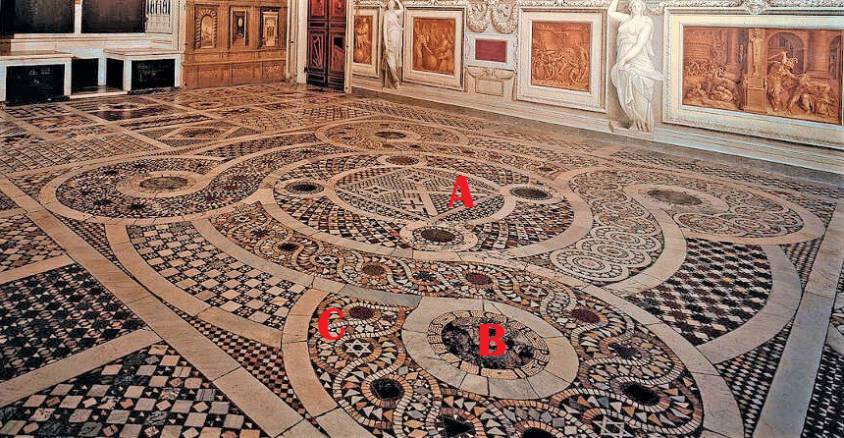
A. Coat of arms of the pope, B. Spiral arm, C. Star of David, reference to the Jewish heritage.

The mosaic decorating the floor is said to be « cosmatesque », after the name of Cosmati, an old family of craftsmen and specialized in mosaics with four colors. Some materials come from Roman ruins, the green marble of the Peloponnese in Greece, the porphyry of Aswan in Egypt, and the yellow marble of North Africa. The white marble comes from the famous marble quarries of Carrara where Michelangelo chose his materials.
As on the ceiling, in the center of the room the coat of arms of the pope (A), this time inside a square (his earthly reign) inscribed in a circle (his theological mission). This first circle is surrounded by four spiral arms, each of which creates a new circular motif (B). This pattern is believed to be of Jewish origin. The Star of David (C) appears several times in this creation vortex. The doctrine of the four worlds, described in cabalistic cosmology, underlines their dynamic unity.
After all, for Giles de Viterbe, the recent discovery of Jewish mystical writings was of the same importance as the discovery of America by Christopher Columbus. Let us recall that for Julius II, like Plato and Pythagoras, Moses, whom Michelangelo sculpted for his tomb, already announced the later triumph of the Church of Rome which would, under his direction, synthesize them.
Conclusion
Thus, the whole theme of the « Chamber of the Signature » finds its full coherence with the idea of harmony and concordance. But when we look more closely, we see that it is only a question of « complementarity » at the level of forms and in the service of a temporal power disguised as a divine mission. Raphael, a talented painter, submitted to this by providing the product for which he was paid. He would end up painting things increasingly decadent by submitting to the pagan whims of the papal banker Agostino Chigi for the decoration of his villa, the Farnesina.
With the « Chamber of the Signature », we are far from the famous « coincidence of opposites » dear to Pythagoras, Plato, Nicholas of Cues and today Schiller Institute’s President Helga Zepp-LaRouche, which allows, in an uncompromising search for truth and for the love of humanity, to overcome paradoxes and solve a great number of problems from a higher point of view.
By piling up allegories and symbols, if it impresses, this masterly work ends up suffocating us. By the rules of its composition, it can only sink into the theatrical and the didactic. In a universe purged of the slightest irony or surprise, no real metaphor will be able to awaken us. And although Raphael tried to bring some life into it, the spectator is fatally left with a vast sediment of fossilized ideas, as dead as the most glorious ruins of the Roman Empire.
Brief bibliography:
- Julius II, Ivan Cloulas, Fayard, Paris 1990;
- Léon X et son siècle, Gonzague Truc, Grasset, Paris, 1941;
- Une histoire des empires maritimes, Cyrille P. Coutensais, CNRS, 2013;
- L’Humanisme, l’Europe de la Renaissance, André Chastel and Robert Klein, Editions Skira, Geneva, 1995;
- L’Arétin ou l’insolence du plaisir, Bertrand Levergeois, Fayard, Paris, 1999;
- Giorgio Vasari, l’homme des Médicis, Grasset, Paris, 1995;
- Marsile Ficin et l’Art, André Chastel, Droz, Geneva, 1996 ;
- Raphael and the Pope’s librarian, Nathaniel Silver, Ingrid Rowland, Paul Holberton Publishing, 2019;
- Raphael’s Stanza della Signatura, Meaning and Invention, Christiane L. Joost-Gaugier, Cambridge University Press, 2002;
- Pythagoras and Renaissance Europe, Finding Heaven, Christiane L. Joost-Gaugier, Cambridge University Press, 2009;
- Raphael, Stephanie Buck and Peter Hohenstatt, Könemann, 1998;
- The Intellectual Background of the School of Athens: Tracking Divine Wisdom in the Rome of Julius II, Ingrid D. Rowland, 1996;
- Pagans in the Church: The School of Athens in Religious Contex, Timothy Verdon, 1996;
- Raphael’s School of Athens, Marcia Hall, Cambridge University Press, 1997;
- Raphael, Konrad Oberhuber, Editions du Regard, Paris, 1999;
- L’énigme de la Segnatura, Raphael and Sodoma, André-Charles Coppier, Paris, 1928;
- Raphael, John Pope-Hennessy, Harper & Row, London, 1970;
- Who was Raphael, Nello Ponente, Editions Skira, Geneva, 1967:
- Lives and doctrines of the illustrious philosophers, Diogenes Laërtius, La pochothèque, Paris, 1999;
- Erasmus and Italy, Augustin Renaudet, Editions Droz, Paris, 2000 ;
- Erasmus among us, Léon Halkin, Fayard, 1987 ;
- Comment la folie d’Erasme sauva notre civilisation, Karel Vereycken, 2005 ;
- The egg without shadow of Piero della Francesca, Karel Vereycken, 2007;
- Albrecht Dürer against neo-platonic melancholy, Karel Vereycken, 2007.
NOTES:
* For an in-depth treatment of the subject, see Karel Vereycken, Albrecht Dürer against Neo-Platonic Melancholy, 2007.
**We can see here where certain sects, notably Rudolf Steiner’s Anthroposophists, draw their inspiration. Some still insist on demonstrating that Pythagoras, who believed in the transmigration of souls and therefore their possible reincarnation in animals or plants, was a vegetarian. Diogenes Laertius tells us that one day, « passing by someone who was mistreating his dog, it is said that he [Pythagoras, in a joking tone] was moved by compassion and addressed the individual with these words: ‘Stop and do not strike again, for it is the soul of a man who was my friend, and I recognized him by hearing the sound of his voice’ « . A whole series of authors ended up falling into numerology and irrational esoteric mumbo-jubo, in particular Francesco Zorzi, Agrippa of Nettesheim and Paracelsus.
Raphaël 1520-2020 : ce que nous apprend « L’Ecole d’Athènes »


A l’occasion du cinq-centième anniversaire de la mort du peintre italien Raffaello Sanzio da Urbino (1483-1520), plusieurs expositions mettent à l’honneur cet artiste, notamment à Rome, Milan, Urbino, Belgrade, Washington, Pasadena, Londres, ou encore à Chantilly en France. Mais que sait-on réellement de l’intention et du sens de son œuvre ?
Introduction

Il est incontestable que, dans la conscience collective occidentale, Raphaël, aux côtés de Michel-Ange et Léonard de Vinci, s’érige comme un des artistes les plus géniaux incarnant sans doute le mieux la « Renaissance italienne ».
Bien que mort à l’âge de 37 ans, Raphaël a pu dévoiler au monde son immense talent, en particulier en réalisant, entre 1509 et 1511, plusieurs fresques monumentales au Vatican, la plus célèbre d’entre elles, longue de 7,7 mètres et haute de 5 mètres, est connue sous le nom de L’Ecole d’Athènes.
Le spectateur se trouve à l’intérieur d’un édifice réunissant la pensée de l’humanité toute entière : unis dans un espace hors du temps, une cinquantaine de philosophes, de mathématiciens et d’astronomes de tous les âges s’y rencontrent pour échanger sur leur vision de l’homme et de la nature.
L’image puissante que dégage cette fresque incarne tellement « l’idéal » d’une République démocratique, qu’en France, lors de la révolution de février 1848, le tableau représentant Louis Philippe – suspendu derrière le Président de l’Assemblée nationale – fut décroché et remplacé par une copie de la fresque de Raphaël, sous la forme d’une tapisserie de la Manufacture des Gobelins, réalisée entre 1683 et 1688 à la demande de Jean-Baptiste Colbert, fondateur de notre propre Académie des Sciences.

Ensuite, en France, est apparue l’idée que Raphaël, « le Prince des peintres », incarne « l’artiste ultime ». Bien mieux que Rubens ou le Titien, Raphaël aurait su réaliser la subtile « synthèse » entre « la grâce divine » d’un Léonard de Vinci et la « puissance sourde » d’un Michel-Ange. Qui dit mieux ? Une observation vraie tant qu’on se penche uniquement sur la pureté des « formes » et donc du « style ». Adoré ou détesté, Raphaël fut érigé en modèle à imiter par tout jeune talent fréquentant nos Académies des Beaux-Arts.
Tout ceci a contribué au fait que depuis cinq siècles, artistes, historiens et connaisseurs n’ont cessé de commenter et souvent s’affronter, non pas sur l’intention ou le sens des œuvres de l’artiste, mais sur son style ! A la manière de certains de nos contemporains qui adorent Star Wars sans prêter attention à l’idéologie que, sournoisement, cette série véhicule…
Pour ces historiens-là, « l’iconographie », cette branche de l’histoire de l’art qui s’intéresse aux sujets représentés, aux interprétations possibles des compositions à partir de détails particuliers, n’était vraiment utile que pour apprécier la peinture « plus primitive », c’est-à-dire celle des « Écoles du Nord »…
On sait bien, surtout en France, qu’une fois que la « forme » prend l’apparence de la perfection, peu importe le contenu ! Tel ou tel écrivain raconte des horreurs abjectes, mais « c’est tellement bien écrit ! »
La bonne nouvelle, c’est que depuis une vingtaine d’années, une poignée d’historiens et surtout d’historiennes d’art de premier plan, ont entrepris et publié de nouvelles recherches.
Je pense en particulier à Marcia Hall (Temple University), Ingrid D. Rowland (Université de Chicago), le révérend Timothy Verdon (Florence et Stanford), l’historien jésuite John William O’Malley et surtout à Christiane L. Joost-Gaugier. Son livre Raphael’s Stanza della Signatura, Meaning and Invention (Cambridge University Press, 2002), que j’ai pu lire grâce au confinement, m’a permis d’ajuster certaines pistes et intuitions que j’avais résumées en 2000 dans une note, avouons-le, assez brouillonne.
Si mon travail se résumait à tenter de donner un peu de cohérence à ce qui se trouve dans le domaine public, par un travail d’archives assidu au Vatican et ailleurs, ces historiennes, pour qui ni le latin ni le grec n’ont de secrets, ont largement contribué à éclaircir le contexte politique, philosophique, culturel et religieux ayant concouru à la genèse de cette œuvre.
Enrichi par ces lectures j’ai tenté ici, de façon méthodique, de « rendre lisible », ce qui est considéré, avec raison, comme l’œuvre majeure de Raphaël, L’Ecole d’Athènes.
Au lieu de commenter d’emblée les figures, j’ai choisi d’abord de brosser quelques arrières-plans servant d’autant de « clés » pour pénétrer cette œuvre. Car, pour déceler les intentions et les sentiments du peintre, il est indispensable de pénétrer l’esprit de l’époque qui a engendré celui de l’artiste : enjeux politiques et économiques, héritage culturel de Rome et de l’Église, gros plan sur le pape qui a commandité l’œuvre, convictions philosophiques des conseillers ayant dictés la thématique de l’œuvre, etc.
Toutefois, si tout ceci vous semble trop fastidieux, ou si vous mourez d’impatience de simplement vous familiariser avec l’œuvre, rien ne vous empêche de faire quelques aller-retours entre le décryptage des fresques en fin d’article et la contextualisation qui les précède.
Faire le ménage dans nos têtes
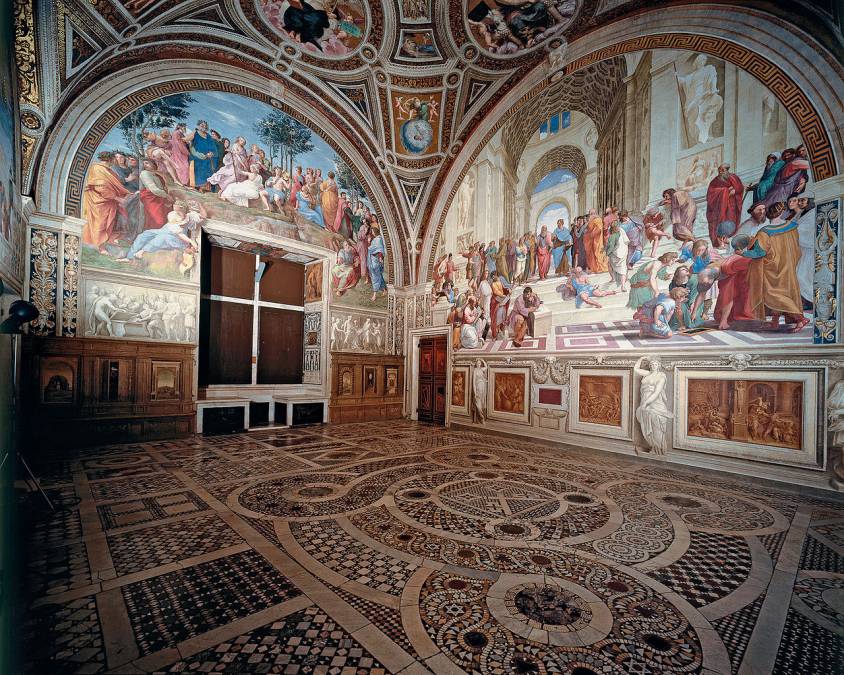
Pour voir le monde tel qu’il est, essuyons nos lunettes et cessons de regarder la teinte de nos verres. Car comme souvent, ce qui « empêche » le spectateur de pénétrer une œuvre, d’en voir l’intention et le sens, ce n’est pas ce que voient ses yeux en tant que tel, mais les idées préconçues qu’il a. Apprendre à voir commence généralement par bousculer quelques-unes de nos idées préconçues.
1. Ce n’est pas un tableau ! Depuis le XVIe siècle, nous Européens, raisonnons en termes de « tableau de chevalet ». L’artiste peint sur un support, un panneau en bois ou une toile, que le commanditaire accroche ensuite au mur. Or, L’Ecole d’Athènes, en tant que telle, n’est pas « un tableau » de ce type, mais simplement, au sens strict, un « détail » de ce qu’on appellerait aujourd’hui, « une installation ». Je m’explique. Ce qui constitue l’œuvre ici, c’est l’ensemble des fresques et décorations couvrant aussi bien le plafond, le sol que les quatre parois de la pièce ! On va vous les expliquer. Le spectateur se trouve, en quelque sorte, à l’intérieur d’un cube que l’artiste a cherché à faire apparaître comme une sphère. De sorte que vouloir « expliquer » le sens de L’Ecole d’Athènes, de façon isolée du reste et sans démontrer les liens thématiques et symboliques qui relient ce « détail » à l’iconographie des autres parois, n’est pas seulement un exercice futile mais relève de l’incompétence.
2. Erreur de titre ! Ni lors de sa commande, ni lors de sa réalisation, la fresque n’a porté le nom Ecole d’Athènes. Son nom n’apparaît qu’ultérieurement. Tout indique que l’ensemble de la pièce devait exprimer une harmonie divine réunissant La Philosophie (L’Ecole d’Athènes), La Théologie (en face), La Poésie (à droite) et La Justice (à gauche). On y reviendra.
3. La thématique n’est pas le choix de l’artiste ! La seule personne ayant rencontré de son vivant aussi bien Raphaël que le pape Jules II, a été le médecin Paolo Giovio (1483-1552) qui arrive à Rome en 1512, un an avant la mort de Jules II. D’après Giovio, c’est le pontife en personne qui, dès 1506, c’est-à-dire deux ans avant l’arrivée de Raphaël, conçoit le contenu de la « Chambre de la signature ». C’est logique puisqu’il s’agissait de l’endroit où il installait sa bibliothèque personnelle, une collection de quelque 270 livres, disposés sur des étagères en bas des fresques et classés selon les thèmes de chaque décoration murale (Philosophie, Théologie, Poésie et Justice). Cependant, vue la complexité de la thématique, et vue la faible culture littéraire de Jules II, les historiens s’accordent à attribuer la paternité intellectuelle des fresques aux conseillers du pape et surtout à celui qui aurait été en mesure d’en faire la synthèse, son libraire-en-chef, Thomaso Inghirami (1470-1516).
Une thématique et un programme que Raphaël, qui semble avoir constamment modifié ses dessins préparatoires en fonction des retours et commentaires qu’il recueillait de la part des commanditaires, a su traduire en images, avec l’énorme talent qui était le sien. En clair, si vous aimez les images, félicitez Raphaël ; si le contenu vous déplaît, adressez-vous au « patron ».
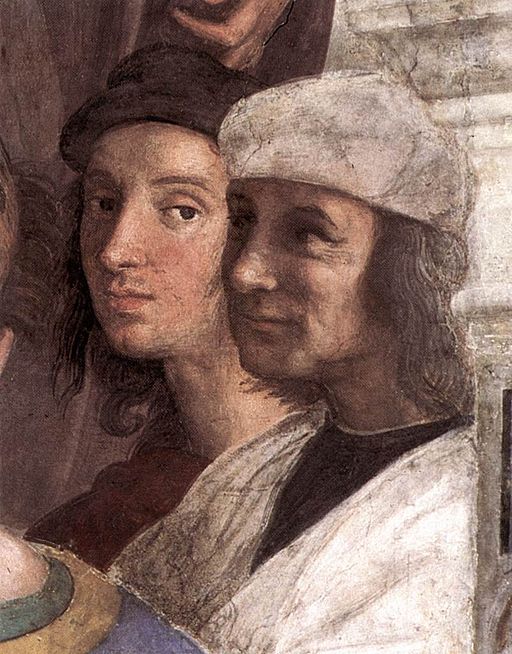
4. Peint à plusieurs ? Reste à éclaircir le fait que, à en croire les comptes du Vatican, la décoration entière de la pièce a été confiée, au milieu de l’année 1508, au fresquiste talentueux Giovanni Antonio Bazzi (1477-1549), de six ans plus âgé que Raphaël, connu sous le surnom Il Sodoma. C’est lui qui apparaît comme l’unique personne ayant perçu quelques sommes à ce sujet. Raphaël ne figure, en ces comptes, qu’à dater de 1513…
Or, comme en témoigne le cycle des fresques sur la vie de saint Benoît à l’abbaye territoriale Santa-Maria de Monte Oliveto Maggiore, Sodoma, avait également un talent considérable, et surtout une facilité d’exécution incomparable. S’il n’a jamais été mis à l’honneur, son style se confond tellement avec celui de Raphaël qu’on s’y méprendrait. Portrait de Pietro Aretino (Pierre l’Arétin), par le peintre vénitien le Titien.
Précisons également que Sodoma, venu à Rome à la demande du banquier du pape Agostino Chigi (1466-1520), fut sollicité en 1508 pour décorer sa villa, ce qui aurait laissé le champ libre à Raphaël au Vatican avant de le rejoindre sur le même chantier.
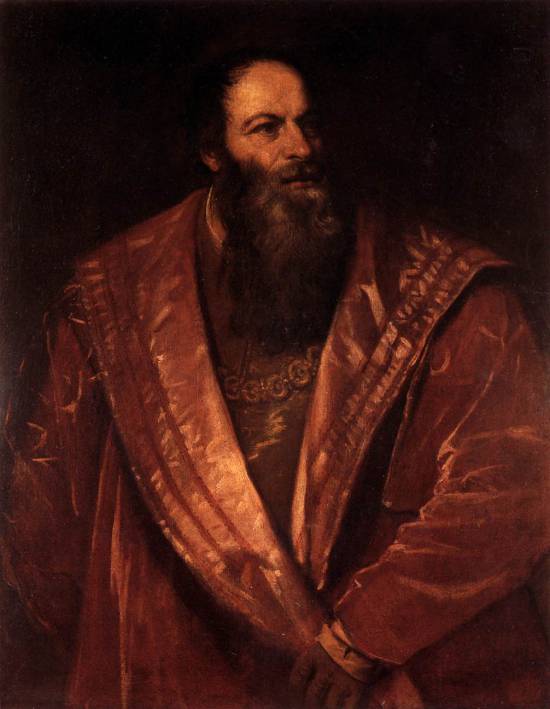
Selon l’historien Bernard Levergeois, le sulfureux Pietro Aretino, dit l’Arétin (1495-1556), pamphlétaire pornographique, avant de devenir le protégé et « l’agent culturel » du banquier Chigi à Rome, a passé de longues années à Pérouse.
Il s’intéresse à l’écurie du Pérugin, le maître de Raphaël, et y « fréquente les peintres les plus prestigieux de l’heure : Raphaël, Sebastiano del Piombo, Jules Romain, Giovanni da Udine, Giovan Francesco Penni et Sodoma, tous s’attelant à tour de rôle à la décoration de la magnifique villa (la Farnesine) que Chigi fait édifier aux portes de Rome (…). Certains d’entre eux travaillent également à celle de la non moins fameuse villa Madame (pour Jules II), projet grandiose qui ne sera jamais achevé ».
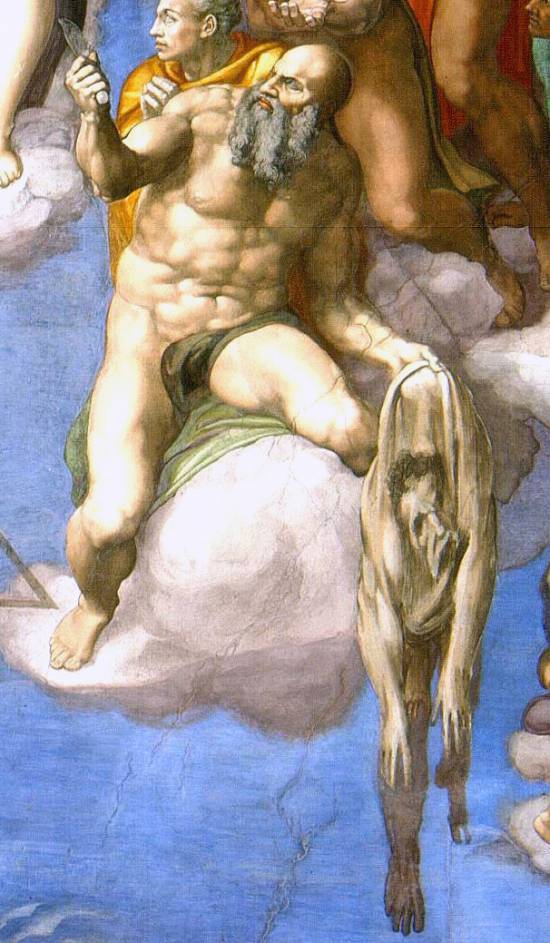
Comme on le voit dans le portrait peint par le Titien, l’Arétin, surnommé « le fléau des Princes », est un homme puissant, possessif et tyrannique. Maître-chanteur, pansexuel flamboyant et bien renseigné sur ce qui se passait dans les alcôves des élites, il s’érige, comme le patron du FBI Edgar Hoover à l’époque de Kennedy, tel un pouvoir au-dessus du pouvoir. Les historiens rapportent qu’aussi bien Raphaël que Michel-Ange, avant de montrer au public leurs œuvres, se pensaient contraints de solliciter l’avis de l’Arétin.
Et dans la chapelle Sixtine, Michel-Ange représente, sous les traits de l’Arétin, saint Bartolomé. L’artiste a dû estimer que l’attribut traditionnel du martyr écorché vif convenait à merveille à celui qui le rudoyait : il porte la dépouille de sa propre peau et tient en main le grand couteau qui servit à ce supplice…
Il n’est donc pas interdit de penser que ce soit l’Arétin, le favori du banquier du Pape, plutôt que le Bramante, comme c’est communément accepté, qui a pu jouer le rôle d’intermédiaire pour faire venir, aussi bien Sodoma que Raphaël à Rome en vu d’y faire renaître la gloire de son patron et de l’oligarchie tenant en grippe la Ville éternelle.
A ma connaissance, Raphaël, ni dans ses propres lettres, ni dans les propos rapportés par son entourage, n’aurait commenté la thématique et l’intention de son œuvre. Étrange modestie. Se considérait-il comme un simple « peintre décorateur » ?
Enfin, si la participation de Sodoma à la réalisation de l’Ecole d’Athènes reste à éclaircir, son portrait y figure bien. Il se trouve au premier plan à l’extrême droite, devant un Raphaël un peu triste (tout deux du côté des aristotéliciens). Une double signature ?
Peut-on alors continuer de parler des fresques « de Raphaël » ? Ne s’agit-il pas plutôt des fresques de Jules II-Inghirami-Sodoma-Raphaël ?
Un commanditaire hors du commun,
« le pape guerrier » Jules II

Avant de parler de ces fameux « impresarios de la Renaissance » et comprendre leurs motivations, il est nécessaire de s’arrêter un moment sur le personnage de Giuliano della Rovere (1443-1513). Il sera nommé évêque de Carpentras par le pape Sixte IV, son oncle. Il fut aussi successivement archevêque d’Avignon et cardinal-évêque d’Ostie.
Ce n’est que le 31 octobre 1503 que 37 des 38 cardinaux composant le Sacré Collège, le portent à la tête de l’Église occidentale, sous le nom de Jules II, jusqu’à sa mort en 1513. Giuliano attendait ce moment depuis 20 ans.
En effet, en 1492, son ennemi personnel, l’espagnol Rodrigo de Borgia (1431-1503), réussit à se faire élire sous le nom d’Alexandre VI. Fidèle à la corruption légendaire de la dynastie des Borgia, il sera l’un des papes les plus corrompus de l’histoire de l’Église.
Jaloux et fâché de son échec, Giuliano accuse alors le nouveau pape d’avoir acheté un certain nombre de voix. Craignant pour sa vie, il part en France à la cour de Charles VIII qu’il convainc de mener une campagne militaire en Italie, afin de déposer Alexandre VI et de récupérer le Royaume de Naples… Accompagnant le jeune roi dans son expédition italienne, il entre dans Rome avec lui fin 1494 et se prépare à lancer un concile pour enquêter sur les agissements du pape. Mais Alexandre VI parvient à circonvenir les machinations de son ennemi et préserve son pontificat jusqu’à sa mort en 1503.

Dès son avènement, Giuliano della Rovere confesse avoir choisi son nom de pape, Jules II, non pas en fonction du pape Jules I, mais en référence au dictateur sanguinaire romain Jules César. Il affirme d’emblée sa ferme volonté de restaurer la puissance politique des papes en Italie. Pour lui, Rome doit redevenir la capitale d’un Empire bien plus vaste que l’Empire romain de jadis.
Lorsque Jules II prend ses fonctions, la décadence et la corruption ont conduit l’Église au bord du gouffre. Les territoires qui deviendront ultérieurement l’Italie, ne sont qu’un vaste champ de bataille où condottieri italiens, rois français, empereurs allemands et nobles espagnols viennent guerroyer. La ville antique de Rome n’est plus qu’un vaste amas de ruines systématiquement pillé par des entrepreneurs rapaces au service des princes, des évêques et des papes cherchant chacun à s’accaparer la moindre colonne ou architrave susceptible de venir orner leur palais ou église. Sur les 50000 habitants qu’accueille la ville, on compte 10000 prostituées et courtisanes…
De toute évidence, Jules II, est le pape choisi par l’oligarchie pour remettre un minimum d’ordre dans la maison. Car, particulièrement dès 1492, l’extension du catholicisme dans le Nouveau Monde puis en Orient, nécessite une « renaissance », non pas de « l’humanisme chrétien », comme lors de la Renaissance du début du XVe siècle, mais de l’autorité de l’Église.

Pour nous aujourd’hui, le mot « Renaissance » évoque l’apogée de la culture italienne. Cependant, pour les puissants de l’époque de Raphaël, il s’agissait, en s’appuyant sur l’étude assidue des textes grecs et latins, de ressusciter la splendeur de l’Antiquité gréco-romaine, incarnée par la gloire de la « République » romaine, idéalisée comme ayant été un grand Etat bien administré, grâce à des lois efficaces, des fonctionnaires capables et une grande culture.
Et c’est bien à cette renaissance de l’autorité romaine que Jules II va se consacrer. En premier lieu par le glaive. En moins de trois ans (1503-1506), César Borgia est réduit à l’impuissance. Il est le fils illégitime du pape Alexandre VI qui, à la tête d’une armée de mercenaires, guerroyait dans le pays et terrorisait les Etats pontificaux,

En 1506, Jules II, vite surnommé « le pape guerrier » à la tête de ses troupes, reprend Pérouse et Bologne. Comme le lui reproche alors l’humaniste Erasme de Rotterdam (1467-1537), présent en Italie et témoin oculaire du pillage de Bologne par les troupes pontificales, Jules II préfère de loin le casque à la tiare. Interrogé par Michel-Ange en charge de l’immortaliser avec une statue en bronze, pour savoir s’il ne désirait pas être représenté un livre à la main pour souligner son haut degré de culture, Jules II répond :
Pourquoi un livre ? Représentez-moi plutôt une épée en main.
Originaire de la région de Gênes (la Ligurie), Jules II entreprend alors de chasser de la Romagne qu’ils occupaient, les Vénitiens qu’il abhorre. « Je réduirai votre Venise à l’état de hameau de pêcheurs dont elle est sortie, » avait dit un jour le pape ligurien à l’ambassadeur Pisani, à quoi le fier patricien n’a pas manqué de répliquer :
Et nous, Saint-Père, nous ferons de vous un petit curé de village,
si vous n’êtes pas raisonnable…
Ce langage donne la mesure de l’aigreur à laquelle on était arrivé de part et d’autre. Dans la bulle d’excommunication lancée peu après (27 avril 1509) contre les Vénitiens, ceux-ci étaient accusés « d’unir l’habitude du loup à la férocité du lion, et d’écorcher la peau en arrachant les poils… »
La Ligue de Cambrai
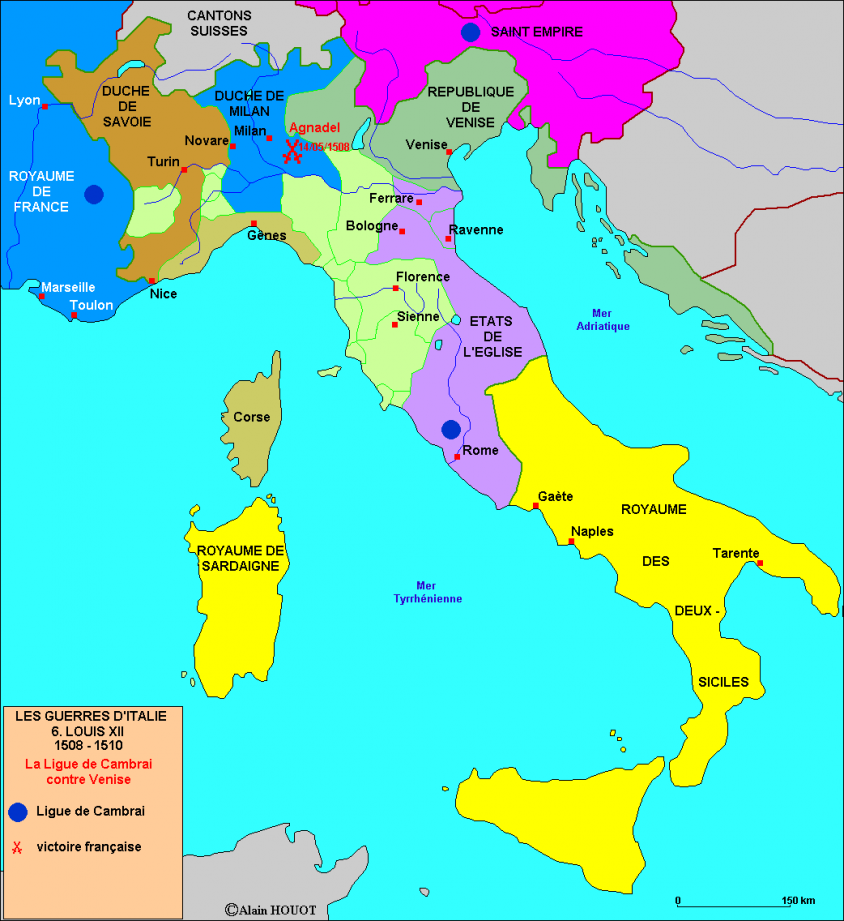
Contre les pratiques rapaces de Venise, le 10 décembre 1508 à Cambrai, Jules II se rallie officiellement à la « Ligue de Cambrai », un ensemble de puissances (dont le roi Louis XII, la régente des Pays-Bas Marguerite d’Autriche, le roi Ferdinand II d’Aragon et l’empereur Maximilien Ier).
Pour Jules II, le bonheur est total car Louis XII vient en personne expulser les Vénitiens des États de l’Église. Mieux encore, le 14 mai 1509, après à sa défaite contre la Ligue de Cambrai lors de la bataille d’Agnadel, la République de Venise agonise et se retrouve à la merci d’une invasion. Jules II, craignant alors que les Français n’établissent durablement leur influence sur le pays, opère un revirement spectaculaire. Il organise, du jour au lendemain, la survie de Venise !
Son trésorier général, le banquier siennois Agostino Chigi (milliardaire siennois proche des Borgia auxquels il avait prêté des sommes colossales et futur mécène de Raphaël), en fixe les conditions : pour se payer les mercenaires suisses capables de repousser les agresseurs, Chigi concède aux Vénitiens un prêt conséquent.
En échange, la Sérénissime accepte de renoncer à son monopole sur le commerce de l’alun qu’elle importe de Constantinople. Or, à l’époque, l’alun, un minerai irremplaçable permettant de fixer les teintures des étoffes, représente un véritable enjeu « stratégique ».
L’arrêt des importations d’alun par Venise, obligera l’ensemble du monde méditerranéen, du jour au lendemain, à se fournir non plus auprès de Venise, mais auprès du… Vatican, c’est-à-dire auprès de… Chigi, en charge pour la papauté de l’exploitation de « l’alun de Rome » situé dans les mines des monts de la Tolfa, au nord-ouest de Rome en plein cœur des Etats pontificaux. Consciente qu’il en va de sa survie, et faute d’alternative, Venise accepte.
Dans sa biographie sur Jules II, Ivan Cloulas précise :
Au-dessus de tous se détache Agostino Chigi, le banquier siennois, fermier des mines pontificales d’alun de la Tolfa depuis le règne d’Alexandre VI. La faveur dont jouit ce personnage auprès de Jules II a de quoi étonner, s’agissant d’un banquier qui a longtemps servi César Borgia. Le pontife a suivant la tradition, conféré lors de son avènement la charge de ‘dépositaire’ à l’un de ses compatriotes génois, Paolo Sauli, chargé d’effectuer toutes les transactions financières du Saint-Siège en liaison avec le cardinal camerlingue Raffaelo Sansoni-Riario. Mais Chigi ne subit pas de disgrâce, car il a avancé à Julien della Rovere des sommes considérables pour acheter des électeurs [des cardinaux membres du Sacré Collège], et il a fait fructifier à merveille l’exploitation et l’exportation de l’alun extrait des mines pontificales. L’expérience et la valeur du siennois en font un partenaire des différents banquiers de la papauté, notamment les Sauli et les Fugger, qui gagnent de nouvelles richesses au fur et à mesure que se développe en Allemagne le fructueux commerce des indulgences.
Ainsi, allié à Venise, Jules II, dans ce qui apparaît aux yeux des naïfs comme un « retournement d’alliance » spectaculaire, met sur pied la « Sainte Ligue » pour « expulser d’Italie les Barbares » (Fuori i Barbari !). Une ligue dans laquelle il fit entrer les Suisses, Venise, les rois Ferdinand d’Aragon et Henri VIII d’Angleterre, et enfin, l’empereur Maximilien. Cette ligue chassera alors les Français hors d’Italie ; Jules II ironisant :
Si Venise n’avait pas existé, il aurait fallu l’inventer.
En riposte, Louis XII, le Roi de France, tentera de transposer la lutte dans le domaine spirituel. Ainsi, un concile national, réuni à Orléans en 1510, déclare la France soustraite à l’obédience de Jules II. Un second concile fut réuni en Italie même, à Pise, puis à Milan (1512) essayant de destituer le pape. Jules II opposa au Roi de France le Ve concile œcuménique du Latran (1512) où il accueillera chaleureusement ceux qui abandonnaient celui de Milan…
Empires maritimes
Jules II s’acharnera à rétablir son autorité autant sur la terre ferme que sur les océans. Un peu comme dans la Grèce antique, l’Italie a connu un phénomène assez particulier, celui de l’émergence de « Républiques maritimes ». Si la « République de Venise » est célébrissime, on connaît moins les Républiques maritimes de Pise, de Raguse (Dubrovnik sur la côte dalmate), d’Amalfi (près de Naples) et de Gênes.
A chaque fois, opérant à partir d’un port, une oligarchie locale va se construire un empire maritime et surtout empoisonner ses concurrents. Or, l’activité maritime, par sa nature propre, implique une prise de risque s’inscrivant dans la durée. D’où la nécessité d’une finance habile, robuste et prévoyante, offrant des assurances et des options d’achats sur les biens et les profits futurs. Ce n’est donc pas un hasard si la plupart des empires financiers se développeront en symbiose avec des Empires maritimes, notamment, hollandais et britanniques et avec les Compagnies des Indes occidentales et orientales.
A la fin du XVe siècle, c’est essentiellement Gênes et Venise qui s’affrontent pour le contrôle des mers. D’un côté, Venise, historiquement la tête de pont de l’Empire byzantin et sa capitale Constantinople (Istanbul), qui est de loin la plus grande ville du monde méditerranéen en 1500 avec 200 000 habitants. Depuis son apogée au XIIIe siècle, la Sérénissime défend bec et ongles son statut d’intermédiaire incontournable sur la Route de la soie en Occident. De l’autre, Gênes, qui, après s’être implantée au Levant grâce aux croisades, en prenant le contrôle du Portugal, financera toutes les expéditions coloniales portugaises en Afrique de l’Ouest d’où elle ramènera or et esclaves.
Deux exploits maritimes viendront exacerber un peu plus cette rivalité :
- 1488. Bien que les travaux du savant persan Al Biruni (XIe siècle) et de vieilles cartes, dont celle de Fra Mauro, permettaient d’entrevoir le contournement du continent africain par l’océan Atlantique pour rejoindre les Indes, ce n’est qu’en 1488 que des marins portugais passent le cap de Bonne Espérance. Ainsi, Gênes, sans le moindre intermédiaire, peut directement charger ses navires en Asie et ramener ses marchandises en Europe ;
- 1492. Cherchant elle aussi à ouvrir une route commerciale directe vers l’Asie sans devoir traiter avec les Vénitiens ou les Portugais (génois), l’Espagne enverra en 1492 le navigateur génois Christophe Colomb en partant vers l’Ouest. Plus qu’une nouvelle route vers l’Asie, Colomb découvre un nouveau continent qui sera objet de convoitises.

Deux ans plus tard, le 7 juin 1494, Portugais et Espagnols signeront le traité de Tordesillas pour se partager à deux, rien que ça, le monde. En gros, tout le Nouveau Monde pour l’Espagne, tout l’ancien (des Açores jusqu’à Macao) pour le Portugal. Pour délimiter leurs empires, ils fixent une ligne imaginaire, que le pape Alexandre VI Borgia fixe dès 1493 à 100 lieues à l’Ouest des Açores et des îles du Cap Vert.
Ensuite, la ligne fut reportée, à la demande des Portugais, à 370 lieues. Toute terre découverte à l’Est de cette ligne devait appartenir au Portugal ; à l’Ouest, à l’Espagne. Au même moment, toute autre puissance maritime occidentale se voit refuser l’accès au nouveau continent. Or, en 1500, horreur pour les Espagnols, c’est un Portugais qui découvre le Brésil. Et étant donné sa position géographique, à l’ouest de la fameuse ligne, ce pays tombe sous la coupe de l’Empire portugais !
Jules II, un enfant de la Ligurie (région de Gênes, donc liée au Portugal) et vomissant Alexandre VI Borgia (espagnol), en 1506, se fait un grand plaisir en confirmant, par la bulle Inter Cætera, le traité de Tordesillas de 1494 permettant de fixer les diocèses du Nouveau Monde, évidemment à l’avantage des portugais et donc au sien.
L’arme suprême, la culture
Sur le plan « spirituel » et « culturel », si Jules II passait la plus grande partie de son temps à guerroyer, la postérité retient essentiellement l’image « d’un des grands papes de la Renaissance » car grand protecteur et mécène des arts.
En effet, pour rétablir le prestige (le mot français pour soft power) et donc l’autorité de Rome et son Empire, la culture est une arme aussi redoutable que le glaive. Pour commencer, Jules II ouvre de nouvelles artères à Rome, dont la via Giulia. Il place dans la cour du Belvédère les antiques qu’il a acquis, en particulier, « l’Apollon du Belvédère » et le « Laocoon », fraîchement découvert en 1506 dans les ruines du Palais impérial de Néron. Jules II et son tombeau

La même année, c’est-à-dire six ans avant la fin des opérations militaires, Jules II lance également d’énormes chantiers dont certains ne seront réalisés que partiellement ou entièrement après sa mort :
- La reconstruction de la basilique Saint-Pierre, tâche confiée à l’architecte et peintre Donato Bramante (1444-1514) ;
- Le tombeau de Jules II, que le sculpteur Michel-Ange est chargé de réaliser dans l’abside de la nouvelle basilique et dont sa fameuse statue de Moïse, une des 48 statues et bas-reliefs en bronze prévus à l’origine, aurait dû faire partie ;
- La décoration de la voûte de la Chapelle Sixtine construite par le Pape Sixte IV l’oncle de Jules II, sera également confiée à Michel-Ange. Jules II se laisse entraîner par la fougue créatrice du sculpteur. Ils échafaudent ensemble des projets toujours plus grandioses pour la décoration de la Chapelle. L’artiste donnera libre cours à son imagination, dans un genre artistique différent qui plaira peu au pape. Jusqu’au 31 octobre 1512, Michel-Ange peindra plus de 300 personnages sur la voûte ;
- Les fresques ornant la bibliothèque personnelle du pape dont sera chargé le peintre Raphaël, appelé à Rome en 1508, probablement à la suggestion de Chigi, l’Arétin ou Bramante. La Stanza était l’endroit, où le pape signait ses brèves et ses bulles. Cette salle devint ensuite la bibliothèque privée du souverain pontife Jules II puis la salle du Tribunal des Signatures Apostoliques de Grâce et de Justice et plus tard, celle de l’instance suprême d’appel et de cassation. Avant l’arrivée de Jules II, cette salle et « la chambre d’Héliodore », étaient couvertes de fresques de Piero della Francesca, protégé par Nicolas de Cues, immortalisant le grand concile œcuménique de Florence (1438). Des décorations de Lucas Signorelli et du Sodoma y furent ajoutées ultérieurement. Suite à son élection, Jules II, soucieux de marquer sa présence dans l’histoire, et de rétablir l’autorité de l’oligarchie et de l’Eglise, fera recouvrir les fresques du concile de Florence par de nouvelles. Convaincu par ses conseillers, le pape consent à confier la direction du chantier à Raphaël. Officiellement, on dit que ce dernier aurait épargné quelques fresques du plafond, notamment celles exécutées par Sodoma, pour ne pas se le mettre entièrement à dos. Mais, comme nous l’avons dit, le contenu, la thématique très élaborée et une partie de l’iconographie des fresques furent arrêtés dès 1506 avant même l’arrivée de Raphaël en 1508 ;
- Moderniser la ville de Rome. Jules II, sans doute conseillé par l’architecte Bramante, transforme singulièrement la voirie de Rome. Afin que toutes les voies convergent vers la basilique Saint-Pierre, il ordonna de percer la Via Giulia sur la rive gauche et de transformer en une véritable rue la Lungara, les chemins qui serpentaient le long du fleuve sur la rive droite. Sa mort interrompt les grands travaux qu’il envisage, notamment la construction d’une avenue monumentale conduisant à Saint-Pierre et celle d’un nouveau pont pour décongestionner celui de Saint-Ange dont il a d’ailleurs facilité l’accès en élargissant la rue y conduisant. L’ampleur des travaux entrepris pose le problème des matériaux ; bien qu’il fût, en principe, interdit de s’en prendre aux monuments antiques, la réalité fut toute autre. Ruinante, devint le surnom de Bramante.

Grands chantiers, mécénat et dépenses militaires assèchent les revenus du Saint Siège. Pour y remédier, Jules II multiplie les ventes de bénéfices ecclésiastiques, de dispenses et d’indulgences.
Au XIIe siècle, par des décrets pontificaux, l’Église catholique romaine fixait les règles du commerce des « indulgences » (du latin indulgere, accorder). Ils encadraient ainsi la rémission totale ou partielle devant Dieu d’un péché, notamment en promettant une réduction du temps de passage au purgatoire aux généreux fidèles après leur mort. Au cours du temps, cette pratique, exploitant essentiellement une forme de superstition religieuse, s’est transformée en un commerce si lucratif que l’Église ne pouvait plus s’en passer.
Dans le nord de l’Europe, notamment en Allemagne, les banquiers Fugger d’Augsbourg participaient à l’organisation de ce commerce. Cette pratique fut vivement dénoncée et combattue par les humanistes, notamment par Erasme, avant que Luther n’en fasse une pièce essentielle des fameuses 95 thèses qu’il placarda, en 1517, sur les portes de l’église de Wittenberg.
Dans son ouvrage Erasme et l’Italie, Augustin Renaudet écrit qu’Erasme, après avoir rencontré les plus hautes instances du Vatican, ne fut pas dupe :
Il ne tarda guère à comprendre qu’en dehors du Saint-Siège, des services de la Curie et de la Chancellerie, en dehors des cardinaux, des innombrables prélats en mission et en charge, en dehors d’une foule bigarrée de fonctionnaires et de scribes, qui peuplaient les bureaux administratifs ou financiers et les tribunaux, il n’y avait rien à Rome. Dans toutes les villes qu’il avait connues, à Bruxelles, à Paris, à Londres, à Milan, à Florence, et récemment à Venise, une économie active, alimentée par l’industrie, le commerce, la finance, soutenait une forte bourgeoisie urbaine, ou comme à Venise, une aristocratie d’armateurs. A Rome, toute l’économie, tout le commerce, toute la finance, étaient aux mains d’étrangers : marchands florentins ou génois, banquiers florentins ou génois. Ces étrangers tenaient dans leur dépendance un peuple de petits marchands, de petits artisans qui vendaient dans l’arrière-boutique, de changeurs et de trafiquants juifs. Très peu d’industrie, la population romaine vivait au service de la Curie, des prélats, des couvents. Erasme s’émerveillait de l’orgueil avec lequel les descendants du peuple-roi prétendaient en maintenir l’antique majesté. Le mot du peuple romain n’était plus qu’un vain mot ; Erasme devait un jour écrire que, dans le monde moderne, un citoyen romain comptait moins qu’un bourgeois de Bâle.
Constat partagé par André Chastel et Robert Klein qui notent, dans L’Humanisme, l’Europe de la Renaissance :
Une autre tendance, favorable à César et à Auguste, s’était fait jour : Rome redevenant de plus en plus la capitale ‘impériale’ de tous les puissants lui empruntent ou cherchent à lui emprunter un style. Ce nouveau style associe d’ailleurs de plus en plus arma et litterae, le glaive et le livre (…) Riche ou pauvre, tout souverain de la Renaissance occupera les artistes et les lettrés dans la mesure où il a besoin de prestige : les plus grands mécènes de la Renaissance furent les ambitieux et les guerriers, Maximilien, Jules II, Henry VIII, François Ier, Charles Quint.
Les « impresarios » de Raphaël
Si, du point de vue contemporain, cela nous paraît assez impensable qu’un artiste se fasse « dicter » la thématique de son œuvre, ce ne fut pas le cas au moment de la Renaissance et encore moins au Moyen Âge. Par exemple, bien qu’il fût un diplomate de haut vol du duc de Bourgogne Philippe Le Bon, le peintre flamand Jan Van Eyck, un des premiers peintres à signer de son nom ses œuvres, se faisait conseiller en matière de théologie par le confesseur du duc, le très érudit Denis le Chartreux, ami proche du cardinal Nicolas de Cues. Et personne n’osera dire que Van Eyck « n’a pas peint » son chef d’œuvre L’Agneau mystique.
La position de Raphaël était plus délicate. A son époque, les peintres avaient encore le statut d’artisan. Y compris Léonard de Vinci, dont on connaît l’intelligence supérieure, et qui se déclarait « homme sans lettres », c’est-à-dire ne sachant lire ni le latin ni le grec. Raphaël savait lire et écrire l’italien, mais était dans la même situation. Et lorsque, vers la fin de sa courte vie, on le sollicite pour s’occuper d’architecture (la basilique Saint-Pierre) et d’urbanisme (les antiquités romaines), il demande à un de ses amis de lui traduire en italien les Dix livres de l’architecte romain Vitruve. Or, tout visiteur des « Chambres de la signature » est immédiatement frappé par la grande harmonie unissant plusieurs dizaines de philosophes, de légistes, de poètes et de théologiens dont l’existence était quasiment inconnue de Raphaël avant son arrivée à Rome en 1508.

D’ailleurs, à l’exception du tableau Le mariage de la vierge, peint en 1504, à l’âge de 21 ans, à partir de la façon que son maître Pietro di Cristoforo Vannucci, dit le Pérugin (v. 1448-1523) avait traité ce même sujet, Raphaël n’avait pas encore eu à relever le type de défi que lui poseront les Stanza.
Comme nous l’avons déjà dit, les cartons et autres dessins préparatoires, parfois assez différents du résultat final, permettent également de croire que suite à « la commande », des discussions avec un ou plusieurs impresarios ont conduit l’artiste à modifier, améliorer ou changer l’iconographie pour aboutir au résultat final.
En ce qui concerne la thématique, comme nous l’avons déjà mentionné, les idées et les concepts semblent avoir émergé lors d’une longue période de maturation et furent sans doute le résultats d’échanges multiples entre le Pape Jules II et plusieurs de ses conseillers, libraires, et « orateurs » de la cour papale.
Selon l’historienne Ingrid D. Rowlands, les documents d’archives indiquent sans conteste l’apport décisif de trois personnalités très différentes de l’époque :
- Battista Casali ;
- Egidio Antonini da Viterbo (connu en France sous le nom de Gilles de Viterbe) et
- Tommaso « Fedra » Inghirami.
L’enquête approfondie de l’historienne Christiane L. Joost-Gaugier a établi le rôle prédominant d’Inghirami. Il est le seul en position, et en capacité, en tant que libraire du pape, de fixer le programme des chambres. Raphaël, sera son collaborateur enthousiaste et finira sans doute par se faire « recruter » aux orientations et à la vision de ses commanditeurs. En témoigne le fait qu’il exigera à être enterré au Panthéon romain, considéré comme le temple le plus pythagoricien, et donc le plus néo-platonicien, de l’époque romaine.
Comme l’a documenté l’historien jésuite John William O’Malley, c’est le 1er janvier 1508, l’année de sa nomination à Saint-Jean du Latran, quelques mois avant l’arrivée de Raphaël à Rome, que Battista Casali (1473-1525), un professeur de l’Université de Rome, évoque l’image de L’Ecole d’Athènes lors d’une oraison prononcée dans la Chapelle Sixtine en présence de Jules II :
Un jour (…) la beauté d’Athènes inspira un concours entre les dieux, là, où l’humanité, les études, la religion, les primeurs, la jurisprudence et le droit ont vu le jour avant d’être distribué dans chaque pays, la où l’Athénée et tant d’autres gymnasiums ont été fondé, où tant de princes de la connaissance ont formé leurs jeunes et leur a appris la vertu, la fortitude, la tempérance et la justice – tout cela détruit dans le tourbillon de la machine de guerre Mohémataine (…) Cependant, tout comme [votre illustre oncle le pape] Sixte IV [qui ordonna la construction de la Chapelle Sixtine], a, en quelque sorte, posé les fondations de l’enseignement, vous y avez posé la corniche. Ici la bibliothèque vaticane qu’il a érigée comme si elle était venue d’Athènes elle-même, réunissant les livres qu’il a pu sauver du naufrage, et créée à l’image de l’Académie. Vous, maintenant, Jules II, pontife suprême, vous avez fondé une nouvelle Athènes lorsque vous invoquez le monde abattu des lettres comme s’il se levait des morts, et lui ordonne, entouré de menaces de travaux suspendus, qu’Athènes, ses stades, ses théâtres et ses Athénées, soient rétablis.
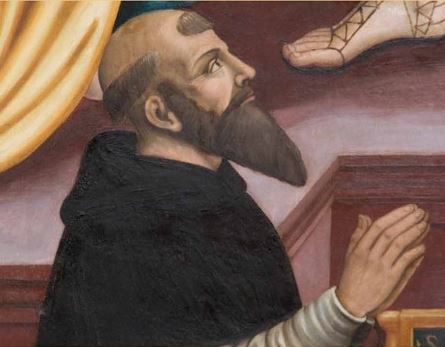
Autre influence majeure sur la thématique, Gilles de Viterbe (1469-1532) dont parlerons ci-dessous.
- Orateur hors pair, il est appelé en 1497 à Rome par le pape Alexandre VI Borgia ;
- En 1503, il devint le Supérieur général de l’ordre des Ermites de saint Augustin ; avec 8000 membres, c’est l’ordre le plus puissant de son époque ;
- Il est connu pour l’audace et le sérieux du discours qu’il prononça à l’ouverture du Ve concile du Latran de 1512 ;
- Il critique sévèrement la politique belliqueuse de Jules II et l’incite à triompher par la culture plutôt que par le glaive ;
- Après la mort de ce dernier, il devient le prédicateur et le théologien du pape Léon X qui le nomme cardinal en 1517.
Enfin, le prélat Tommaso Inghirami (1470-1516), maniant aussi bien le latin que le grec, était également un orateur redoutable. L’homme devait sa fortune à Laurent le Magnifique (1449-1492).
Éduqué par le philosophe néoplatonicien Marsile Ficin, le Magnifique fut le mécène aussi bien de Botticelli que de Michel-Ange qui vécut trois ans chez lui.

Né à Volterra, Inghirami fut lui aussi recueilli, après le saccage de cette ville, par le Magnifique. Il surveilla soigneusement ses études et l’envoya plus tard à Rome où Alexandre VI Borgia lui fit un accueil favorable. Inghirami était un bellâtre tiré à quatre épingles.
A 16 ans, Inghirami gagna le surnom de « Phèdre » après avoir brillamment incarné, le rôle de cette reine qui se suicide dans une tragédie de Sénèque jouée en cercle restreint à la résidence du très influent cardinal Raphael Riario, cousin de Jules II ou neveu du pape Sixte IV et donc cousin de Jules II. Par la suite, Phèdre, bon vivant et pour qui les plaisirs célestes et terrestres se complétaient allègrement, gagna en poids politique et surtout… physique.
- En 1475, il accompagne le nonce du pape Alexandre VI à la cour de l’empereur Maximilien Ier du Saint-Empire qui le nomma comte palatin et poète lauréat ;
- Le 16 janvier 1498, Inghirami prononça à l’Eglise espagnole de Rome une oraison en l’honneur de l’Infant Don Juan, le fils assassiné du Roi d’Espagne. Inghirami, au nom d’Alexandre VI Borgia, endosse pleinement la politique espagnole de l’époque : étendre la chrétienté dans le Nouveau Monde, chasser les Maures d’Europe et renforcer le pillage coloniale de l’Afrique. Si Jules II détestait Alexandre VI, il continuera cette politique ;
- En 1508, Jules II nomma Inghirami bibliothécaire du Vatican ;
- En 1509, alors qu’il est fortement investi dans la réalisation des fresques des Stanza, Raphaël fait son portrait. Raphaël nous montre un homme souffrant d’un strabisme divergent qui semble tourner son regard vers le ciel afin de signifier d’où cet « humaniste » tirait son inspiration ;
- En 1510, le pape le nomme évêque de Raguse ;
- Enfin, en 1513, il devient secrétaire pontifical et à la demande pressante du pape mourant, Inghirami prononça son oraison funèbre : « Bon Dieu ! Quel esprit avait cet homme, quel sens, quelle capacité à gérer et à administrer l’Empire ! Quelle force suprême et inébranlable ! »
Sans tarder, Inghirami officia comme secrétaire au conclave élisant le pape Léon X (Jean de Médicis, second fils de Laurent de Médicis, lui aussi grand protecteur des néo-platoniciens et de la « culture »), un autre pape dont Raphaël fera le portrait.
En 1509, toujours désireux de réformer l’église catholique sur la base de l’étude des trois langues (latin-grec-hébreu) pour déminer les conflits religieux qui se préparaient, Erasme de Rotterdam rencontre Inghirami à Rome. Ce dernier lui expose les chantiers culturels grandioses qu’il dirigeait. Erasme n’en pipe mot.
Cependant, longtemps après la mort d’Inghirami, Erasme constate que l’Eglise et l’oligarchie recrutent parmi les humanistes. Il « se paie » la secte des Cicéroniens, omniprésente à la Curie romaine et dont Inghirami était un des chefs de file.
Ainsi, en 1528, dans Le Cicéronien, Erasme cite l’oraison d’Inghirami lors du Vendredi saint de l’année 1509. Il y dénonce le fait que les membres de cette secte, au motif de l’élégance de la langue latine, n’utilisaient que des mots latins figurant tels quels dans les œuvres de Cicéron ! Du coup, tout le langage nouveau du christianisme évangélique, consacré au concile de Florence, qu’Erasme souhaitait promouvoir, se trouva soit banni, soit « retraduit » en des termes païens de l’époque romaine ! Par exemple, dans son sermon, Inghirami avait présenté le Christ en croix comme un dieu païen se sacrifiant héroïquement plutôt qu’en rédempteur.
Enfin, peu après la mort de Raphaël, le cardinal Jacopo Sadoleto (1477-1547) écrit un traité de philosophie dans lequel Inghirami (entretemps disparu tragiquement) défend la rhétorique et nie toute valeur à la philosophie, son argument majeur étant que tout qui s’écrit est déjà contenu dans les textes mystiques et mythologiques d’Orphée et de ses adeptes.
Platon et Aristote, l’impossible synthèse

Maintenant, afin d’être en mesure de « lire » la thématique déployée par Raphaël dans la « Chambre de la signature », examinons ce « néo-platonisme » florentin qui animait aussi bien Gilles de Viterbe que Tommaso Inghirami.
La démarche de ces deux orateurs consistait avant tout à mettre leur « néo-platonisme » et leur imagination au service d’une cause : celle d’affirmer avec force que Jules II, le pontifex maximus à la tête d’une Église triomphante, incarnait l’aboutissement ultime d’une vaste lignée de philosophes, de théologiens, de poètes et d’humanistes. A l’origine de ce « big bang » civilisationnel et théologique présumé conduire au lustre incommensurable de l’Église catholique sous Jules II, non pas Platon et Aristote eux-mêmes, mais ceux qui l’avaient précédé : Apollon, Moïse et surtout Pythagore.
A partir de 1506, Gilles de Viterbe, dans un exercice qu’on peut qualifier « d’au-delà d’une mission impossible », écrira un texte intitulé Sententia ad mentem Platonis (« Les Sentences avec l’esprit de Platon »). Il tentera d’y accommoder les Sentences de Pierre Lombard (1096-1160), le texte scolastique par excellence du XIIIe siècle et point de départ des commentaires du dominicain saint Thomas d’Aquin (1225-1274) pour sa Somme Théologique, avec le néo-platonisme ésotérique florentin de Marsile Ficin (1433-1499) * dont Gilles de Viterbe était un adepte.
Tout cela ne pouvait que plaire à un pape qui, pour asseoir son autorité sur les affaires terrestres et spirituelles, voyait d’un bon œil cet accord entre la Foi et la Raison dont parle Thomas d’Aquin qui dit que la Vérité étant une, la raison ne peut que confirmer une juste foi. Voire mieux, éclairer celle-ci, quitte à ce que cette dernière parachève la première…
Présenter le mariage de la scolastique aristotélicienne (la logique présentée comme « la raison » humaine) avec le néo-platonisme florentin (L’émanantisme plotinien présenté comme « la foi ») comme source de poésie et de justice, comme le fait « La Chambre de la signature » vient de là.
Rappelons qu’au milieu du XIIIe siècle, deux Ordres mendiants, les franciscains et les dominicains, contestaient la dérive d’une Eglise devenue avant tout le simple gérant de ses possessions terrestres. Celui qu’on nommera par la suite saint Thomas d’Aquin, s’oppose sur ce point à (son concurrent) saint Bonaventure (1221-1274), figure fondatrice de l’Ordre des franciscains.
Pour sa part, saint Thomas d’Aquin s’appuie sur Aristote que lui avait fait connaître Albert le Grand (1200-1280) dont il fut le disciple à Cologne, pour établir la primauté de « la raison ». Car, pour celui qui fut surnommé « le bœuf muet », la foi et la raison humaine, chacune gérant leur domaine, se devaient d’avancer ensemble, main dans main. Surtout si l’Église garde le dernier mot.

Plusieurs peintures (La grande fresque de 1366 dans la chapelle espagnole de Santa-Maria-Novella de Florence ; le tableau de Filippino Lippi de 1488 dans la chapelle Carafa de Rome ou encore le tableau de Benozzo Gozzoli peint vers 1470, au Louvre à Paris), ont immortalisé le Triomphe de Thomas d’Aquin.
Le tableau de Gozzoli nous semble d’une importance particulière car plusieurs éléments préfigurent l’iconographie de la Chambre de la signature, notamment les trois niveaux qu’on retrouve dans la Théologie (Trinité, évangélistes et responsables religieux) ainsi que le couple Platon et Aristote qu’on retrouve dans la Philosophie.
Chez Gozzoli, on voit le théologien, entre Platon et Aristote, jetant par terre devant lui le philosophe arabe Averroès (1126-1198) (Ibn-Rushd de Cordoue) expulsé pour avoir nié l’immortalité et la pensée de l’âme individuelle, au profit d’un « Intellect unique » pour tous les hommes qui active en nous les idées intelligibles.
En Occident, avant l’arrivée des délégations grecques en Italie venues assister au concile de Ferrare-Florence en 1438, seules quelques œuvres de Platon, dont le Timée, étaient connues d’une poignée d’érudits, tels ceux de l’Ecole de Chartres. En réalité, notre connaissance de la pensée grecque se limitait au philosophe Aristote.
Pour les aristotéliciens qui deviennent dominant dans l’Église catholique avec saint Thomas d’Aquin, si les chrétiens doivent accepter Aristote, ils doivent considérer Platon comme incompatible.
A l’inverse, pour les platoniciens, dont Augustin, Jérôme et surtout Nicolas de Cues et Erasme, qui parlait de « saint Socrate », Platon devait être vénéré par les chrétiens : il était monothéiste, croyait en l’immortalité de l’âme et vénérait, sous la forme de la triade pythagoricienne, le mystère de la Trinité.
Au XVe siècle, faute de clarté épistémologique et l’absence de certitude sur la paternité de certains manuscrits d’inspiration platoniciennes (mais attribués à tort à Aristote), certains humanistes, en particulier l’ami de Nicolas de Cues, le cardinal Jean Bessarion (1403-1472), grand artisan de la réunification des Eglises d’Orient et d’Occident, présentent Platon comme l’« égal » d’Aristote, son disciple, dans le seul but de rendre Platon « aussi acceptable que possible » auprès de l’Église catholique.
D’où la phrase devenue célèbre de Bessarion « Colo et veneror Aristotelem, amo Platonem » (Je cultive et je vénère Aristote, j’aime Platon) qui apparaît dans son In Calumniatorem Platonis (republié en 1503), une réplique à la charge virulente contre Platon élaborée par le grec Georges Trébizond.
Ainsi, dans L’Ecole d’Athènes peint par Raphaël, Platon et Aristote apparaissent côte à côte se complétant chacun avec sa sagesse particulière : le premier tenant son livre le Timée (sur la création de l’univers) d’une la main, et de l’autre, pointant vers le ciel (le Un, Dieu), le second tenant son Ethique (la conduite morale personnelle) d’une main, et dressant l’autre bras à l’horizontale pour indiquer le règne terrestre (la Physique).
Si les concepteurs de cette fresque avaient voulu souligner l’opposition des deux penseurs, Platon aurait tenu en main son Parménide (sur les Idées) et Aristote son Physique (sur les sciences naturelles). Ce n’est clairement pas dans l’Ecole d’Athènes.
Gilles de Viterbe fera tout, dans son Sententia ad mentem Platonis pour gommer les oppositions inconciliables et bien réelles (voir encadré ci-dessous) entre la pensée platonicienne et celle d’Aristote.
———————————-
Pourquoi Platon et Aristote
ne sont pas complémentaires
Par Christine Bierre
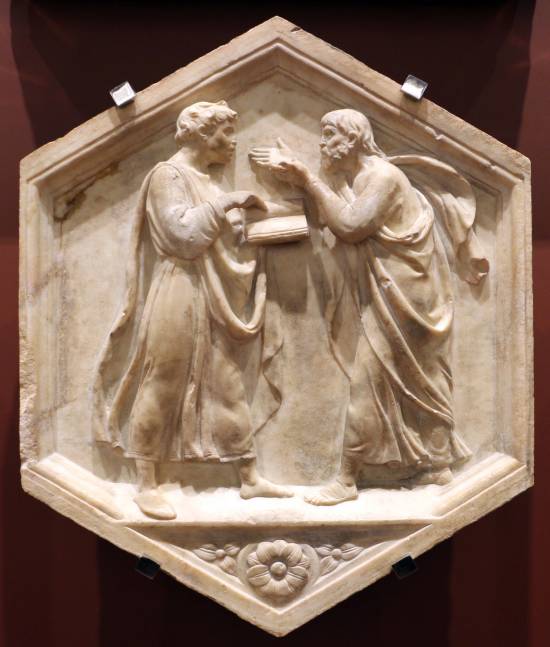
Les concepts fondamentaux qui ont donné naissance à notre civilisation européenne, remontent à la Grèce classique, et à travers elle, à l’Égypte et à d’autres civilisations plus anciennes encore.
Parmi les penseurs grecs, Platon (-428/-347 av. JC) et d’Aristote (-385/-323 av. JC) ont posé toutes les grandes questions qui intéressent notre humanité : qui sommes nous, quelles sont nos caractéristiques, comment vivons nous, où nous situons nous dans l’univers, comment pouvons nous le connaître ?
Les récits qui nous sont parvenus de cette période lointaine parlent des désaccords qui ont conduit Aristote à quitter l’Académie de Platon, dont il avait été le disciple. L’histoire témoigne ensuite de la violence des oppositions entre les disciples de l’un et de l’autre. A la renaissance, les courants catholiques les plus réactionnaires – le concile de Trente notamment – étaient inspirés par Aristote, alors que Platon régnait en maître dans le camp de l’humanisme, chez certains des plus grands tels qu’Érasme et Rabelais.
Il y eut différentes tentatives cependant de les rendre complémentaires, comme l’évoque cet article de Karel Vereycken. Si Platon représente le monde des Idées, Aristote, représente celui de la matière. Impossible de construire un monde sans les deux, nous dit-on. Cela paraît d’une telle évidence !
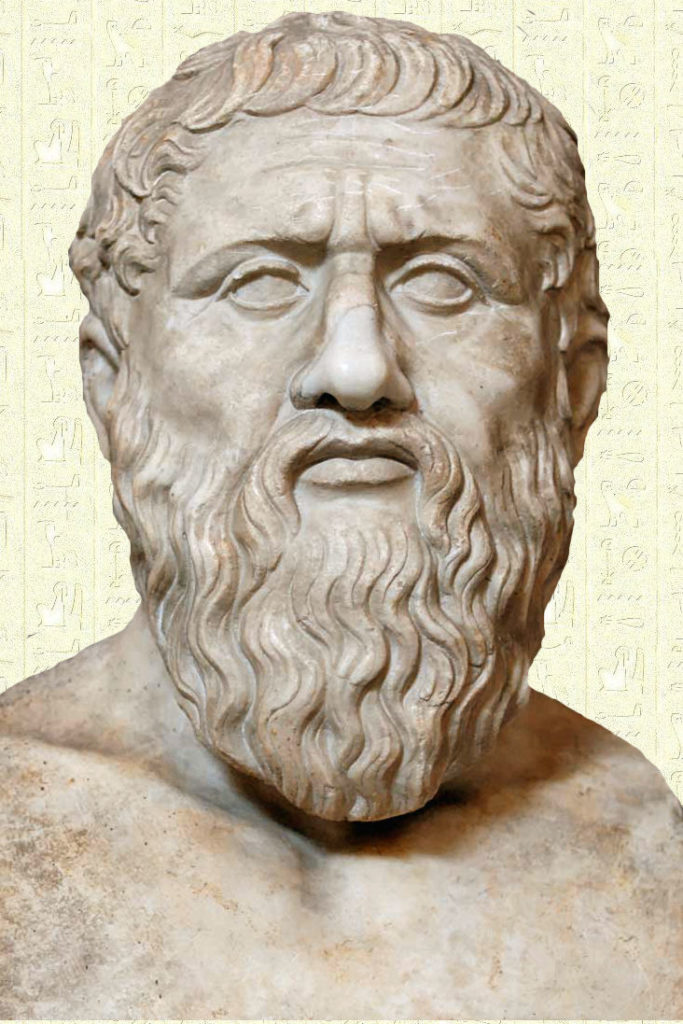
Tout ceci part, cependant, d’une idée fausse opposant ces deux personnages. Pour Platon nous dit-on, la réalité se trouve dans l’existence des idées, des concepts universaux qui représentent, de façon abstraite, toutes les choses qui participent de ce concept. Exemple, le concept général d’homme contient celui des hommes particuliers tels que Pierre, Paul et Marie ; idem pour le bien, qui comprend toutes les bonnes choses quelles qu’elles soient. Pour Aristote, au contraire, la réalité se situe dans la matière, en tant que telle.
Ce qui est faux dans ce raisonnement c’est le concept que les Idées platoniciennes sont des abstractions. Les Idées platoniciennes sont, au contraire, des entités dynamiques qui engendrent et transforment la réalité. Dans le mythe de la caverne de La République, Socrate dit qu’à l’origine des choses il y a le souverain Bien. Dans Le Phédon, il explique que c’est à travers des « Idées » que ce souverain Bien a engendré le monde.
Dans le mythe de la caverne, Socrate se sert d’un rejeton de l’idée du bien – le soleil – pour mieux faire comprendre ce qu’est le souverain Bien. Le Bien, dit-il, a engendré le soleil, qui est, dans le monde visible, par rapport à la vue et aux objets de la vue, ce que le Bien est dans le monde intelligible par rapport à l’intelligence et aux objets intelligibles. Les prisonniers dans la caverne ne voyaient que les ombres de la réalité, puis, en sortant, ils ont vu, grâce au soleil, les objets réels, le firmament et le soleil. « Après cela, ils en viendront à conclure au sujet du soleil, que c’est lui qui produit les saisons et les années, qu’il gouverne tout dans le monde visible et qu’il est en quelque manière la cause de toutes ces choses que lui et ses compagnons voyaient dans la caverne. ».
Le soleil donne aux objets la faculté d’être vus mais, en plus, il est à l’origine de leur genèse et de leur développement. De même pour les objets connaissables, ils tiennent du Bien la faculté d’être connus mais, en plus, ils lui doivent leur existence et leur essence. L’idée du Bien est donc pour Platon, cause dynamique des choses : matérielles et immatérielles et non des universaux morts.
L’« Un » éclaté d’Aristote

Pour Aristote, comme pour tout le courant empiriste qui l’a suivi, la réalité est située au niveau des objets connaissables par les sens. La nature nous envoie ses signaux que nous décodons grâce à nos facultés mentales. Les idées ne sont que des abstractions de l’univers sensible qui constitue, lui, la réalité. Pour lui les universaux n’ont pas d’existence réelle : l’homme « en général », n’engendre rien. Ce n’est qu’une abstraction de tous les hommes en particulier. L’homme particulier est engendré par l’homme particulier ; Pierre est engendré par Paul.
On dit aussi d’Aristote qu’il a « éclaté » l’Un de Platon. Il y a deux façons de concevoir l’Un. On peut le penser soit comme un Un absolu – Dieu ou cause première selon que l’on soit religieux ou philosophe – principe purement intelligible mais cause dynamique qui a engendré toutes les choses ; ou bien, on peut le concevoir comme le chiffre « un » qui détermine chaque chose particulière : le nombre un lorsqu’on dit : un homme, une chaise, une pomme.
L’Un d’Aristote devient simplement unité particulière, caractéristique de toutes les choses qui participent de l’unité. Il n’est pas cause de ce qui « est » mais uniquement prédicat de tous les éléments qui se retrouvent dans toutes les catégories. L’Être et l’Un, dira-t-il, sont les plus universels des prédicats. L’Un, dira-t-il encore, représente une nature définie dans chaque genre mais jamais la nature de l’Un sera l’Un en soi. Et les Idées ne sont pas cause de changement.
A quoi bon tout cela ?
Cette discussion a-t-elle plus de sens que toutes les élucubrations sur les sexes des anges qui ont donné une si mauvaise réputation à la scolastique au Moyen Âge ? L’Un ou le multiple, quelle importance dans nos vies quotidiennes ?
Ce point est pourtant essentiel. Le fait de pouvoir remonter aux causes intelligibles de tout ce qui existe, met l’espèce humaine dans une situation privilégiée dans la nature. A la différence d’autres espèces, elle peut non seulement comprendre les lois de l’univers, mais s’en inspirer, pour faire progresser la société humaine. C’est pourquoi, dans l’histoire, c’est le courant « platonicien » qui a été à l’origine des grandes percées scientifiques, technologiques et culturelles dans l’astronomie, la géométrie, la mécanique, l’architecture, mais aussi la découverte des proportions qui permettent d’exprimer la beauté dans la musique, la peinture, la poésie et la danse.
Du côté d’Aristote, force est de constater, que ses conceptions sur l’homme et la connaissance n’ont pu le conduire qu’à fixer des catégories définissant une dizaine d’états possibles de l’être. Aristote a été aussi le fondateur de la logique formelle, un système de pensée qui ne prétend pas connaître la vérité, mais seulement de définir les règles d’un raisonnement correct. La logique s’intéresse si peu à la recherche de la vérité qu’on peut considérer qu’un jugement qui est totalement faux par rapport à la réalité, est juste si toutes les règles du « bon raisonnement » de la logique y ont été employées.
Pour creuser : Platon contre Aristote, la République contre l’oligarchie

————————–
suite du texte:
Pour commencer, Gilles de Viterbe souligne qu’Aristote est un « élève » de Platon et qu’on pouvait réconcilier les « deux princes de la philosophie ». Très imprégné de l’esprit néo-pythagoricien, et pour qui Platon n’était qu’un des plus grands disciples de Pythagore, l’auteur avance que les deux philosophes s’accordent à dire, contrairement au panthéon païen, que l’« Un » est l’expression ultime du divin. En clair, qu’ils étaient tous les deux monothéistes et qu’ainsi leurs convictions anticipaient celles du christianisme.
Gilles de Viterbe :
La philosophie, qui trace et examine toutes les choses, juge que tout nombre et toute multiplicité sont absentes de Dieu, comme le dit Platon et son élève Aristote. L’Humanité a comme but la compréhension des choses divines, comme même Aristote l’admet dans son Éthique. Ainsi, s’il est nécessaire de poursuivre cet objectif, il est nécessaire à arriver à la compréhension de Dieu.
Et il poursuit :
Maintenant, ces princes de la Philosophie [Platon et Aristote] peuvent être réconciliés, et peu importe l’étendue de leurs désaccords en ce qui concerne la création, les Idées ou le but du Bien, ces points [d’accord] peuvent être identifié et démontré (…) [Alors], ils apparaissent comme ne pas être en désaccord entre eux du tout (…) Ces grands princes peuvent être réconciliés si nous postulons la double nature des choses, l’une qui est libre de la matière et l’autre qui est à l’intérieur de la matière (…) Platon suit la première, Aristote la deuxième, et à cause de ceci, ces deux grands dirigeants de la philosophie diffèrent à peine l’un de l’autre. Si vous pensez que c’est nous qui inventons tout ceci, écoutez-les vous même. Car si nous parlons de l’humanité, après tout le sujet de notre conversation, alors Platon dit la même chose, il dit l’humanité est l’âme, dans l’Alcibiade ; et dans le Timée, il dit que l’humanité a deux natures, et nous connaissons une de ces natures par le moyen des sens, et l’autre par le moyen de la raison. Aussi, dans le même livre, il nous apprend que chaque partie en nous n’existe pas isolée de l’autre, que chaque nature se préoccupe de l’autre nature. Aristote, dans le dixième livre de son Ethique, appelle l’humanité la Compréhension. Donc vous pouvez savoir que chaque philosophe (Platon et Aristote) sent de la même façon, peu importe qu’il vous semble qu’ils ne disent pas la même chose.
Le piquant Pic de la Mirandole

Gilles de Viterbe, tout comme Tommaso Ingharimi, semble ici relever le défi que leur avait posé Jean Pic de la Mirandole (1463-1494), le jeune disciple du Ficin.
Erudit précoce, protégé de Laurent de Médicis (comme Inghirami), ce confit d’omniscience n’avait peur de rien. Ainsi, en 1485, âgé d’à peine 23 ans, il annonce son projet de réunir à ses frais, dans la ville éternelle et capitale de la chrétienté, les plus grands savants du monde pour débattre des mystères de la théologie, de la philosophie et des doctrines étrangères. L’objectif était de remonter de la scolastique à Zoroastre, en passant par les Arabes, les kabbalistes, Aristote et Platon, pour exposer aux yeux de tous, la concordance des sagesses. L’affaire échoua. Son initiative, qui réservait une place importante à la magie, ne pouvait que susciter la défiance. Pour le Vatican, tout cela ne pouvait que sentir le soufre, et l’initiative fut écartée à l’époque.
Cependant, elle va marquer les esprits. Car son Oratio de hominis dignitate, son discours inaugural écrit dans un style élégant et quasi-cicéronien, destiné à la présentation de ses neuf cents thèses, publié ensemble après sa mort, connut un grand succès, surtout parmi les jeunes érudits comme… Inghirami.
L’exploit de Pic, mal vu par les autorités, fut de donner aux études humanistes (studia humanitatis) une finalité nouvelle : chercher la concordance des doctrines et définir la dignité de l’être humain. Il s’agissait, en dégageant ce qui les unit au sein même de l’altérité, de la recherche d’une concorde universelle, afin d’en dépasser les contradictions, dans une unité qui les transcende.
Pic de la Mirandole :
Voilà pourquoi, non content d’avoir ajouté aux doctrines communes quantité de remarques sur la théologie primitive de Mercure Trismégiste, sur les enseignements des Chaldéens et de Pythagore, sur les plus secrets mystères des Juifs, nous avons aussi proposé à la discussion un certain nombre de découvertes et de conceptions qui nous sont propres dans les domaines physique et théologique. Nous avons d’abord fait valoir que Platon et Aristote s’accordent : beaucoup l’ont pensé avant nous, personne ne l’a prouvé suffisamment. Parmi les Latins, Boèce s’était promis de le faire, mais rien n’indique qu’il n’ait jamais réalisé ce qui fut toujours son projet. Chez les grecs, Simplicius s’était donné le même programme : plût au ciel qu’il se fût montré à la hauteur de ses intentions ! Augustin lui-même, dans son ouvrage Contre les Académiciens, écrit que nombre d’auteurs ont conçu, avec beaucoup de finesse dans l’argumentation, le projet d’établir ce même point, à savoir que les philosophies de Platon et d’Aristote n’en font qu’une. Ainsi Jean le Grammairien [L’helléniste Jean Lascarus] affirme bien que seuls ceux qui n’entendent pas les paroles de Platon le croient en désaccord avec Aristote, mais c’est à des successeurs qu’il a laissé le soin de la démonstration. Nous avons ajouté aussi divers développements où s’affirme la concordance entre les opinions – réputées discordantes – de Scot et Thomas d’une part, d’Averroès et d’Avicenne d’autre part. En second lieu, nos considérations sur la philosophie tant aristotélicienne que platonicienne ont été enrichies de soixante-douze nouvelles propositions physiques et métaphysiques : en les faisant sienne, si je ne m’abuse (et je serai bientôt fixé sur ce point), on pourra résoudre n’importe quel problème d’ordre naturel ou théologique, suivant une méthode philosophique bien différente de celle qui nous est enseignée oralement dans les écoles et qui est à l’ honneur parmi les docteurs de notre temps.
Dans un manuscrit retrouvé inachevé lors de sa mort en 1494 et intitulé Concordia Platonis et Aristotelis, Pic de la Mirandole mentionne explicitement le Timée de Platon et l’Ethique d’Aristote, les deux livres qui figurent comme les attributs de leurs auteurs dans la fresque de Raphaël.
Ensuite, dans son Heptaplus, une œuvre qu’il termine en 1489, Pic de la Mirandole affirme que les écrits de Moïse et la loi mosaïque, selon lui, le fondement de toute sagesse, ont été la base de la civilisation grecque avant de devenir celle de l’Église de Rome. Le Timée, l’œuvre majeure de Platon, précise Pic, démontre que son auteur faisait figure d’un « Moïse attique » (un Moïse d’origine athénienne).
Cicéron
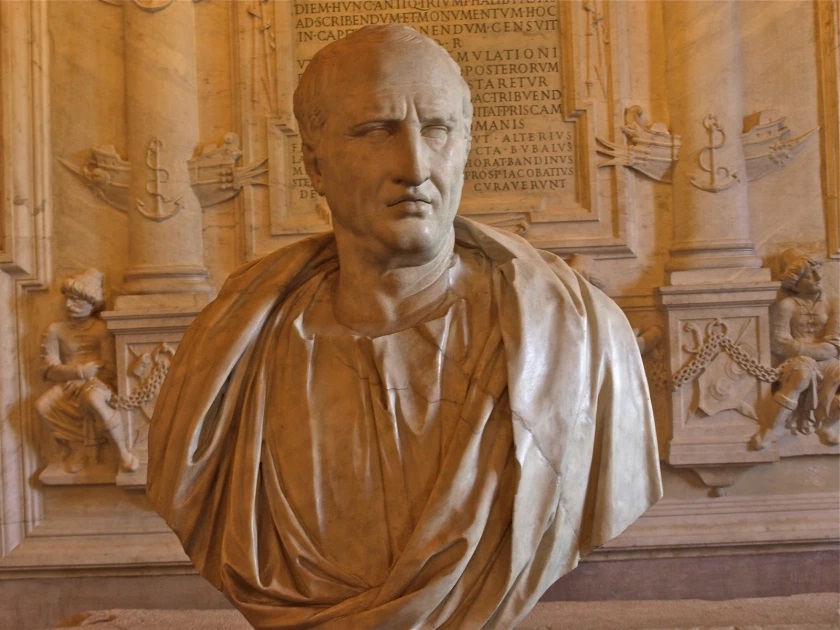
Pour Inghirami, fasciné par l’éloquence et le style de Cicéron (-106/-43 av. JC) dont il se croyait la réincarnation, le défi lancé par Pic de la Mirandole de réconcilier Apollon, Pythagore, Platon et Aristote, se présenta quasiment comme une mise à l’épreuve divine et les fresques de Raphaël ornant la « Chambre de la signature » sera avant tout sa réponse.
A ceci s’ajoute que Cicéron lui-même se réclamait du néo-platonisme. Dans le premier volume de son œuvre, les Secondes Académiques, après avoir condamné Socrate pour continuellement poser des questions sans jamais « poser les bases d’un système de pensée », Cicéron affirme, plusieurs siècles avant Pic de la Mirandole, que les idées de Platon et d’Aristote, en essence, « avaient les mêmes principes » :
A l’ombre du génie de Platon, génie fécond, varié, universel, s’établit une philosophie unique sous la double bannière des académiciens et des péripatéticiens, qui, d’accord sur les choses, ne différaient que sur les termes. Car Platon, qui avait fait en quelque sorte de Speusippe, fils de sa sœur, l’héritier de sa philosophie, laissait aussi deux disciples de grand talent et d’une rare science, Xénocrate de Chalcédoine et Aristote de Stagire : ceux qui suivaient Aristote, furent nommés péripatéticiens, parce qu’ils discouraient en se promenant dans le Lycée ; tandis que ceux qui, d’après l’institution de Platon, tenaient leurs assemblées et dissertaient dans l’Académie, l’autre gymnase d’Athènes, reçurent de ce lieu-même le nom d’Académiciens. Mais les uns et les autres, tous pénétrés du fécond génie de Platon, formulèrent la philosophie en un certain système complet et achevé, et abandonnèrent le doute universel de Socrate, et son habitude de discuter sur tout sans rien affirmer. Il y eut alors ce que Socrate désapprouvait entièrement, une science philosophique, avec des divisions régulières et tout un appareil méthodique. Cette philosophie, comme je l’ai dit, sous une double dénomination, était une ; car, entre la doctrine des péripatéticiens [Aristote] et l’ancienne Académie [Platon], il n’y avait aucune différence. Aristote l’emportait, à mon sens, par la richesse de son génie ; mais les uns et les autres avaient les mêmes principes, et jugeaient pareillement des biens et des maux.

Inghirami a également été conforté par la lecture d’innombrables auteurs chrétiens allant dans ce sens comme par exemple le Français, Bernard de Chartres (XIIe siècle) , un philosophe néoplatonicien ayant joué un rôle fondamental dans l’école de Chartres, qu’il fonda. Il fut nommé maître (1112) puis devient chancelier (1119) responsable de l’enseignement de l’école cathédrale.
Vous me demanderez alors, pourquoi figurent côte à côte, sur le portail occidental de la cathédrale, les sculptures de Pythagore et d’Aristote ?
Etienne Gilson écrit :
Bernard de Chartres était tout d’abord influencé par Boèce, dont il adapte le platonisme. Il s’attache ensuite à réconcilier la pensée de Platon avec celle d’Aristote, ce qui fera de lui le plus grand penseur aristotélicien et platonicien du XIIe siècle. Jean de Salisbury affirmait, dans les termes les plus formels que Bernard de Chartres et ses disciples ne croyaient pas exposer simplement la pensée de Platon en expliquant de la sorte le rapport des idées aux choses, mais qu’ils avaient la prétention de mettre en accord Aristote avec Platon. Que la peine qu’ils se sont donnée ait été perdue, c’est ce que Jean de Salisbury affirme nettement. Avec un humour bien britannique il constate que ces philosophes sont arrivés trop tard et qu’ils ont inutilement travaillé à réconcilier des morts qui s’étaient disputés pendant toute leur vie.
Inghirami aura forcément lu saint Bonaventure (1217-1274), un des fondateurs de l’ordre des franciscains qui soulignait que Platon et Aristote excellaient chacun dans son domaine :
Et ainsi il apparaît que parmi les philosophes, le don de Platon est de parler de la sagesse, celui d’Aristote de la science.
Ou encore le florentin Marsile Ficin, ce philosophe néo-platonicien du XVe siècle dont « l’Académie platonicienne » avait mis en selle Pic de la Mirandole. Le Ficin, n’avait-il pas écrit dans sa Théologie platonicienne que
Platon traite des choses naturelles divinement tandis qu’Aristote traite naturellement même des choses divines.
Dans la préface qu’il écrira pour La fable d’Orphée, une pièce de théâtre écrite par son disciple Ange Politien (1454-1494), le Ficin, se référant à saint Augustin, fait du mythique Hermès Trismégiste (Mercure) le premier des théologiens : son enseignement aurait été transmis successivement à Orphée, Aglaophème, Pythagore, Philolaos et enfin Platon.
Par la suite, le Ficin placera Zoroastre en tête de ces prisci theologi, pour attribuer finalement à Zoroastre et Mercure un rôle identique dans la genèse de la sagesse antique : Zoroastre enseigne celle-ci chez les Perses en même temps que Trismégiste l’enseignait chez les Égyptiens.
Un Platon peut cacher un Pythagore

On remarquera que dans L’Ecole d’Athènes de Raphaël, la figure de Pythagore de Samos (-580/-495 av. JC) , entouré d’un groupe d’admirateurs, prend une place majeure. Il est clairement identifiable par une tablette où figurent les accords musicaux et la fameuse « Tétraktys » dont nous parlerons ici.
Alors que jusqu’ici, les historiens ont surtout exploré l’influence du courant platonicien et néo-platonicien sur la Renaissance italienne, l’historienne Christiane L. Joost-Gaugier, dans son livre Pythagoras and Renaissance Europe, a mis en lumière à quel point les idées du grand penseur présocratique que fut Pythagore, ont influencé la pensée et façonné l’art de la Renaissance.
En art, Pythagore inspire l’architecte romain Vitruve (-90/-15 av. JC, puis les théoriciens de la proportion d’or comme le moine franciscain Luca Paciolo (1445-1517) , dont le traité, De Divina Proportiona, illustré par Léonard de Vinci, parut à Venise en 1509.
Cependant, si un théorème, venu probablement d’Inde, porte son nom (attribué à Pythagore par Vitruve), l’on sait assez peu de sa vie.
Tout comme Confucius, Socrate et le Christ, si l’on est sûr qu’il a réellement existé, aucun écrit de sa main ne nous est parvenu.
Par la force des choses, Pythagore est devenu une légende vivante, et même très active lors de la Renaissance, à tel point que la plupart des gens ne voyait qu’en Platon un simple « disciple » du « divin Pythagore ».

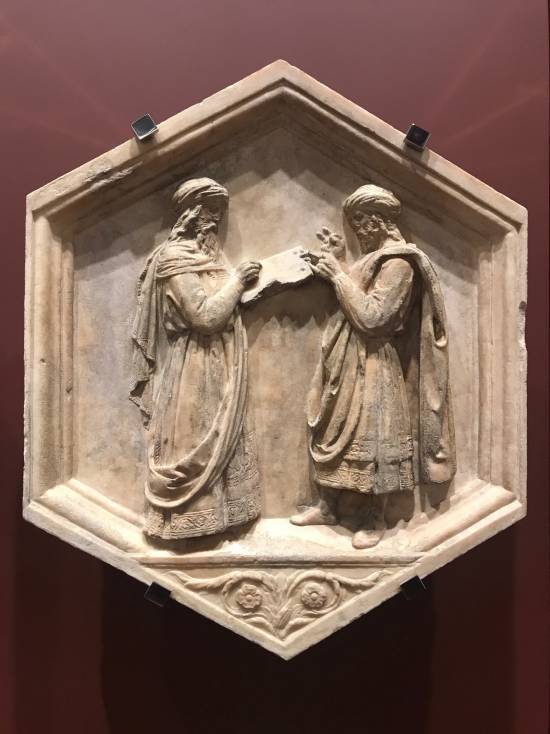
Né dans la première moitié du VIe siècle avant JC. sur l’île de Samos en Asie mineure, il fut sans doute en contact avec l’école des géomètres fondée par Thalès de Milet (-625/-548 av. JC) .
Vers l’âge de 40 ans, il part vers Crotone en Italie méridionale pour y fonder une société d’amis, à la fois philosophique, politique et religieuse dont les implantations vont se multiplier.
Pour Pythagore, il s’agit de réaliser un lien entre l’homme et le divin et sur cette base transformer la cité. Interrogé sur son savoir, Pythagore, avant Socrate et Cues, affirme qu’il ne sait rien mais qu’il cultive « l’amour de la sagesse ». Le mot philo-sophie serait né ainsi.
Aucun humaniste chrétien, lisant saint Jérôme (347-420) , un des Pères de l’Église catholique, ne pouvait échapper aux éloges que ce dernier fait à Pythagore.
Dans sa polémique Contre Ruffin, Jérôme, pour évoquer un comportement exemplaire, cite ce qu’aurait dit deux disciples de Pythagore : « Nous devons par tous les moyens possibles éviter la mollesse du corps, l’ignorance de l’esprit, l’intempérance, les dissensions civiles, les dissensions domestiques et en général l’excès en toutes choses ». Et Jérôme invoque les « préceptes de Pythagore » :
Tout doit être commun entre amis ; un ami est un autre nous-même. Il faut considérer deux époques dans la vie, le matin et le soir, c’est-à-dire ce que nous avons fait et ce que nous devons faire. Après Dieu, il faut chercher la vérité, qui seule peut rapprocher les hommes du Créateur.
Ensuite, Jérôme estime que Pythagore, en affirmant le concept d’immortalité de l’âme, a précédé le christianisme :
Ecoutez ce que Pythagore a trouvé le premier en Grèce s’élance Jérôme : Que les âmes sont immortelles, qu’elles passent d’un corps dans un autre, et, c’est Virgile qui lui-même nous dit dans le sixième livre de l’Enéïde : Lorsqu’elles ont fourni une révolution de mille ans, Dieu les appelle en grand nombre sur les bords du fleuve Léthé pour que sans doute elles puissent revoir le ciel dont elle ne se souviennent plus ; c’est alors qu’elles recommencent à ranimer un nouveau corps, qui d’abord a été Euphorbus, ensuite Calide, puis Hermoticus, puis Perhius et enfin Pythagore ; et qu’après un certain temps ce qui a existé recommence à naître, qu’il n’y a rien de neuf dans le monde, que la philosophie est un recueil de méditations sur la mort, que chaque jour elle s’efforce de délivrer l’âme des chaînes qui l’attachent au corps et de lui rendre sa liberté. Platon nous communique bien d’autres idées dans ses écrits, surtout dans le Phédon et dans le Timée.
La géométrie cachée des nombres
Pour Pythagore « le commencement est la moitié de tout ». D’après Théon de Smyrne (v. 70/v. 135) , pour le philosophe, « les nombres sont pour ainsi dire le principe, la source et la racine de toutes choses ».
Aristote, dans sa Métaphysique rapporte :
Les pythagoriciens s’appliquèrent dans un premier temps aux mathématiques… Trouvant que les choses [dont les sons musicaux] modèlent principalement leur nature sur l’ensemble des nombres et que les nombres sont les premiers principes de la nature entière, les Pythagoriciens conclurent que les éléments des nombres sont aussi les éléments de tout ce qui existe, et ils firent du monde une harmonie et un nombre…
Et comme le précisait Clinias de Tarente (IVe siècle av. JC.), un pythagoricien ami de Platon :
Quand ces choses, donc, sont au repos, elles donnent naissance aux mathématiques et à la géométrie, quand elles sont en mouvement à l’harmonica et à l’astronomie.
L’idée de la « monade », une unité dynamique participant de l’Un, perfectionnée plusieurs siècles après par le philosophe et scientifique Gottfried Wilhelm Leibniz (1646-1716) dans sa « Monadologie », nous vient de cette époque.
Signifiant étymologiquement « unité » (monas), il s’agit de l’unité suprême (l’Un, Dieu, le principe des nombres) qui, tout en étant en même temps l’unité minimale, reflète dans le microcosme la même activité dynamique que représente l’Un dans le macrocosme.
Déjà, rien que le nom d’Apollon (Un dieu considéré comme « le père » de Pythagore) signifie, comme le soulignent Platon, Plutarque et d’autres auteurs de l’antiquité : libre de toute multiplicité (Pollo = multiplicité ; a-pollo = non-multiple).
Xénophane (né vers 580 av. JC), affirme l’existence d’un Dieu unique gouvernant toute chose par la puissance de son intelligence. Il s’agit d’un dieu point semblable aux hommes, car éternel, incorporel et sphérique.

Autant cette conception d’un Un dynamique a pu provoquer parfois une explosion d’interprétations ésotériques, autant elle a stimulé les esprits les plus créatifs et terrorisé les formalistes de la pensée.
En parlant de simples choses, des nombres arithmétiques, Pythagore emploie les terme de un, deux, trois, quatre, cinq, dix…, tandis que pour évoquer des nombres idéaux et leur puissance, il parle de : monade, dyade, triade, tétrade, décade, etc.
Ainsi, en concevant les nombres de façon non-linéaire mais figurative, il offre une arithmétique applicable à l’astronomie, la musique et l’architecture. En disposant ces nombres, comme des billes, d’une façon particulière, Pythagore découvre la fameuse « géométrie des nombres ».
Par exemple, dans le cas des nombres triangulaires, trois points forment une surface triangulaire. Si l’on y rajoute trois points en dessous, on trouve le nombre 6, mais il s’agit toujours d’un triangle. Et si l’on y ajoute encore quatre points supplémentaires, on aboutit au nombre 10, toujours un nombre triangulaire.
Le Patriarche de Constantinople Photius (810-893) confirme que :
Les pythagoriciens proclamaient que le nombre complet est dix.
Le nombre dix, est un composé des quatre premiers nombres que nous comptons dans leur ordre. C’est pourquoi ils appelaient Tétraktys le tout constitué par ce nombre.
A part les nombres plans et triangulaires (1, 3, 6, 10, etc.), Pythagore explorera les nombres carrés (1, 4, 9, 16, …), rectangulaires, cubiques, pyramidaux, étoilés, etc.
Ce faisant, disait Aristoxène, Pythagore avait « élevé l’arithmétique au-dessus des besoins des marchands ».
Cette approche, celle de voir l’harmonie au-dessus et dans le multiple, a inspiré de nombreux scientifiques dans l’histoire. On pense à Mendeleïev pour l’élaboration de son tableau des éléments ou à Einstein.
La puissance des nombres était également bien comprise par le cardinal-philosophe Nicolas de Cues, qui évoque Pythagore dès le premier chapitre de son traité De la docte Ignorance (1440), lorsqu’il précise que :
Tous ceux qui recherchent jugent de l’incertain, en le comparant à un présupposé certain par un système de proportions. Toute recherche est donc comparative, et elle use du moyen de la proportion : si l’objet de la recherche se laisse comparer au présupposé par une réduction proportionnelle peu étendue, le jugement d’appréhension est aisé ; mais si nous avons besoin de beaucoup d’intermédiaires, alors naissent la difficulté et la peine. Cela est bien connu dans les mathématiques : les premières propositions s’y ramènent aisément aux premiers principes très bien connus, tandis que les suivantes, parce qu’il leur faut l’intermédiaire des premières, y ont plus de difficulté. Donc toute recherche consiste en une proportion comparative facile ou difficile, et c’est pourquoi l’infini qui échappe, comme infini, à toute proportion, est inconnu. Or, la proportion qui exprime accord en une chose d’une part et altérité d’autre part, ne peut se comprendre sans le nombre. C’est pourquoi le nombre enferme tout ce qui est susceptible de proportions. Donc, il ne crée pas une proportion en quantité seulement, mais en tout ce qui, d’une façon quelconque, par substance ou par accident, peut concorder et différer. Aussi Pythagore jugeait-il avec vigueur que tout était constitué et compris par la force des nombres. Or, la précision des combinaisons dans les choses matérielles et l’adaptation exacte du connu à l’inconnu sont tellement au-dessus de la raison humaine que Socrate estimait qu’il ne connaissait rien que son ignorance ; en même temps que le très sage Salomon affirme que toutes les choses sont difficiles et que le langage ne peut les expliquer.
Géométrie des nombres,
le secret du calcul mental
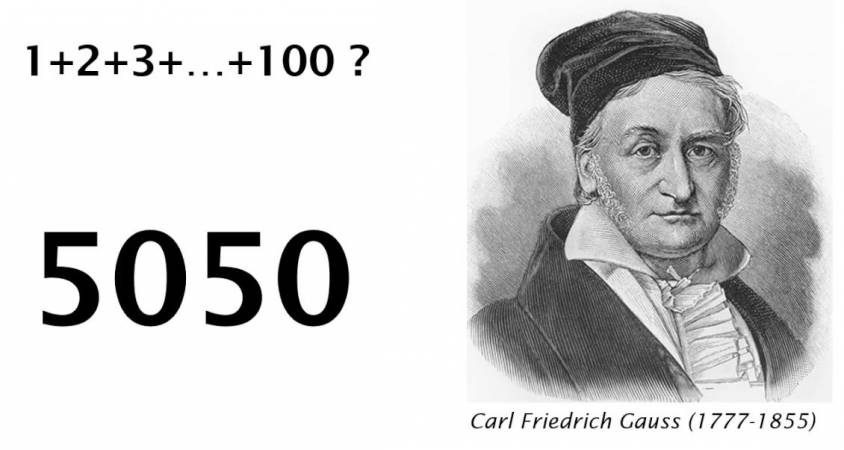
Voici un petit exemple très simple. Un jour, à Göttingen, le professeur du jeune mathématicien allemand Carl Gauss (1777-1855) demanda aux élèves de calculer la somme de tous les chiffres de un à cent.
Les élèves s’exécutent et commencent à additionner les chiffres 1 + 2 + 3 + 4 + 5, etc.
Le jeune Gauss lève la main et, suite à un calcul mental, annonce le résultat de l’opération : « 5050, Monsieur ! »
Le professeur lui demande comment il est arrivé aussi vite au résultat. Le jeune Gauss s’explique : pour voir s’il existe une géométrie dans le nombre cent, j’ai additionné le premier chiffre (1) avec le dernier (100). Cela donne 101. Maintenant, si j’additionne le deuxième chiffre (2) avec l’avant dernier (99), cela fait également 101. J’ai conclu qu’il existait, à l’intérieur du nombre 100, cinquante couples de nombres pairs et impairs dont la somme était chaque fois 101. Ainsi, en multipliant 101 par le nombre de couples (50), j’arrive immédiatement à 5050.
————————————————————-
De Pythagore à Platon

Pour Pythagore, la surface la plus parfaite est le cercle et le volume idéal la sphère puisqu’on peut y inscrire les polyèdres réguliers.
Selon un de ses disciples, l’italien Philolaus de Crotone (-470/-390 av. JC) , Pythagore aurait été le premier à définir les cinq polyèdres réguliers :
- le cube,
- le tétraèdre (une pyramide à 4 faces triangulaires),
- l’octaèdre (composé de 8 triangles),
- l’icosaèdre (64 triangles) et
- le dodécaèdre (composé de 12 pentagones).
Puisque Platon les décrit dans son œuvre, le Timée, ces polyèdres réguliers prirent le nom de « solides platoniciens ».
Rappelons que Platon s’est rendu plusieurs fois en Italie, notamment pour y rencontrer son ami intime, le grand scientifique et dirigeant politique pythagoricien, Archytas de Tarente (-428/-387).
Disciple direct de Philolaos, Archytas deviendra le professeur de mathématiques de l’astronome et médecin grec Eudoxe de Cnide (-408/-355) .

Dès Archytas peut-être ou après Platon, les pythagoriciens associent le 1 au point, le 2 à la ligne, le 3 à la surface (la figure géométrique à deux dimensions : cercle, triangle, carré… ), le 4 au solide (la figure géométrique à trois dimensions : tétraèdre, cube, sphère, etc.).
Ajoutons à cela que dans le Timée, un des derniers dialogues de Platon, après un bref échange avec Socrate, Critias et Hermocrate, le philosophe pythagoricien Timée de Locres (Ve siècle av. JC) expose une réflexion sur l’origine et la nature du monde physique et de l’âme humaine vues comme les œuvres d’un démiurge tout en abordant les questions de la connaissance scientifique et de la place des mathématiques dans l’explication du monde.
Cicéron (République, I, X, 16) précise que Timée de Locres était un intime de Platon :
Sans doute as-tu appris, Tubéron, qu’après la mort de Socrate, Platon se rendit d’abord en Égypte pour s’y instruire, puis en Italie et en Sicile, afin de tout apprendre des découvertes de Pythagore. C’est là qu’il vécut longtemps dans l’intimité d’Archytas de Tarente et de Timée de Locres, et eut la chance de se procurer les Commentaires de Philolaos.
La musique des sphères
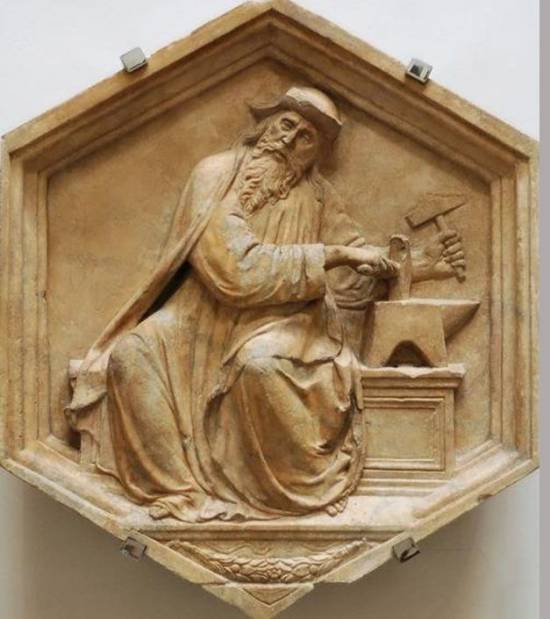
Un magnifique bas-relief, sur le campanile du dôme de Florence, reflète bien ce que savaient les premiers humanistes italiens au sujet de Pythagore.
Luca della Robia (1399-1482), le sculpteur travaillant sur les instructions du chancelier humaniste de Florence Leonardo Bruni (1370-1444) , nous montre Pythagore, un gros marteau dans une main, un petit marteau dans l’autre, frappant une enclume et concentrant son esprit sur la différence des sons qu’il produit.
Selon la légende, Pythagore se promenait aux abords d’une forge lorsque son attention fut captée par le son des marteaux frappant l’enclume.
Il y discerna à l’oreille les mêmes consonances que celles qu’il pouvait produire avec sa lyre. Son intuition mena alors à une découverte fondamentale : les sons musicaux sont gouvernés par les nombres.

Voilà comment Guido d’Arezzo (992-1050), le moine bénédictin à l’origine du système de notation musicale encore en vigueur, rapporte vers 1026 l’événement au dernier chapitre (XX) de son ouvrage Micrologus :
Un certain Pythagore, grand philosophe, voyageait d’aventure ; il arriva à un atelier où l’on frappait sur une enclume à l’aide de cinq marteaux. Étonné de l’agréable harmonie [concordiam] qu’ils produisaient, notre philosophe s’approcha et, croyant tout d’abord que la qualité du son et de l’harmonie [modulationis] résidait dans les différentes mains, il interchangea les marteaux. Cela fait, chaque marteau conservait le son qui lui était propre. Après en avoir retiré un qui était dissonant, il pesa les autres, et, chose admirable, par la grâce de Dieu, le premier pesait douze, le second neuf, le troisième huit, le quatrième six de je ne sais quelle unité de poids. Il connut ainsi que la science [scientiam] de la musique résidait dans la proportion et le rapport des nombres [in numerorum proportione et collatione]
[…] Que dire de plus ? En mettant en ordre les notes d’après les intervalles dont on a parlé, l’illustre Pythagore fut le premier à mettre au point le monocorde. Comme ce n’est pas lascivité qu’on y trouve, mais une révélation rapide de la connaissance de notre art, il a rencontré un assentiment général chez les savants. Et cet art s’est peu à peu affirmé en se développant jusqu’à ce jour, car le Maître lui-même illumine toujours les ténèbres humaines et sa suprême Sagesse dure dans tous les siècles. Amen.
Voici le schéma (qui se retrouve sur une ardoise posée aux pieds de Pythagore dans la fresque de Raphaël), et qui visualise les harmonies musicales que l’on obtient en divisant un corde. Si l’on la divise en deux, cela donne l’octave, en trois la quinte et en quatre, la quarte. Enfin, épogdoon (du préfixe epi– signifiant au-dessus et ogdoon signifiant le huitième) traduit l’intervalle de 9/8, qui correspond ici au ton.

Reprenons donc les rapports harmoniques que découvre Pythagore à partir des poids des marteaux : 12, 9, 8 et 6.
- Le rapport entre 12 et 6, c’est la moitié et correspond à l’octave (diapason). On la retrouve sur un instrument de musique en faisant vibrer la moitié d’une corde.
- Le rapport entre 12 et 8 est un rapport de deux tiers, ce qui correspond à la quinte (diapente) ;
- Le rapport entre 8 et 6, est un rapport de trois quarts, ce qui correspond à la quarte (diatessaron) ;
- Enfin, le rapport entre 8 et 9 donne l’intervalle d’un ton (épogdoon, le préfixe epi– signifiant au-dessus et ogdoon signifiant le huitième.)
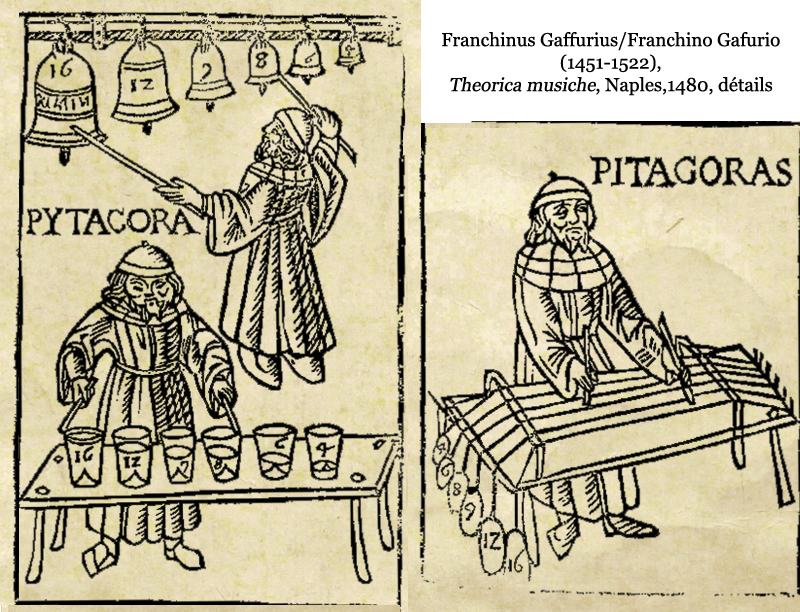
Ensuite, les pythagoriciens transposèrent les mêmes proportions à d’autres objets, notamment à des volumes d’eau dans des verres, à la taille de cloches ainsi qu’à des disques en bronze ou encore à la longueur des cordes d’instruments de musique ou des flutes.
Pour Pythagore, cette expérience s’avère fondamentale car elle corrobore l’intuition de base de sa philosophie : tout ce qui existe est nombre, y compris des phénomènes aussi peu matériels que les intervalles musicaux.
Dans un fameux passage du Timée (35-36), Platon décrit la fabrication des proportions de l’Âme du Monde par le Démiurge. Ce passage est fondé sur la série numérique 1, 2, 3, 4, 9, 8, 27 — qui correspond à la fusion de la série des premières puissances de 2 (2, 4, 8) et de la série des premières puissances de 3 (3, 9, 27). Or, de cette série, on peut tirer les rapports numériques sur lesquels sont fondés les intervalles musicaux.
Déjà, dans sa Métaphysique, Aristote avait rapporté :
Les pythagoriciens remarquèrent que l’ensemble des modes de l’harmonie musicale et les rapports qui la composent se résolvent dans des nombres proportionnels.
Avec le philosophe français Pierre Magnard, il faut plutôt dire :
Si connaître c’est mesurer, la musique est l’art de poursuivre la mesure au-delà du seuil de l’incommensurabilité. Quand les étalons numériques, métriques et pondéraux ne sont plus capables d’établir de proportions entre les réalités naturelles, l’harmonie vient offrir le secours de ses propres échelles – diatonique, chromatique, enharmonique – et de ses intervalles – quinte, quarte, tierce, octave – pour subvenir au défaut du calcul.
Enfin, comme le précisa le musicologue romain Théon de Smyrne (70-135) :
Les pythagoriciens affirment que la musique est une combinaison harmonique des contraires, une unification des multiples et un accord des opposés.
A cela s’ajoute que pour les pythagoriciens, la musique avait également une valeur éthique et médicale.
Il faisait commencer l’éducation par la musique, au moyen de certaines mélodies et rythmes, grâce auxquels il produisait des guérisons dans les traits de caractère et les passions des hommes, ramenait l’harmonie entre les facultés de l’âme.
Tout cela faisait donc de Pythagore l’incarnation d’une harmonie cosmique et universelle**.
D’ailleurs, il aurait été le premier à avoir utilisé le mot « cosmos » (perfection, ordre).

Pythagore, dont le premier vrai astrophysicien Johannes Kepler (1571-1630) fait l’éloge, aurait été le premier à forger le concept de « la musique des sphères » ou de « l’harmonie des sphères ».
Car, comme le précise Sextus Empiricus (vers la fin du IIe siècle), dans ses Esquisses pyrrhoniennes, Pythagore aurait constaté que les distances entre les orbites du Soleil, de la Lune et des étoiles fixes correspondent aux proportions réglant les intervalles de l’octave, de la quinte et de la quarte. Dans la République, Platon affirme qu’astronomie et musique sont des « sciences sœurs ».
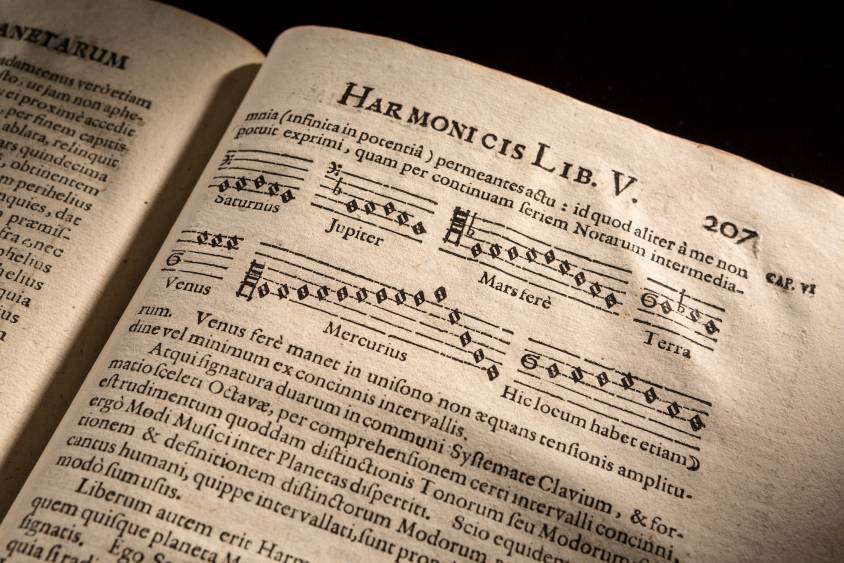
Copernic admet que les travaux des pythagoriciens ont inspiré ses propres recherches :
« D’autres pensent que la Terre se meut. Ainsi, Philolaos le pythagoricien dit que la Terre se meut autour du Feu en un cercle oblique, de même que le Soleil et la Lune. Héraclite du Pont et Ecphantos le Pythagoricien ne donnent pas, il est vrai, à la Terre un mouvement de translation [mouvement autour du Soleil, héliocentrisme]… Partant de là, j’ai commencé, moi aussi, à penser à la mobilité de la Terre »
(Copernic, lettre au pape Paul III, préface à De revolutionibus orbium cælestium [Des révolutions des orbes célestes], 1543).
Le nom de Pythagore (étymologiquement, Pyth-agoras : « celui qui a été annoncé par la Pythie », la déesse), découle de l’annonce de sa naissance faite par l’oracle à son père lors d’un voyage à Delphes. Cependant, la légende veut que Pythagore soit le fils d’Apollon, le dieu de la lumière, de la poésie et de la musique.
Or, d’après les traditions présocratiques les plus anciennes, Apollon, avait conçu un plan lui permettant de contrôler l’univers. Ce plan se révélait dans « la musique des sphères » sous la sage supervision d’Apollon, le dieu soleil et dieu de la musique ; un dieu grec passé chez les Romains sans avoir changé de nom. On représente Apollon avec une couronne de lauriers et une lyre, entouré des neufs muses.
VISITE GUIDÉE

Après avoir passé en revue la situation politique de l’époque, les motivations du Pape Jules II et de ses conseillers cherchant à rétablir l’autorité d’une « Eglise triomphante », aboutissement ultime et pour les siècles à venir d’une culture qui remonte à Apollon, Moïse, Pythagore, Platon, Cicéron et leurs disciples, le spectateur a désormais quelques « clés » solides (les « codes ») en main lui permettant de « lire » les fresques de Raphaël ornant la « Chambre de la signature ».
Ne disposant d’aucun récit de Raphaël sur son œuvre, cette lecture reste un parcours d’obstacles. Par exemple, l’identification des personnages reste incertaine car, à part quelques rares exceptions, aucune tablette ne nous l’indique. L’idée, de toute façon, c’est que le spectateur, en analysant l’apparence et la gestuelle de chacun, découvre par lui-même, qui est représenté.
Comme nous l’avons dit, en entrant dans la salle, le spectateur est d’emblée sommé d’apprécier chaque fresque non pas de façon isolée, mais comme étant l’expression d’un tout cohérent.
En pénétrant dans la « Chambre de la signature », comme à l’intérieur d’un cube peint, on se rend immédiatement compte d’être face à une mise en scène théâtrale. Car les grandes voûtes que découvre le spectateur ne sont que des images peintes et ne répondent à aucune réalité structurelle de l’édifice. Inghirami était un orateur, un acteur et un metteur en scène sachant qui devait apparaître à quel endroit, avec quelle attitude et habillé de quelle façon. Grâce à cette imagination, une salle à priori rectangulaire et ennuyeuse, a été métamorphosée en un cube sphérique car les coins de la pièce ont été « arrondis » avec du stuc.
A. LE PLAFOND

Du point de vue thématique, le parcours visuel, comme on pouvait s’en douter, commence au plafond pour finir sur le parterre. Au centre du plafond, un petit cercle avec les armoiries de Jules II. Autour, un octogone entouré de quatre cercles reliés entre eux par quatre rectangles. Chacun des quatre cercles touche le haut d’une des quatre voûtes peintes sur les quatre murs et montre une figure allégorique et un texte annonçant le thème des grandes fresques en-dessous.
A chaque fois, il s’agit de mettre en valeur l’harmonie réunissant l’ensemble des parties. Alors que les vraies incompatibilités sont laissées au vestiaire, les oppositions et les différences formelles seront même fortement mises en valeur, mais exclusivement pour démontrer qu’on peut s’en accommoder en les soumettant à un dessein supérieur.

Ainsi deux doubles thèmes (2 x 2) s’articulent donc :
- La Philosophie (le vrai accessible par la raison), surnommée L’Ecole d’Athènes, et la Théologie (le vrai accessible par la révélation divine), surnommée depuis le concile de Trente, la « Dispute du Saint Sacrément » ; un thème commun à saint Thomas et aux néo-platoniciens.
- la Poésie et la musique (le beau), et la Justice (le droit) ; un thème d’origine cicéronienne.
- Au-dessus le thème de la Philosophie, dans l’un des quatre cercles, est représentée par une femme portant une robe dont chacune des quatre couleurs symbolise les quatre éléments évoqués par un motif : le bleu illustre les étoiles, le rouge les langues de feu, le vert les poissons et le brun doré les végétaux. La philosophie tient deux livres intitulés « Morale » et « Nature », tandis que deux petits genius (génies) portent des tablettes sur lesquelles on peut lire « CAUSARUM » et « COGNITO », lues ensemble « Connaître les causes ». En clair, le but de la philosophie morale et naturelle, est de connaître les causes, c’est-à-dire de remonter vers Dieu.
- Au-dessus de la Théologie, une femme habillée de rouge et de vert, couleurs des vertus théologiques. Dans sa main gauche, elle tient un livre, sa main droite pointe vers la fresque en bas. Deux génies portent des tablettes disant « DIVINAR.RER » et « NOTITIA », « La révélation des choses sacrées ».
- Au-dessus de la Poésie, la silhouette ailée de la Poésie portant lyre et couronne de lauriers. Deux putti (angelots) nous présentent des tablettes où sont inscrites des paroles de Virgile : « Insufflé par l’esprit » (NVMINE AFFLATVR). Puisqu’il s’agit de puttis et non pas de génies, il est clairement fait référence à l’esprit chrétien qui inspire les arts.
- Enfin, au-dessus de la dernière fresque, la Justice, une femme tient les attributs de la justice : la balance et le glaive. Deux putti portent des tablettes avec les paroles de l’empereur Justinien : « IVS SVVM VNICUMQUE », c’est-à-dire, « à chacun sa juste peine ».
Ensuite, toujours au plafond, comme nous l’avons indiqué, quatre fresques rectangulaires reliant les quatre cercles dont nous venons de spécifier la thématique. De nouveau, il s’agit de deux paires qui se complètent.

- A. Une première fresque rectangulaire, reliant la Philosophie avec la Poésie, nous montre une femme (la sagesse, l’Un) ici cause première et mettant un globe céleste en mouvement et donc l’univers en action. Il peut s’agir de la Sibylle mythique que mentionne Héraclite, une incarnation surhumaine de la voix prophétique. Philosophiquement, il s’agit d’une allégorie de la création de l’Univers (ou Astronomie). La constellation qui figure sur le globe a été identifiée. Elle correspond à la carte du ciel de la nuit du 31 octobre 1503, la date de l’élection de Jules II…
- B. Le deuxième rectangle, diamétralement opposé du premier et reliant la Justice à la Théologie, représente « Adam et Eve chassés du Paradis ». Considéré comme le début de la théologie, « La chute de l’homme », sera réparée par la « rédemption » qu’apporteront l’Église et le pape Jules II, incarnée par la sagesse créatrice remettant l’univers en marche.
- C. Le troisième rectangle, reliant la Philosophie et la Justice, représente « Le jugement de Salomon », une scène montrant le jugement sage du Roi Salomon lorsque deux mères réclamèrent le même enfant.
- D. Et enfin, le quatrième, de l’autre extrémité de la diagonale, reliant la Poésie à la Théologie, représente, non pas « La flagellation de Marsyas » comme on l’a prétendu, mais une autre scène assez rare, « Le Triomphe d’Apollon contre Marsyas » dans la lutte pour la lyre. Ce dernier y reçoit une couronne de lauriers.
Pour leur mise en valeur mutuelle, les deux jugements se fondent sur des bases différentes. Alors que le roi Salomon, représentant l’Ancien Testament, juge sur la base de la Loi divine, Apollon, qui représente ici l’Antiquité, l’emporte grâce aux règles du panthéon païen.
B. LA THÉOLOGIE
(LA DISPUTE DU SAINT SACREMENT)

Au registre céleste :
A. Dieu le Père, B. Jésus Christ, C. Marie, D. Saint-Jean Baptiste, E. Apôtre Pierre, F. Adam, G. Saint Jean l’Evangéliste, H. Roi David, I. Saint Laurent, J. Judas Macchabée, K. Saint Stéphane, L. Saint Étienne, M. Moïse, N. Jacques le Majeur, O. Abraham, P. Saint Paul, SE. Saint Esprit.
Au registre terrestre :
1. Fra Angelico, 2. ?, 3. Donato Bramante, 4. ?, 5. ?, 6. Pic de la Mirandole, 7. ?, 8. ?, 9. ?, 10. Saint Grégoire, 11. Saint Jérôme, 12. ?, 13. ?, 14. ?, 15. ?, 16. Saint Ambroise, 17. Saint Augustin, 18. Saint Thomas d’Aquin, 19. Le pape Innocent III, 20. Saint Bonaventure, 21. Le pape Sixte IV, 22. Dante Alighieri, 23. ?, 24. ? ; 25. un maçon, 26. ?, 27. ?
Les historiens nous disent qu’elle fut la première fresque à être réalisée. Le cœur du sujet est la Trinité et la « transsubstantiation », un phénomène surnaturel signifiant la conversion d’une substance en une autre, chez les chrétiens, la conversion du pain et du vin en corps et sang du Christ lors de l’Eucharistie sous l’action du Saint Esprit. Ce qui signifiait une « présence réelle » de Dieu lors de la messe et donc un attrait majeur pour attirer les fidèles et obtenir des « indulgences » de sa part. Pour certains humanistes, tels que le protestant suisse Zwingli, toute doctrine de la présence réelle relève de l’idolâtrie car elle reviendrait à vénérer du pain et du vin comme si c’était Dieu.
Erasme, pour qui l’accomplissement des rites ne devait jamais se substituer à la vraie foi, explique que lorsque le Christ disait à ses disciples, en leur offrant du pain, « ceci est mon corps » et « ceci est mon sang », en leur offrant du vin, parlait en réalité, non pas du pain et du vin, mais de ses disciples (son corps) et de son enseignement (son sang).
L’idée qui sous-tend la composition, celle de montrer le triomphe de l’unité de l’Église dans le Christ, maximalise là-aussi les complémentarités.
La scène se déroule sur deux niveaux, un registre céleste et l’autre terrestre.
En haut, au registre céleste, le cœur du sujet, « la Trinité » avec Dieu le Père (A) bénissant trônant au-dessus d’un Christ (C) entouré de Marie (B) (le Nouveau Testament) à sa droite et de Saint-Jean Baptiste (D) (l’Ancien Testament) à sa gauche, eux-mêmes apparaissant au-dessus d’une colombe symbolisant le Saint-Esprit (SE). Autour d’eux, pour faire le pendant de l’architecture de L’Ecole d’Athènes située en face, assises paisiblement sur une banquette de nuages en demi-cercle, les figures remarquables de l’Église triomphante, accompagnées de leurs attributs traditionnels et vêtues d’habits colorés spécifiques de chacune. Aux extrémités du demi-cercle, deux apôtres : l’apôtre Pierre (E) qui représente les Juifs et l’apôtre Paul (P) qui représente les Gentils, se font face, un peu comme s’ils étaient les gardes extérieurs de l’Église triomphante, dépositaires à la fois de la clé et de la lettre de celle-ci. L’Ancien Testament est représenté par Adam (F) qui fait face à Abraham (O), et Moïse (M) face au roi David (H) avec sa harpe à la main. Le Nouveau Testament est également représenté par saint Jean (G) qui fait face à saint Mathieu (N) (deux auteurs de l’Évangile), par saint Laurent (I) et saint Étienne (L) (tous deux saints martyrs).
En bas, au registre terrestre, trône un énorme autel (Y) sur lequel est écrit « IV LI VS » (Jules II). Posé dessus, un ostensoir en or (X) avec une hostie en son centre, proclame la présence du Christ dans le mystère de la transsubstantiation. A côté, les docteurs de l’Église des premiers temps du christianisme : à gauche (sous les traits de Jules II) saint Grégoire (N° 10), le grand réformateur du rituel et du chant de messe, à côté de saint Jérôme (N° 11), l’érudit le plus profond du christianisme), accompagné de son lion. A sa droite saint Augustin (N° 17) et saint Ambroise (N° 16). Ces quatre docteurs sont, au contraire des autres personnages, assis, sur ce qui les rapproche déjà des personnages situés dans les cieux ; on distingue par ailleurs deux docteurs postérieurs que sont saint Thomas d’Aquin (N° 18), dominicain, et saint Bonaventure (N° 20), franciscain.
L’historien Konrad Oberhuber, ajoute que ces deux derniers,
incarnent deux tendances de l’Église : l’une qui voit son essence du christianisme dans le rituel et l’adoration dévote (la dimension du sentiment), l’autre qui défend l’importance de la théologie (la dimension de la pensée).
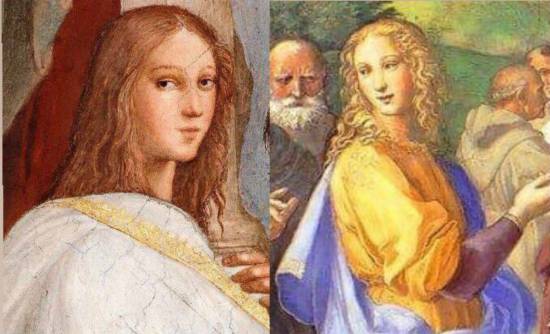
Ensuite, les papes Innocent III (1160-1216)(N° 19), pape le plus puissant du Moyen Âge qui établit l’indépendance politique de Rome) et Sixte IV (1414-1471) (N° 21), Francesco della Rovere de son nom) côtoient des religieux comme le dominicain Savonarole (instigateur en 1494 à Florence d’une révolution politique (retour à la République) et morale (rechristianisation) ou, le peintre Fra Angelico (N° 1), contemporain de Savonarole, admiré pour ses fresques et ses peintures sublimes, qu’accompagnent Dante Alighieri (N° 20), dont la Divine Comédie (avec l’enfer, le purgatoire et le paradis) eut une influence sur la théologie au Moyen Âge, Bramante, (N° 3) l’architecte fameux de la basilique Saint-Pierre, sans oublier Pic de la Mirandole (N° 6), (qu’on méprenait pour Francesco Maria della Rovere) qui, les cheveux dans le vent, pointe vers la Trinité dans un déhanchement léger et gracieux. A droite, des maçons (N° 22), qui construisent les églises, se penchent en avant. Si à droite, derrière les figures, les fondations de marbre blanc (Z), font allusion à la nouvelle basilique Saint-Pierre dont Jules II vient de lancer la reconstruction, à gauche une église villageoise (Q) rappelle que le christianisme doit pénétrer dans le quotidien des humbles.
C. LA PHILOSOPHIE
(L’ÉCOLE D’ATHENES)
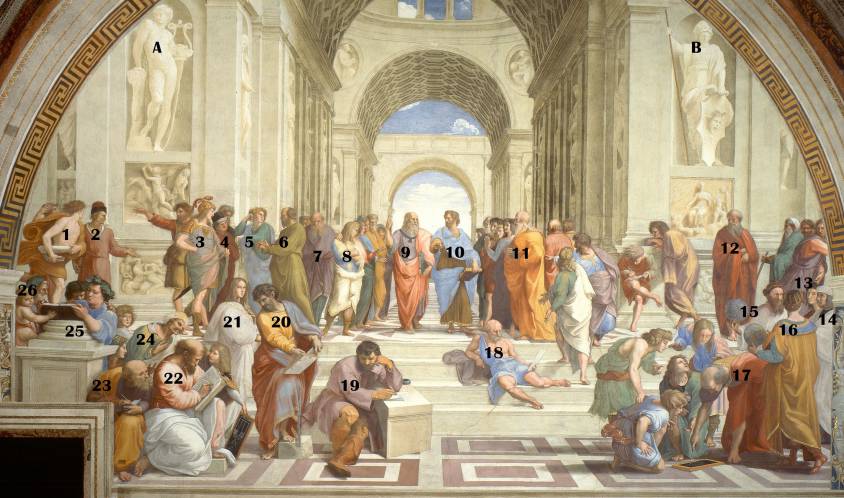
1. Porphyre, 2. Plotin, 3. Alcibiade, 4. Criton, 5. Phédon d’Elis, 6. Socrate, 7. Isocrate, 8. Parménide, 9. Platon, 10. Aristote, 11. ? ; 12. ?, 13. Appelles de Cos, 14. Protogène, 15. Strabon, 16. Ptolémée, 17 Hippocrate de Cos, 18. Diogène de Sinope, 19. Héraclite d’Éphèse, 20. Anaximandre de Milète, 21. Pic de la Mirandole, 22. Pythagore, 23. Boèce, 24. Avicenne, 25. Épicure, 26. Métrodore.
Une belle perspective centrale rassemble 58 penseurs grecs et d’autres personnages dans un temple idéal. Aucun effet de clair-obscur ne vient troubler l’équilibre des couleurs et la clarté de la composition.
Le penseur américain Lyndon LaRouche (1922-2019), lors de sa visite au Vatican, s’émerveilla de l’harmonie gracieuse qui rayonne de cette œuvre. Elle ne pouvait qu’entrer en résonance avec un concept que LaRouche développa tout au long de sa vie : celle de la « simultanéité de l’éternité » ; cette idée poétique que les idées « immortelles » continuent leur dialogue dans un lieu au-delà de l’espace-temps matériel.
Selon les historiens, Raphaël, face à la tâche herculéenne que représentait cette série de portraits à réaliser, et faute d’informations visuelles fiables sur les figures à représenter, aurait dépêché l’un de ses assistants en Grèce afin de lui fournir une documentation à la hauteur du défi.
Petit détail : il ne s’agit nullement d’Athènes ou de la Grèce, mais de Rome. L’architecture s’inspire clairement de l’église Sant-Andrea de Mantoue, rénovée peu avant sa mort par Léon Battista Alberti (1404-1472) et des projets du Bramante pour la reconstruction de la basilique Saint-Pierre à Rome.
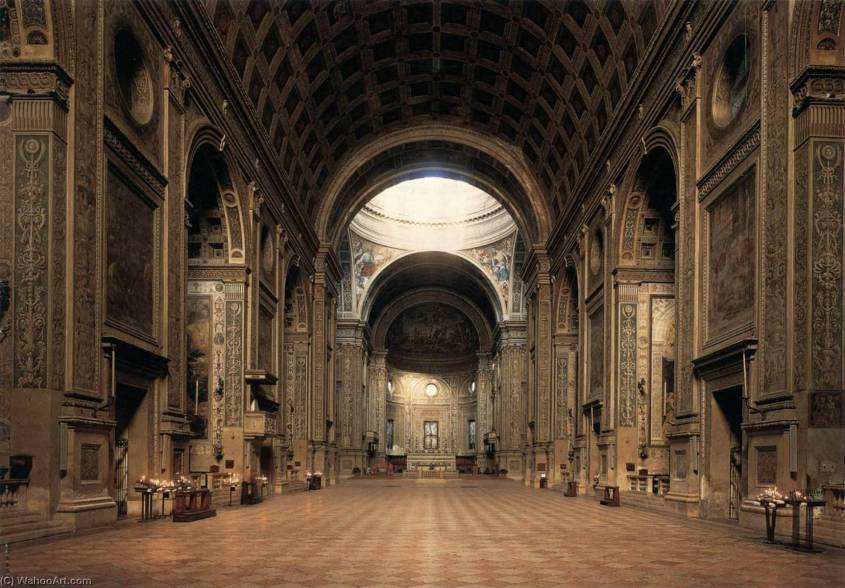
Si sur les dessins préparatoires on retrouve bien l’escalier, les grandes arches avec leurs voûtes à caissons, typiques de la coupole du Panthéon romain, n’y figurent pas. Autre source d’inspiration probable, les arches, elle aussi avec des voûtes à caissons, de la basilique de Maxence et Constantin, construite à Rome au début du IVe siècle pour réaffirmer la puissance de la beauté de la ville éternelle. Il n’est pas exclu que le Bramante lui-même, qui avait réalisé un trompe-l’œil faisant appel à ce type de motif dans l’abside de l’église Santa Maria presso San Satiro à Milan, les ait dessinées en personne. Avec trois arches (tetrade) et sept rangées de caissons, la numérologie pythagoricienne n’a pas été oubliée.
Visuellement, l’ensemble se divise en deux. Le public se trouve au même niveau que le premier plan, un parterre pavé derrière lequel un très large escalier conduit vers un parvis surélevé. Pour le spectateur, une perspective légèrement cavalière renforcera la dimension monumentale des figures du niveau supérieur. Ce cadre rappelle immanquablement celui d’un décor de théâtre. Les acteurs, arrivant de l’ancien monde, peuvent entrer en scène d’un côté, sous la statue du dieu grec Apollon (A), dieu de la lumière, et partir de l’autre, vers le nouveau monde, sous la statue de Pallas Athena (B) devenue Minerve chez les Romains, protectrice des Arts, échanger entre eux, s’adresser à l’auditoire ou monter les escaliers et sortir par le fond.
Au centre du parvis et au centre d’une perspective à point de vue central, Platon (N° 9) et Aristote (N° 10) y avancent côte à côte vers les spectateurs. Le premier, le Timée à la main, pointe un doigt vers le ciel signifiant qu’au-delà du visible, un principe supérieur existe. Le deuxième étend son bras et sa main à l’horizontale soulignant que toute vérité nous vient du témoignage des sens, tout en portant de l’autre bras l’Ethique. Bizarrement, il s’agit des deux seuls livres dans la stanza dont les noms apparaissent en italien (Timeo, Etica) et non pas en latin. Comme l’observe le critique d’art Eugenio Battisti (1924-1989) :
Si l’on (…) examine le titre des ouvrages respectivement tenus par Platon et Aristote, on y voit le philosophe de l’Académie tenir le Timée, c’est-à-dire le plus aristotélicien et le plus systématique de ses ouvrages et le stagirite, l’Éthique à Nicomaque, c’est-à- dire la plus platonicienne de ses œuvres.

Les couleurs des vêtements des deux philosophes symbolisent les quatre éléments : Platon est vêtu en rouge (le feu) et pourpre (l’éther) ; Aristote en bleu (l’eau) et jaune (la terre).
Si l’ensemble de la fresque coupe le monde en deux entre platoniciens et aristotéliciens, les deux marchent ensemble vers ce qui est devant eux et qui se trouve derrière le spectateur qui regarde : vers la fresque de La Théologie avec la Trinité au centre sans oublier l’ostensoir et l’imposant autel sur lequel est marqué « JV-LI-VS ». Quelle libéralité de l’Eglise d’accueillir tant de païens en son sein !

Raphaël communique ainsi un grand sens de mouvement. De la même façon qu’au XVIIe siècle, le peintre néerlandais Rembrandt, dans son chef-d’œuvre La Compagnie du capitaine Banninck Cocq, dite « La Ronde de nuit », rompra avec les représentations formelles des dignitaires des corporations de villes, Raphaël tire ici un trait sur les représentations figées et statiques des séries de « grandes hommes » décorant souvent les palais et bibliothèques des grands princes et seigneurs dans le style de son maître Le Pérugin.
Sa fresque, à l’instar de la Cène de Léonard à Milan, s’organise comme un enchaînement de petits groupes de trois ou quatre personnes dialoguant avec un grand penseur ou entre eux, sans jamais se désaccorder de ce qui se passe autour. Dans ce sens, Raphaël a traduit en images, et donc rendu accessible aux yeux des spectateurs, cette unité harmonique transcendant le multiple si recherchée par les commanditaires.
Raphaël et Inghirami n’ont pas hésité à se servir, pour représenter des figures historiques, des portraits de personnes vivant à leur époque. A part eux-mêmes, on y trouve leur commanditaire, leurs collègues ainsi que d’autres personnalités qu’ils espéraient satisfaire ou charmer.
Sur l’avant-plan, quatre groupes se présentent.
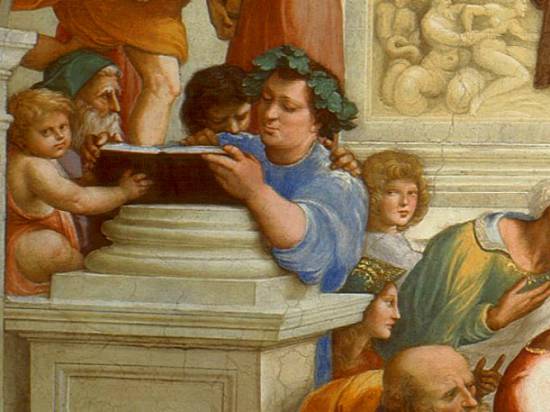
A gauche, Epicure (N° 25), ici avec les traits d’Inghirami en train d’écrire la mise en scène de la pièce. Né à Samos comme Pythagore, il porte ici, non pas une couronne de lauriers, récompense accordée aux grands orateurs, mais une couronne de feuilles de chêne, symboles que l’on retrouve dans l’armoirie du pape Jules II. Certains historiens pensent qu’Inghirami était un adepte dionysiaque de l’Orphisme, un autre courant présocratique. Dionysos est en effet le frère d’Apollon et selon certains, leurs enseignements ne font qu’un.
Comme nous l’avons mentionné plus haut, peu après la mort de Raphaël (1520), le cardinal Jacopo Sadoleto a publié un traité dans lequel Inghirami défend la rhétorique et nie toute valeur de la philosophie, son argument majeur étant que tout ce qui s’écrit figure déjà dans les textes mystiques et mythologiques d’Orphée et de ses adeptes.
A Rome, les érudits de l’époque connaissaient Epicure surtout par leurs lectures de Cicéron pour qui Epicure n’était pas un débauché mais quelqu’un qui cherchait le plaisir le plus noble. Cicéron entretenait une amitié avec un philosophe épicurien, un certain Phaedrus, comme par hasard le surnom d’Inghirami…
Enfin, à l’extrême gauche, se trouvent un vieillard barbu, le penseur grec Métrodore (N° 26), disciple d’Anaxagore et pour qui c’est « l’esprit agissant » qui organisa le Monde. Devant lui, un nouveau-né. Ensemble ils pourraient symboliser la naissance de la vérité (l’enfant) et la sagesse (le vieillard) et l’expérience.
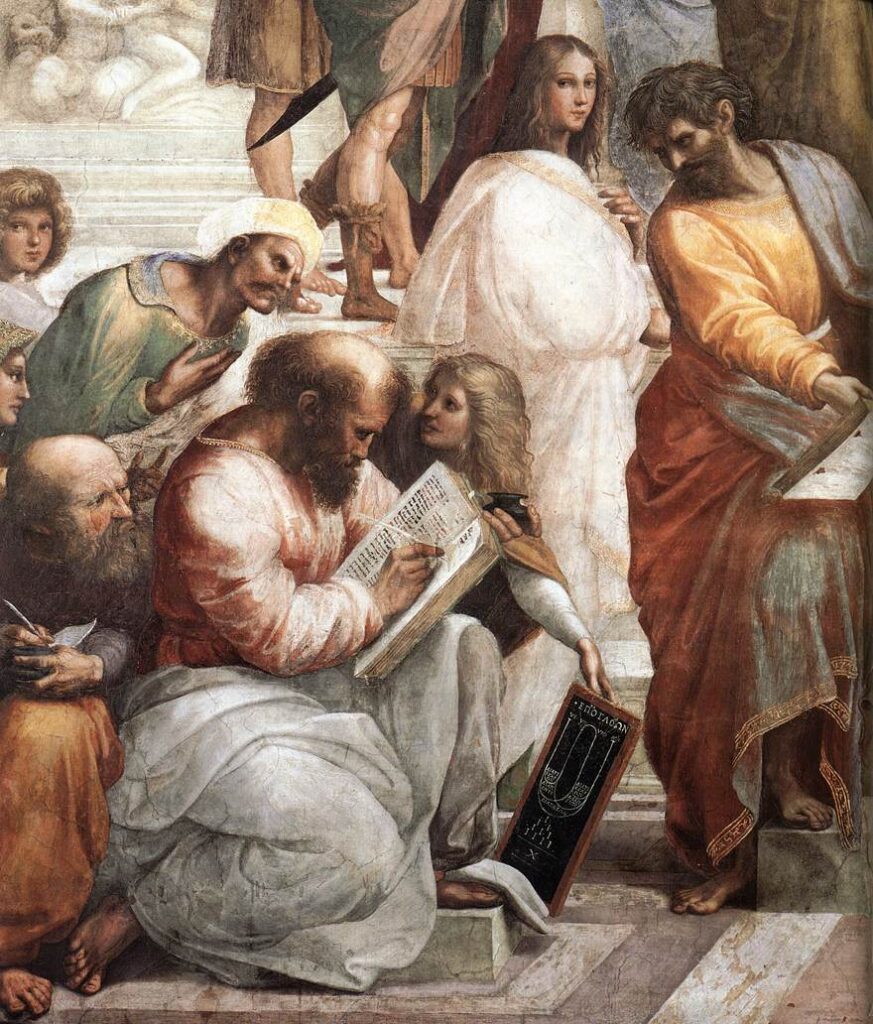
A côté, un peu plus au centre, la figure imposante de Pythagore (N° 22) (que l’historien italien Georgio Vasari méprend pour l’évangéliste saint Matthieu), assis avec un livre, un encrier et un crayon, en train d’écrire entouré de personnes visiblement intriguées.
Derrière lui, assis sur la gauche, un vieillard, représentant Boèce (N° 23), auteur romain, au VIe siècle, d’un traité sur la musique dont la première partie évoque « l’harmonie des sphères », tente de regarder ce qu’il écrit dans son livre. Sans capter un moment de transformation potentielle, comme Léonard savait le faire, la scène s’inspire visiblement de son tableau inachevé, l’Adoration des mages.
A ses pieds, une ardoise noire où figurent aussi bien la fameuse Tetraktys qu’un diagramme des intervalles musicaux (voir chapitre sur Pythagore).
Puisqu’il est impossible qu’il s’agisse d’Averroès (bani de l’église par les Thomistes), l’homme enturbanné qui semble l’admirer pourrait être Avicenne (Ibn Sina) (N° 24). Ce médecin perse, influencé par la pensée aussi bien d’Hippocrate que de Galien, dans son Qanûn (Canon de la médecine), opère une vaste synthèse médico-philosophique de la logique d’Aristote qu’il corrige et un néo-platonisme compatible avec le monothéisme.
Il pourrait également s’agir d’Al Fârâbi (872-950), autre scientifique et musicien arabe qui a cherché réconcilier la foi, la raison et la science avec la philosophie de Platon et d’Aristote dont il avait fait des traductions du grec à l’arabe. Avicenne l’admirait et le titre d’une des oeuvres d’Al Fârâbî ne laisse aucune ambiguïté : « L’Harmonie des opinions des deux sages : Platon le divin et Aristote »
Par ailleurs, vu son positionnement du côté des platoniciens, bien qu’il porte un turban blanc, il est totalement exclu qu’il s’agisse ici d’Averroès ({Ibn Rushd}), auteur terrassé par Thomas d’Aquin (voir les tableaux figurant Le Triomphe de saint Thomas) puis par les néoplatoniciens de Florence pour avoir nié l’immortalité de l’âme individuelle.
Plus au centre de la fresque, deux figures isolées plongées dans leurs pensées. La première, à gauche, semble avoir été ajoutée ultérieurement par Raphaël et ne figure pas sur son dessin. L’homme s’assoupit sur un cube, volume pythagoricien par excellence. Il s’agirait d’Héraclite d’Ephèse (N° 19) (un présocratique ionien pour qui « il n’est de permanent que le changement ») avec les traits de Michel-ange. Ce sculpteur fascina Raphaël, non seulement pour ses dons en dessin, en anatomie et en architecture, mais aussi par son esprit d’indépendance vis-à-vis d’un pape qu’il estimait tyrannique.
Précisons qu’il est admis que si le Moïse, que Michel-Ange a sculpté pour le tombeau de Jules II, jette un regard furieux, c’est que l’artiste à capté le moment où Moïse, en descendant du Mont Sinai avec les Tables de la Loi, constate que le peuple hébreu a recommencé à adorer des idoles, tel « le Veau d’or ». Irrité contre ce retour à l’idolâtrie, Moïse brise alors les Tables de Loi.

Anaximandre de Milet (N° 20) (et non pas Parménide), lui aussi un représentant de l’école ionienne, se dresse derrière Héraclite et semble contester la démonstration de Pythagore (représentant de l’école dite « italienne »). Dans son dos, un jeune homme aux longs cheveux, regarde le spectateur. Vêtu d’une toge blanche, attribut des pythagoriciens, il s’agirait, une fois de plus de Pic de la Mirandole (N° 21), triomphant et entouré de Pythagore et deux de ses disciples. Une légende veut que Raphaël aurait représentée Hypatie d’Alexandrie (v. 370-415), une mathématicienne ayant dirigé l’école néoplatonicienne d’Alexandrie. Lorsqu’un des cardinaux examina le tableau et sut que la femme représentée était Hypatie, il aurait ordonné qu’elle en soit effacée. Raphaël aurait obéi, mais l’aurait remplacée par la figure efféminée d’un neveu du pape Jules II, François Marie Della Rovere, futur duc d’Urbin.
S’il s’agit réellement de Pic de la Mirandole, il s’agirait d’un superbe éloge, car figurant aussi bien dans La Philosophie que dans La Théologie, les deux images de Pic, rappellant l’ange agenouillé qui regarde le spectateur tout en pointant du doigt saint Jean-Baptiste dans La Vierge aux Rochers de Léonard, peuvent se contempler l’une l’autre !
La deuxième figure isolée, étalée nonchalamment sur les escaliers, est le philosophe cynique et hédoniste Diogène de Sinope (N° 18), ici présenté comme un ascète, mais dans la tradition aristotélicienne.
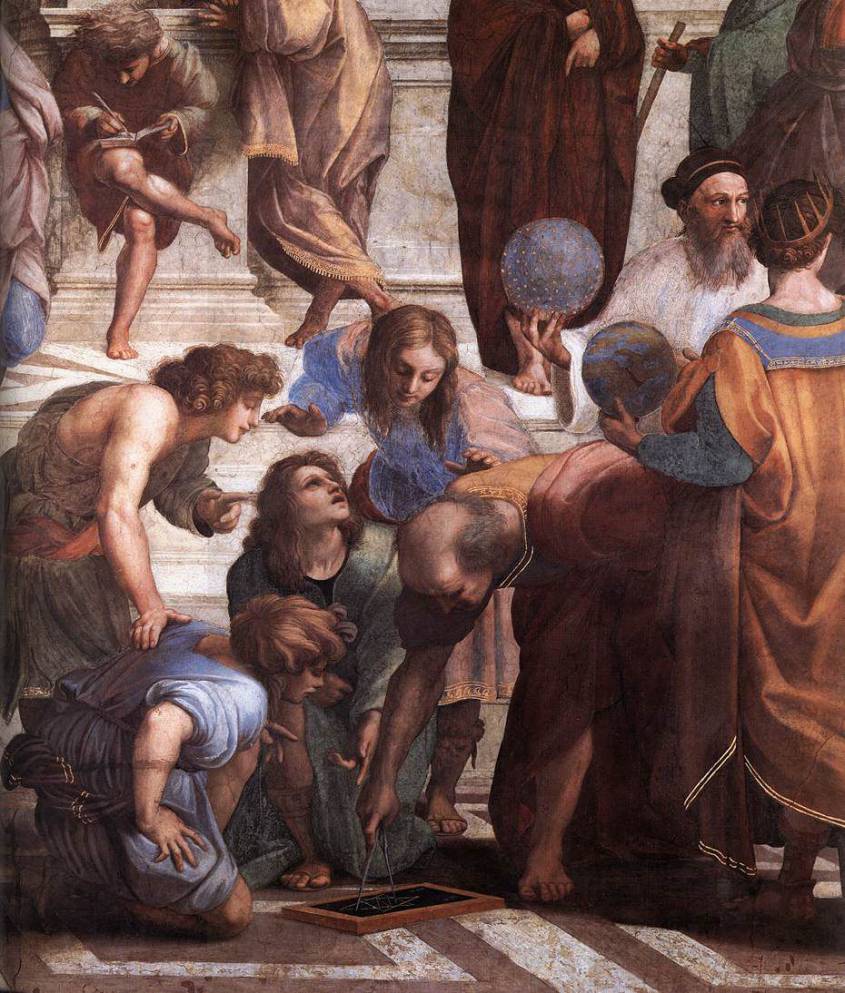

Ensuite, au centre droit, un groupe magnifique de jeunes, ébahis par leurs découvertes et échangeant leurs regards complices avec leurs camarades, autour d’un géomètre qui examine ou trace au compas des lignes parallèles à l’intérieur d’une étoile hexagonale sur une ardoise posée par terre. Il s’agit de l’illustration d’un théorème dont ne parlent ni Euclide (un aristotélicien), ni Archimède, alors que l’on attribue l’identité de l’un ou de l’autre à cette figure sous les traits de l’architecte Donato Bramante.
Il pourrait s’agir, c’est ma conviction, du géomètre Hippocrate de Chios (N° 17) dont parle Aristote en grand bien. Il a écrit le premier manuel de mathématiques, intitulé Les éléments de la géométrie. Ce travail précède d’un siècle les Éléments d’Euclide. A moins qu’il ne s’agisse de l’architecte Leon Battista Alberti, dont l’église de Mantoue a pu inspirer le Bramante et après tout, auteur, en 1935, de De Pictura, un traité (d’esprit aristotélicien) sur la perspective.
Cependant, en 1485, dans son traité sur l’architecture De re Aedificatoria, Alberti, dans un passage (IX, 5) qui a pu intéresser l’auteur de la fresque, souligna que :
La beauté consiste dans une harmonie et dans un accord des parties avec le tout, conformément à des déterminations de nombre, de proportionnalité et d’ordre telles que l’exige l’harmonie, c’est à dire la loi absolue et souveraine de la nature.

c’est-à-dire, en français : « De la main de Raphaël d’Urbino »).
Enfin, pour ajouter au mystère, on peut lire sur le col de la tunique de cette figure : « R.V.S.M. » (Raphael Vrbinas Sua Manu, c’est-à-dire, en français : « De la main de Raphaël d’Urbino »).
Car, ce qu’aborde le géomètre sur l’ardoise, c’est le rôle que jouent les diagonales de l’hexagone. La réponse est fournie par le tracé géométrique, sous forme d’un hexagone, qui sous-tend la construction de la perspective de la fresque. Les diagonales y font apparaître une belle complémentarité entre la moyenne arithmétique et la moyenne harmonique (voir infographie). C’est une démonstration magistrale dans le domaine du visible, du concept structurant toute la thématique de l’œuvre : la complémentarité, fondement de l’harmonie universelle.

A droite, les géographes Ptolémée (N° 16) et Strabon (N° 15) (avec les traits de Baldassare Castiglione un ami de Raphaël ?) que l’on identifie sans réelles preuves à Zoroastre mais auquel en effet se réfère Pic de la Mirandole, se retrouvent face à face. Le premier montre la terre comme une sphère, le deuxième arbore un globe céleste.
Enfin, à l’extrême droite du premier registre, avec les traits de Raphaël, le peintre légendaire de la cour d’Alexandre le Grand, Appelles de Cos (N° 13). Rappelons que, de son vivant, Raphaël fut surnommé « l’Appelles de son temps ». A côté, son rival, le peintre grec Protogène (N° 14) sous les traits du collègue de Raphaël, le sulfureux mais virtuose fresquiste Sodoma. Venus du monde des artisans, il s’agit ici de marquer l’entrée de deux peintres-décorateurs dans « la cour des grands » et faisant leurs premiers pas dans le monde de la philosophie.

Sur le parvis, le sujet central, comme nous l’avons dit, Platon et Aristote. Les traits de Platon dans la fresque n’ont rien à voir avec un quelconque portrait supposé de Léonard de Vinci. Né en 1452, ce dernier n’avait que 56 ans lors de la réalisation de la fresque. Raphaël se serait servi de l’image d’un buste de Platon découvert à Athènes dans les ruines de l’ancienne académie.
Dans l’attroupement à gauche de Platon, se trouve Socrate (N° 6), son maître à penser dont tout le monde connaissait le visage, grâce à des statues romaines. L’identification des autres figures reste largement hypothétique. On pense aux orateurs des dialogues de Platon. Proche de Socrate, son vieil ami Criton (N° 4). Derrière Socrate, l’intellectuel athénien Isocrate (N° 7) qui s’était retiré de la vie politique et bien que proche de Socrate, s’érigeait en rival de Platon. Proche de ce dernier, les cinq interlocuteurs du dialogue de Platon, le Parménide. Parmi eux, Parménide (N° 8), considéré à l’origine du concept de l’Un et du multiple, et le penseur présocratique Zénon d’Elée, réputé pour ses paradoxes philosophiques.
On évoque également le général athénien (ici habillé en soldat romain) Alcibiade (N° 3) et le jeune vétus de bleu pourrait être Phédon d’Elis (N° 5) ou Xénophon, écoutant tout deux un Socrate comptant sur ses doigts, un geste suggérant sa fameuse dialectique.
Tout autoir des penseurs grecs, d’autres figures s’agitent. Derrière Alcibiade, un personnage (peut-être un bibliothécaire) retient un autre personnage en train de courir, le priant d’éviter de déranger les échanges en cours entre philosophes et scientifiques.
A l’extrême gauche, un homme avec un chapeau entre sur scène. Il pourrait s’agir de Plotin (N° 2), une figure fondatrice du néoplatonisme admirée par Bessarion, accompagné de Porphyre (N° 1), un autre néoplatonicien qui apporta sa biographie de Pythagore en messager de l’ancien monde.
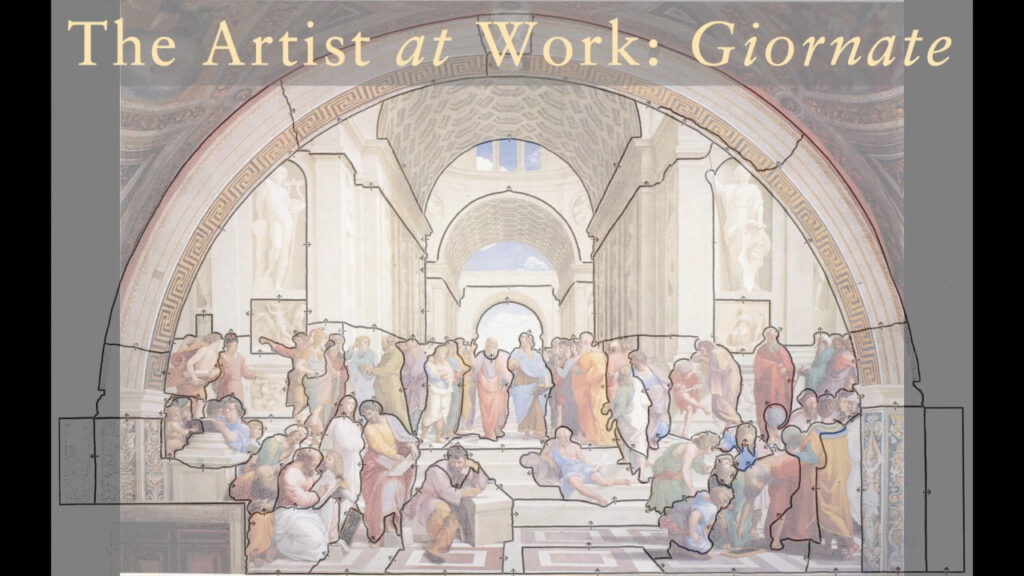
Ici les giornata de l’Ecole d’Athènes.
D. LA JUSTICE

A. La Fortitude, B. La Prudence et C. Tempérance.
1. Justinien, 2. Tribonien, 3. Le pape Paul III, 4. Antonio Del Monte, 5. Le pape Léon X, 6. Le pape Grégoire IX, 7. Le pape Clément VII.
En haut, dans la lunette, les trois vertus représentées seraient la Fortitude (A), la Prudence (B) et la Tempérance (C). Avec la Justice, elles constituent les quatre vertus cardinales (profanes). La figure féminine centrale, qui tient un miroir, désigne la Prudence. A gauche, la Fortitude tient dans ses mains une branche de chêne, allusion à la famille della Rovere de laquelle était issue Jules II, le pape commanditaire de ces fresques.
En dessous, une fois de plus la complémentarité est à l’œuvre. A gauche, peint par Lorenzo Lotto, l’empereur romain Justinien (N° 1) reçoit les Pandectes (la loi civile) du juriste byzantin Tribonien (N° 2).
A droite, en pendant, sous les traits de Jules II, le pape Grégoire IX (N° 6) promulgue les Décrétales ; somme magistrale de droit canonique dont il avait ordonné la compilation raisonnée et dont il ordonna la publication en 1234.
A sa droite (donc à la gauche du spectateur), on voit un cardinal, en robe violette, ayant les traits du cardinal Jean de Médicis, futur pape Léon X (N° 5). Les deux autres cardinaux derrière lui seraient Alessandro Farnese, le futur pape Paul III (N° 3), et Antonio Del Monte (N° 4). Et à sa gauche (à droite pour le spectateur) un cardinal représentant du cardinal Jules de Médicis, le futur pape Clément VII (N° 7). Avec votre image immortalisée sur une fresque située au bon endroit, votre carrière pour finir pape semblerait mieux engagée !
Le fait que Jules II soit représenté portant la barbe permet de dater la fresque au-delà de juin 1511. En effet le pontife, parti de Rome imberbe pour faire la guerre, laissa ensuite pousser sa barbe et fit le vœu de ne pas la raser avant d’avoir libéré l’Italie.
Or il revint à Rome en juin. Les historiens soulignent que la mise en avant du portrait du pape indique comment le thème de la décoration des Chambres se transforma, vers 1511, en celui de la glorification de la papauté. La Justice devient ainsi le droit de Jules II d’imposer « sa » justice.
E. LA POESIE
(LE PARNASSE)

Les poètes :
1. Alcée de Mytilène, 2. Corinna, 3. Pétrarque, 4. Anacréon, 5. Sappho, 6. Ennius, 7. Dante, 8. Homère, 9. Virigile, 10. Stace, 11. Apollon, 12. Tebaldeo, 13. Bocace, 14. Tibulle, 15. L’Arioste, 16. Properce, 17. Ovide, 18. Sannzaro, 19. Pindare.
Les neufs muses :
A. Thalie, B. Clio, C. Euterpe, D. Calliope, E. Polymnie, F. Melpomène, G. Terpsichore, H. Uranie, I. Erato.
Une fenêtre réduit l’espace disponible pour la fresque à une grande lunette ou les personnages sont répartis en petits groupes sur une ligne en demi-cercle.
L’idée sous-jacente ici, prise de saint Thomas, c’est que la vérité se rend accessible à l’homme, soit par la Révélation (Théologie), soit par la Raison (Philosophie). Pour l’école néoplatonicienne, cette vérité se manifeste à nos sens en passant par le Beau (poésie et musique).
La scène peinte ici se déroule près de Delphes, au sommet du Parnasse, la montagne sacrée d’Apollon et demeure des Muses de la mythologie grecque.
La grande fenêtre autour de laquelle s’organise la fresque offre une vue, au-delà du cortile (petit temple circulaire) du Bramante, sur la colline du Belvédère (le mons Vaticanus), où l’on donnait des spectacles et où, dans l’Antiquité, on honorait Apollon, ce qui lui valait le nom d’Apolinis.
Apollon est le patron des musiciens : « c’est par les Muses et l’archer Apollon qu’il est des chanteurs et des citharistes », dit Hésiode. Il inspire même la nature : à son passage « chantent les rossignols, les hirondelles et les cigales ». Sa musique apaise les animaux sauvages et meut les pierres. Pour les Grecs, musique et danse ne sont pas seulement des divertissements : elles permettent de guérir les hommes en accordant les discordances qui rongent leur âme et donc de supporter la misère de leur condition.
Au sommet de la colline, sept lauriers. Près de la source Castalia, Apollon (N° 11), couronné de feuilles lauriers et au centre de la composition, accorde autour de lui les neufs muses (A à I) en jouant sur sa lyre. Sur le côté gauche Calliope (D), celle « qui a une belle voix » et représente la poésie épique, et à droite, Erato (I), « L’aimable » qui représente la poésie lyrique et érotique ainsi que le chant nuptial. Chacune préside à accorder le chœur de l’autre : à gauche derrière Calliope, Thalie (A)(« la florissante, l’abondante »), Clio (B) (« qui est célèbre » et représente l’histoire) et Euterpe (C) (« la toute réjouissante » qui représente la musique). Enfin, juste derrière Erato, Polymnie (E) (« celle qui dit de nombreux hymnes » et représente la rhétorique, l’éloquence et la pantomime), Melpomène (F) (« la chanteuse » qui représente la tragédie et le chant) ; Terpsichore (G) (« la danseuse de charme » ) et Uranie (H) (« la céleste » qui représente l’astronomie).
Et point n’est besoin d’être Pythagore pour compter 7 lauriers sur la montagne et se rappeler que neuf muses plus Apollon font… dix.
Comme le rappelle une des fresques carrées du plafond, Apollon avait triomphé sur Marsyas dans un combat pour s’emparer de la lyre, considérée comme l’instrument divin capable de conduire les âmes au ciel, mieux que la flûte qui n’excite que les basses passions. En détachant l’homme de ses préoccupations matérielles immédiates, la lyre victorieuse permettait de susciter l’amour divin chez les hommes. A cela s’ajoute que chez les Romains, on connaissait une lyre à sept cordes, un héritage pythagoricien, le chiffre sept faisant référence aux sept corps célestes orbitant autour du feu central.
Pour les pythagoriciens et également Héraclite, l’imitation de « l’harmonie des sphères », grâce aux harmonies produites par les sept cordes, permet la purification des âmes.


Cependant, étrangement, Apollon ne tient pas en main une lyre traditionnelle à quatre cordes, mais une lira da braccio (lire à bras). Si Apollon joue ici de la lyre à bras, les muses Calliope, Erato et la sybille Sapho tiennent des lyres identiques à celles du sarcophage dit « des Muses » du Museo delle Terme à Rome.
Dans de nombreuses représentations du XVIe siècle, la lyre à bras est jouée par un ensemble d’anges ou par des personnages mythologiques, tels Orphée et Apollon, mais aussi le roi David, Homère ou des Muses. Parmi ses interprètes, l’on compte notamment Léonard de Vinci, considéré comme le doyen parmi les artistes interprètes de la lire à bras.
L’instrument se dessine essentiellement comme un violon, mais avec une touche plus large et un chevalet plat qui permet un jeu en accords. La lyre est dotée généralement de sept cordes : quatre comme un violon, augmentées d’une corde grave supplémentaire (ce qui fait cinq) et deux cordes passant au-delà de la touche, qui ne sont pas jouées mais servent de bourdon et résonnent à l’octave.
Or, Raphaël, pour créer une harmonie parfaite avec le nombre des muses autour d’Apollon, va faire passer le nombre de cordes de sept à neuf, c’est-à-dire sept ajustables plus deux bourdons.
Ce détail concernant la lyre nous semble avoir été modifiée dans le temps. En effet, une reproduction gravée, de 1517, sans doute à partir de dessins antérieurs à la fresque, ou de son avant projet, par Marcantonio Raimondi, révèle un état bien différent de ce que l’on voit aujourd’hui.
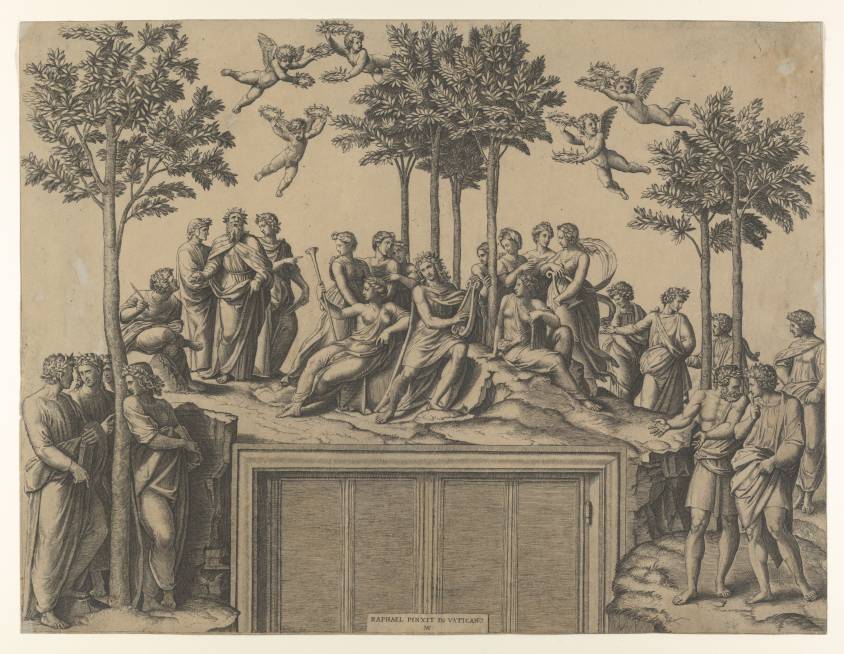
La composition est moins dense et met en valeur, comme l’Ecole d’Athènes, plusieurs groupes de trois personnages chacun. Ce qui frappe d’abord, c’est que la lyre ancienne dont joue Apollon repose sur sa cuisse, alors que dans la version actuelle, Apollon, un fait vibrer les cordes de sa lira da braccio avec un archet, tout en regardant vers le ciel, en accord avec la fresque du plafond où sont inscrits des paroles de Virgile : « Insufflé par l’esprit » (NVMINE AFFLATVR).
Tout autour, dix-huit poètes sont divisés en plusieurs groupes L’identification de certains est sans équivoque, celle d’autres plus douteuses. Ils sont tous enchaînés les uns aux autres par des gestes et des regards, en formant une sorte de croissant continu.
En haut à gauche, le père de la poésie latine Ennius (N° 6), assis, écoute ravi le chant d’Homère (N° 8), tandis que Dante (N° 7), plus en arrière regarde Virgile (N° 9) qui se retourne vers lui, le poète romain Stace (N° 10), sous les traits d’Ange Politien, à ses côtés. Ce dernier était un disciple du néoplatonicien Marsile Ficin. Pour représenter les figures historiques, Raphaël s’inspira de la statuaire romaine. Ainsi, pour le visage d’Homère, il a repris l’expression dramatique du Laocoon retrouvé quelques années auparavant, en 1506, à Rome.
En bas à gauche se trouvent le poète grec Alcée de Mytilène (N°1), la poétesse grecque Corinna (N° 2), Pétrarque (N° 3) ainsi que le poète grec Anacréon (N° 4). Dans la version finale, deux personnages qui sortent du cadre sont venus enrichir la composition. A gauche, la sibylle Sappho (N° 5) comme l’indique une tablette. Considérée comme la première poétesse de la Grèce antique, elle a vécu aux VIIe et VIe siècle av. JC. D’après les Hymnes homériques, c’est elle qui aurait construit la première lyre afin d’accompagner la récitation poétique. Unique femme dans l’ensemble de la « Chambre de la signature » elle est peinte avec une monumentalité qui n’est pas sans rappeler celle de Michel-Ange dans la chapelle Sixtine.
Sappho fait le pendant à Pindare (N° 19), et non pas Horace comme on le prétend, considéré comme l’un des plus grands poètes lyriques de la Grèce et pour qui Apollon était le symbole de la civilisation. Pindar est ici en conversation avec le poète italien Jacopo Sannazaro (N° 18), habillé en bleu et debout, et au-dessus d’eux Ovide (N° 17).
A droite, sur le flanc du mont, outre Pindare, Sannazaro et Ovide, cinq autres poètes et orateurs : Antonio Tebaldeo (N° 12), le dos tourné vers Apollon et sous les traits de Baldassare Castiglione ?), Bocace (N° 13), derrière, Tibulle (N° 14), Ludovico Ariosto (N° 15), Properce (N° 16), sous les traits du cardinal poète très « pétrarquiste » Pietro Bembo, un ami d’Inghirami et ennemi d’Erasme, et à ses côtés deux poètes inconnus dits « poètes du futur jugeant le passé ».
L’identification de ces personnages reste largement hypothétique et controversée. Pour arriver à des résultats satisfaisants, il faudrait selon l’historien Albert Chastel, trouver des correspondances précises entre les neuf muses, neuf poètes classiques et neuf modernes, outre le groupement par genre poétique.
Après la mort de Jules II, le pape Léon X fera de la « Chambre de la signature » son salon de musique, remplaçant les livres de son prédécesseur (qui seront déménagés vers la grande bibliothèque de l’étage inférieur) par des intarsiae. Léon X fera également achever le pavement.
F. LA MOSAIQUE AU SOL

A. Armoiries du pape, B. Bras spiralé, C. Etoile de David, référence à l’héritage juif.
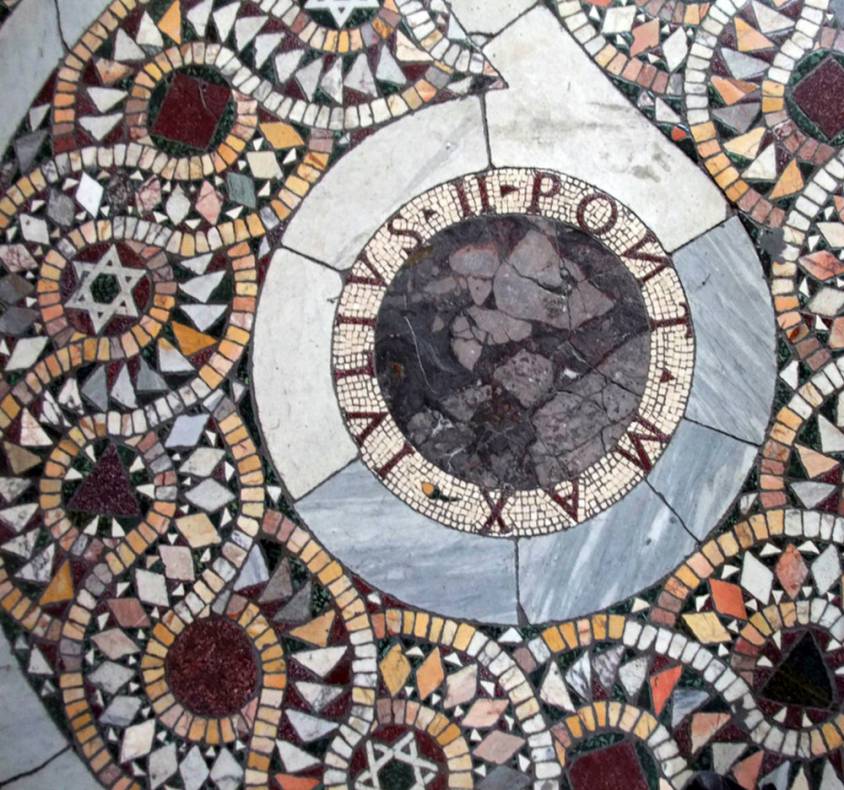
La mosaïque de la « Chambre de la signature » se dit « cosmatesque », d’après le nom des Cosmati, une vieille famille d’artisans et spécialisée dans les mosaïques à quatre couleurs. Certains matériaux proviennent des ruines romaines, le marbre vert du Péloponnèse en Grèce, le porphyre d’Assouan en Egypte, et le marbre jaune d’Afrique du Nord. Le marbre blanc, est originaire des fameuses carrières de marbre de Carrare où Michel-Ange choisissait ses matériaux.
Comme au plafond, au centre de la pièce les armoiries du pape (A), cette fois-ci à l’intérieur d’un carré (son règne terrestre) inscrit dans un cercle (sa mission théologique). Ce premier cercle est entouré de quatre bras spirales qui engendrent chacun un nouveau motif circulaire (B). Ce motif serait d’origine juive. L’étoile de David (C) apparaît à plusieurs reprises dans ce tourbillon créationnel. La doctrine des quatre mondes, décrite dans la cosmologie cabalistique souligne leur unité dynamique.
Après tout, pour Gilles de Viterbe, la découverte récente à l’époque des écrits mystiques juifs relevait de la même importance que la découverte de l’Amérique par Christophe Collomb. Rappelons que pour Jules II, tout comme Platon et Pythagore, Moïse, que Michel-ange sculpte pour son tombeau, annonçait déjà le triomphe ultérieur de l’Église de Rome qui en fera, sous sa direction, la synthèse.
Conclusion
Ainsi, toute la thématique de la « Chambre de la signature » trouve sa pleine cohérence avec l’idée de l’harmonie et de la concordance
Mais lorsqu’on y regarde de plus près, l’on constate qu’il ne s’agit que d’une « complémentarité » au niveau des formes et au service d’un pouvoir temporel déguisé en mission divine. Raphaël, un peintre talentueux, s’y est soumis en fournissant le produit pour lequel on le payait. Il peindra des choses bien pire en se soumettant aux caprices païens du banquier de la papauté Agostino Chigi pour la décoration de sa villa, la Farnesine.
Avec la « Chambre de la signature », on est donc très loin de cette fameuse « coïncidence des opposés » chère à Pythagore, Platon et Nicolas de Cues, qui permet, dans une recherche sans concession de la vérité et par amour de l’humanité, de dépasser les paradoxes et de résoudre un grand nombre de problèmes à partir d’un point de vue supérieur.
En empilant les allégories et les symboles, si elle impressionne, cette œuvre magistrale finit par nous étouffer. Par les règles de sa composition, elle ne peut que sombrer dans le théâtrale et le didactique. Dans un univers purgé de la moindre ironie ou surprise, aucune vraie métaphore saura nous éveiller. Et bien que Raphaël a tenté d’y amener un peu de vie, le spectateur se retrouve fatalement avec un vaste sédiment d’idées fossilisées, aussi mortes que les plus glorieuses ruines de l’Empire romain.
Bibliographie sommaire :
- Jules II, Ivan Cloulas, Fayard, Paris 1990 ;
- Léon X et son siècle, Gonzague Truc, Grasset, Paris, 1941 ;
- Une histoire des empires maritimes, Cyrille P. Coutensais, CNRS, 2013 ;
- L’Humanisme, l’Europe de la Renaissance, André Chastel et Robert Klein, Editions Skira, Genève, 1995 ;
- L’Arétin ou l’insolence du plaisir, Bertrand Levergeois, Fayard, Paris, 1999 ;
- Giorgio Vasari, l’homme des Médicis, Grasset, Paris, 1995 ;
- Marsile Ficin et l’Art, André Chastel, Droz, Genève, 1996 ;
- Raphael and the Pope’s librarian, Nathaniel Silver, Ingrid Rowland, Paul Holberton Publishing, 2019 ;
- Raphael’s Stanza della Signatura, Meaning and Invention, Christiane L. Joost-Gaugier, Cambridge University Press, 2002 ;
- Pythagoras and Renaissance Europe, Finding Heaven, Christiane L. Joost-Gaugier, Cambridge University Press, 2009 ;
- Raphaël, Stephanie Buck et Peter Hohenstatt, Könemann, 1998 ;
- The Intellectual Background of the School of Athens : Tracking Divine Wisdom in the Rome of Julius II, Ingrid D. Rowland, 1996 ;
- Pagans in the Church : The School of Athens in Religious Contex, Timothy Verdon, 1996 ;
- Raphael’s School of Athens, Marcia Hall, Cambridge University Press, 1997 ;
- Raphaël, Konrad Oberhuber, Editions du Regard, Paris, 1999 ;
- L’énigme de la Segnatura, Raphaël et Sodoma, André-Charles Coppier, Paris, 1928 ;
- Raphael, John Pope-Hennessy, Harper & Row, Londres, 1970 ;
- Qui était Raphaël, Nello Ponente, Editions Skira, Genève, 1967 :
- Vies et doctrines des philosophes illustres, Diogène Laërce, La pochothèque, Paris, 1999 ;
- Erasme et l’Italie, Augustin Renaudet, Editions Droz, Paris, 2000 ;
- Erasme parmi nous, Léon Halkin, Fayard, 1987 ;
- Comment la folie d’Erasme sauva notre civilisation, Karel Vereycken, 2005 ;
- L’oeuf sans ombre de Piero della Francesca, Karel Vereycken, 2007 ;
- Albrecht Dürer contre la mélancolie néo-platonicienne, Karel Vereycken, 2007.
NOTES:
*Pour un traitement approfondi du sujet, voir Karel Vereycken, Albrecht Dürer contre la Melancolie néo-platonicienne, 2007.
**L’on voit bien ici d’où certaines sectes, notamment les Anthroposophes de Rudolf Steiner, tirent leur inspiration. Certains s’acharnent encore à vouloir démontrer que Pythagore, croyant en la transmigration des âmes et donc leur réincarnation éventuelle dans des animaux ou des plantes, était un végétarien. Diogène Laërce raconte qu’un jour, « passant près de quelqu’un qui maltraitait son chien, on raconte qu’il [Pythagore, sur le ton de la blague] fut pris de compassion et qu’il adressa à l’individu ces paroles :’Arrête et ne frappe plus, car c’est l’âme d’un homme qui était mon ami, et je l’ai reconnu en entendant le son de sa voix’ ». Toute une série d’auteurs finiront par tomber dans la numérologie et l’ésotérisme irrationnel, en particulier Francesco Zorzi, Agrippa de Nettesheim ou encore Paracelse.
